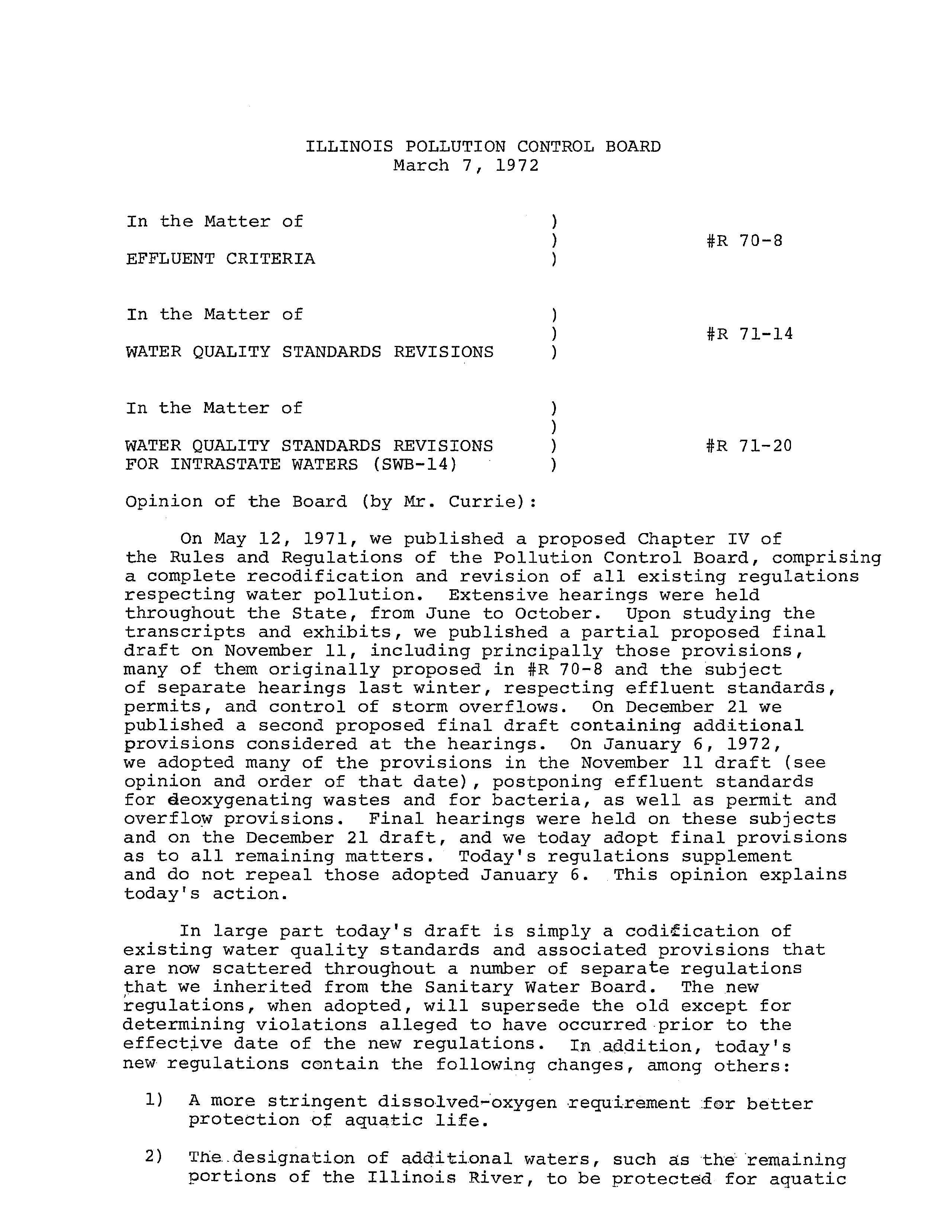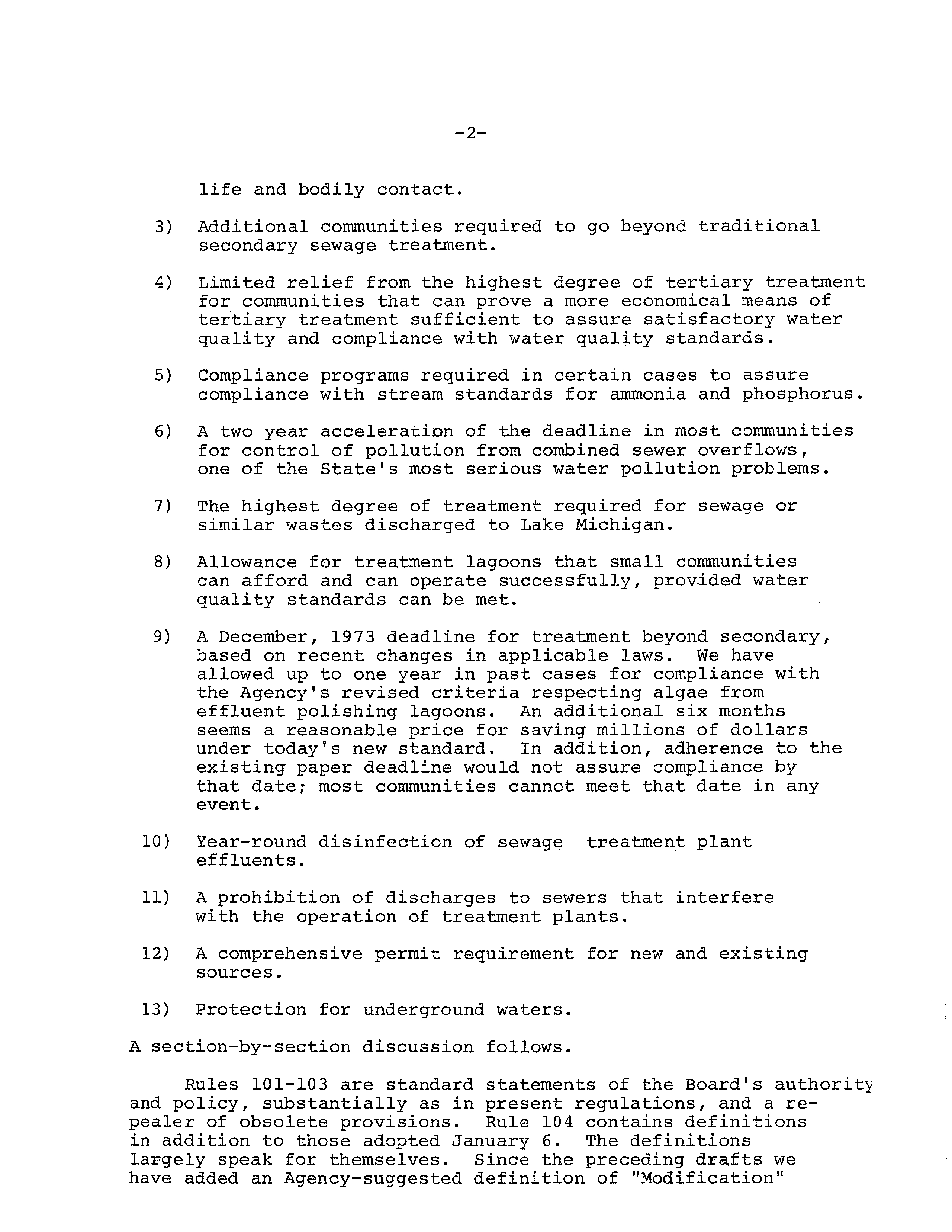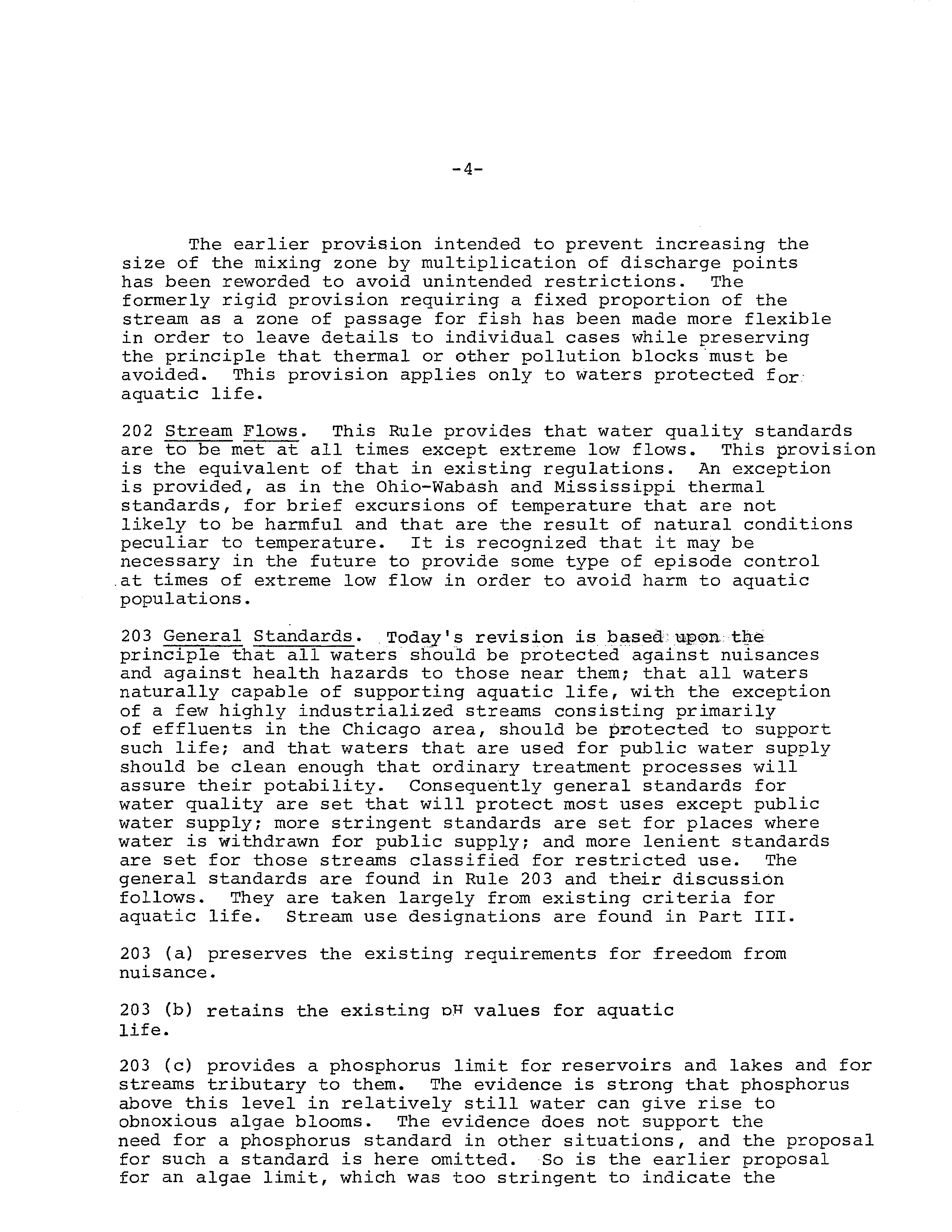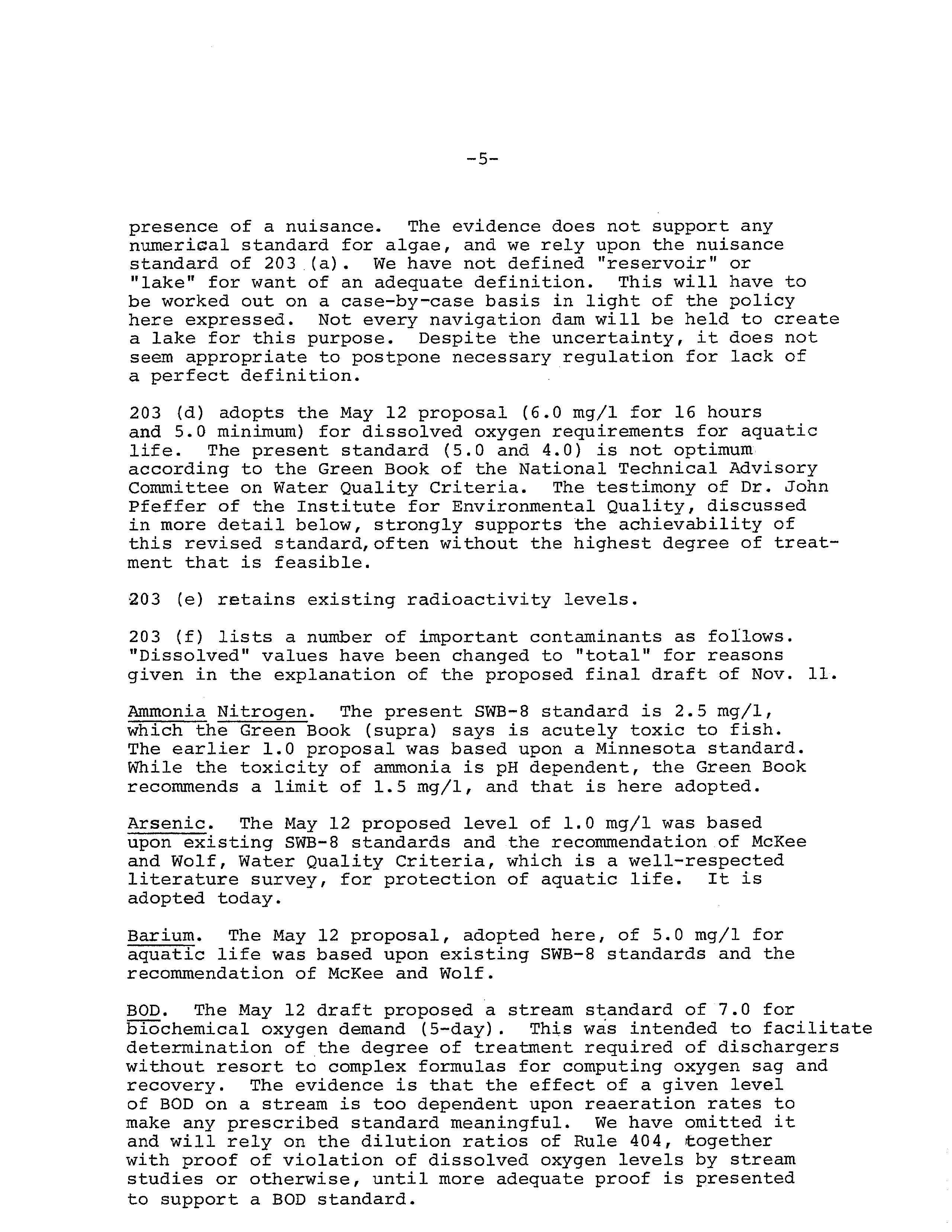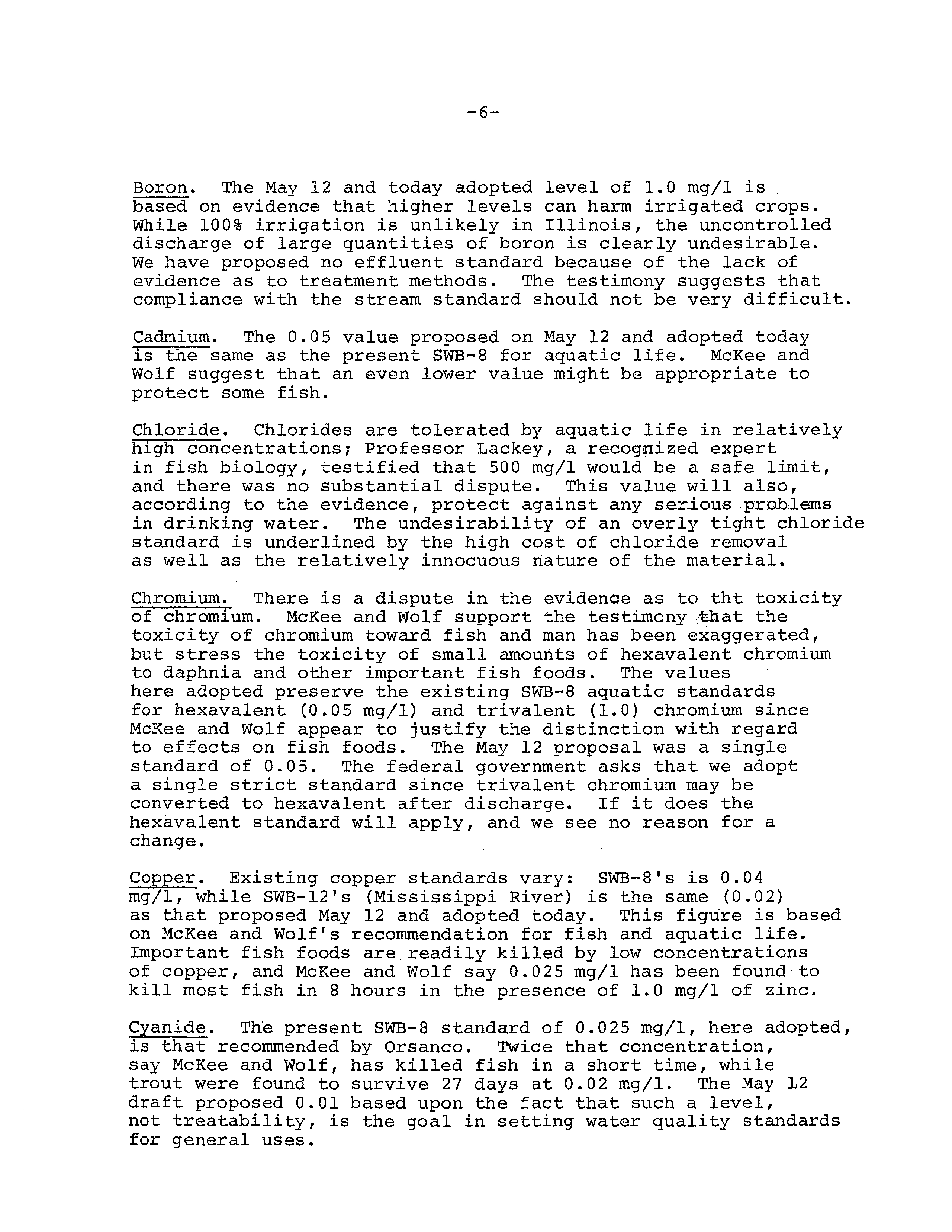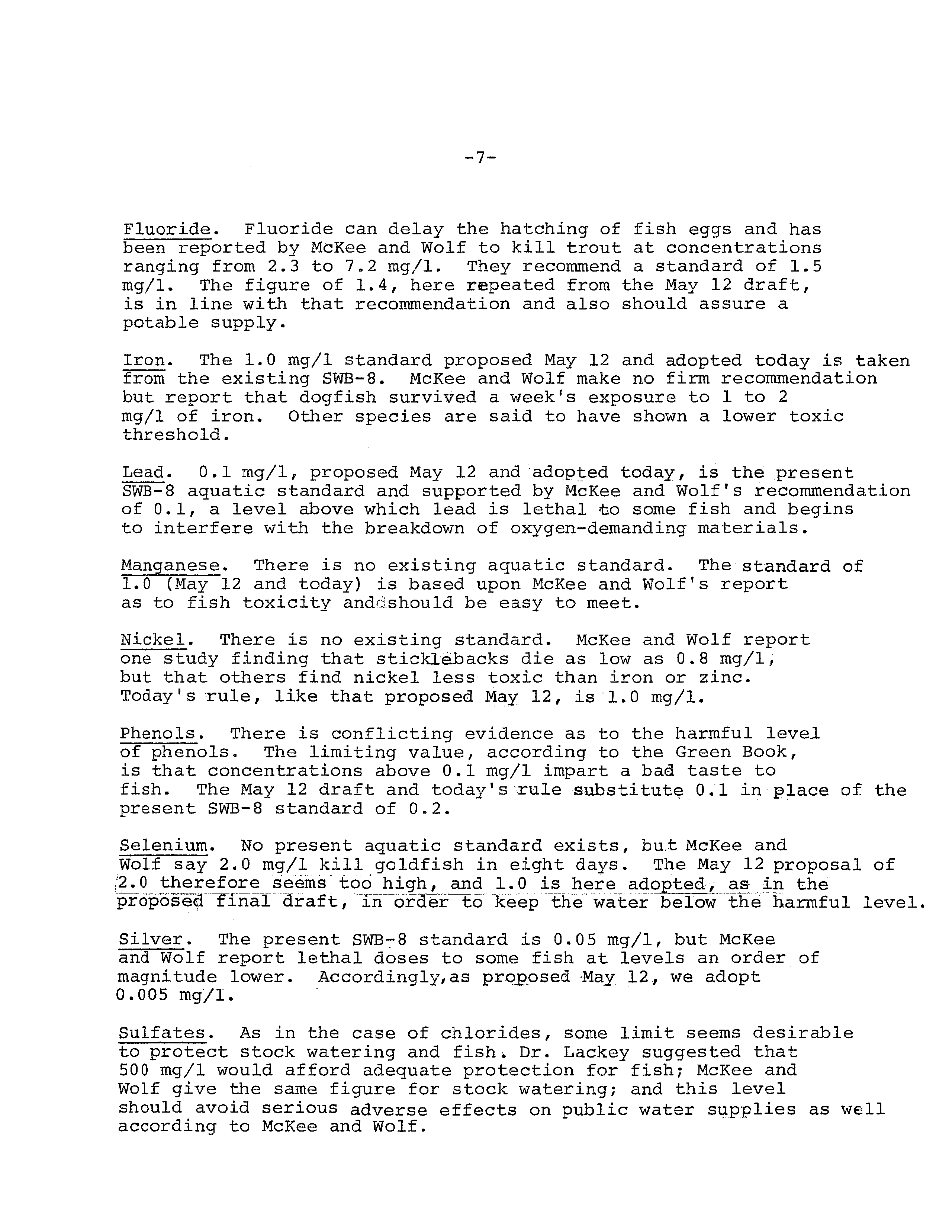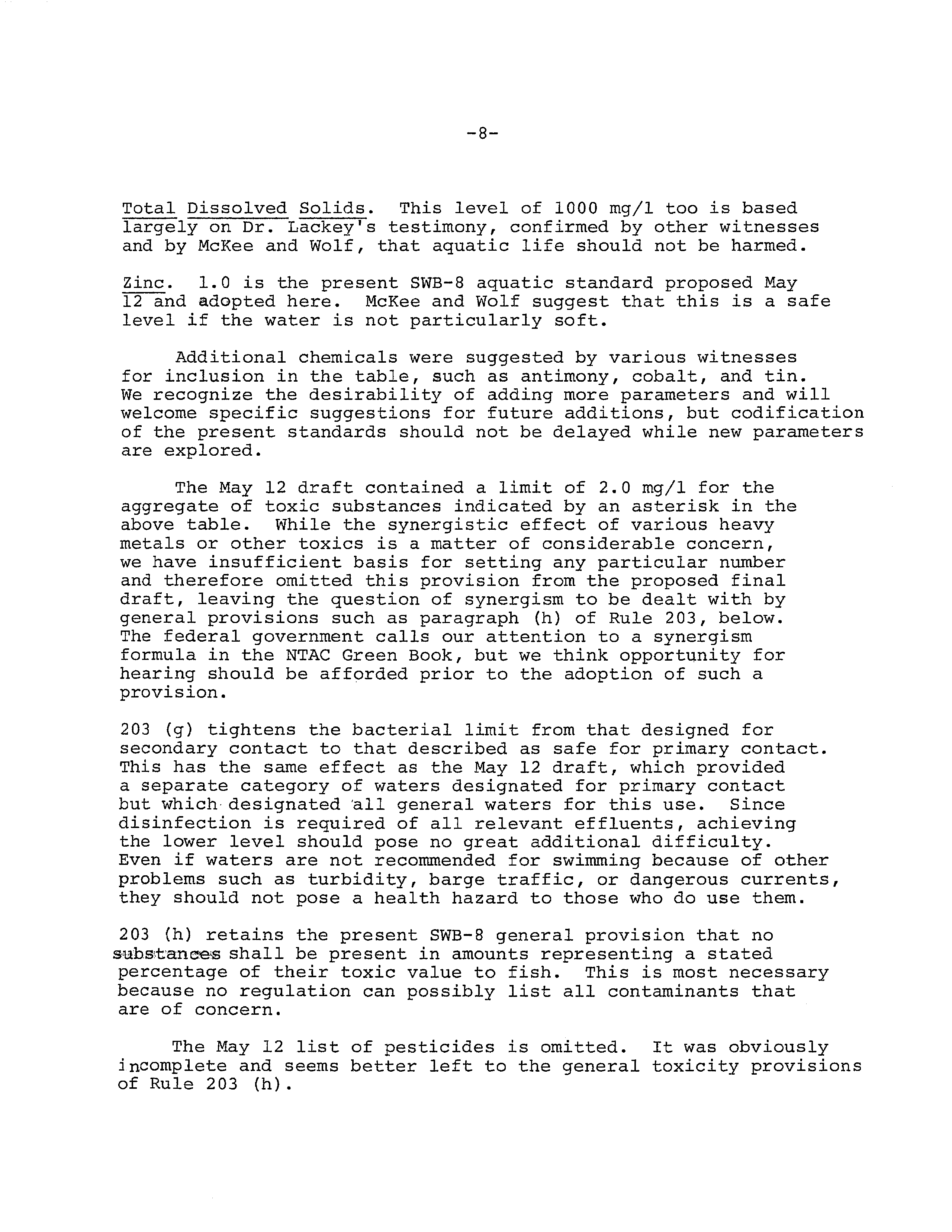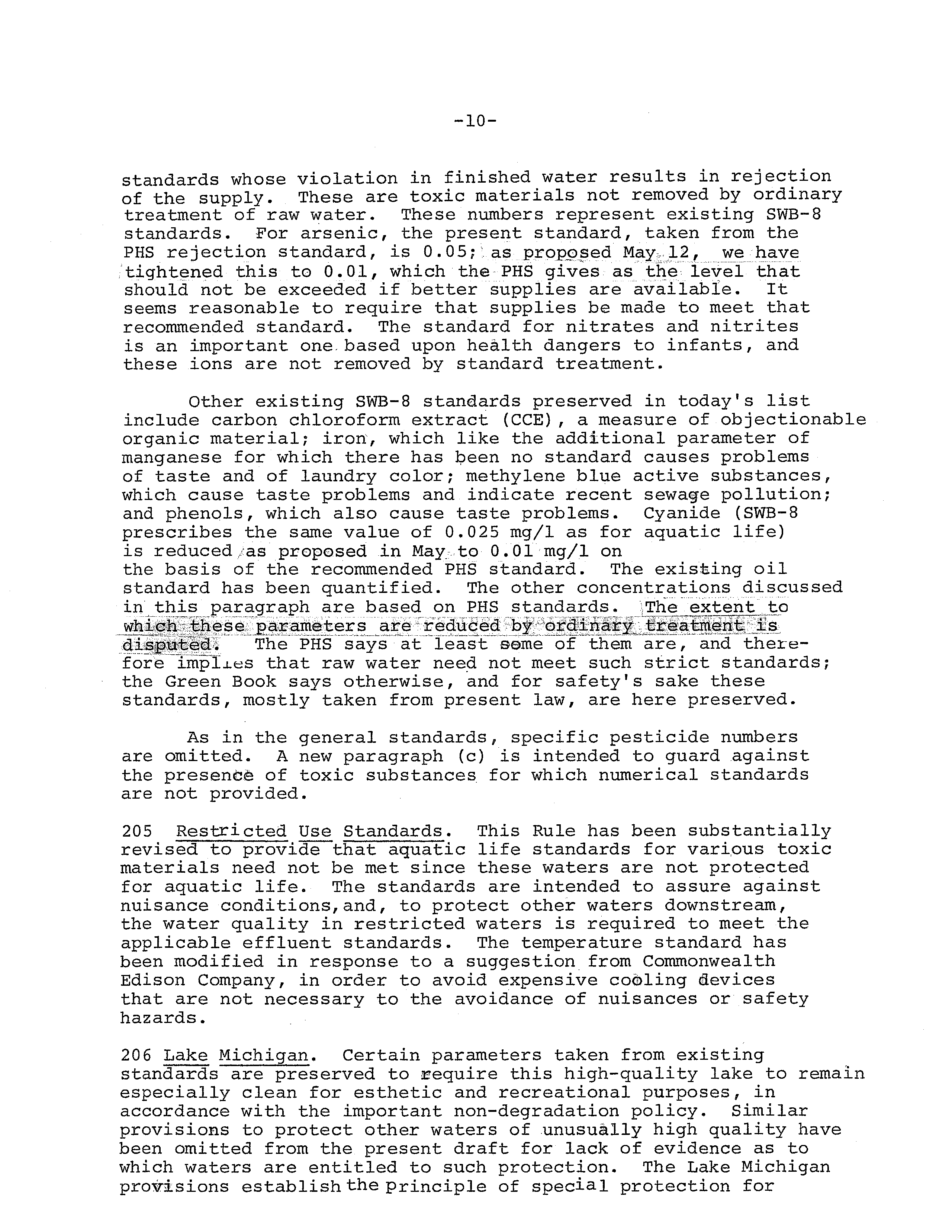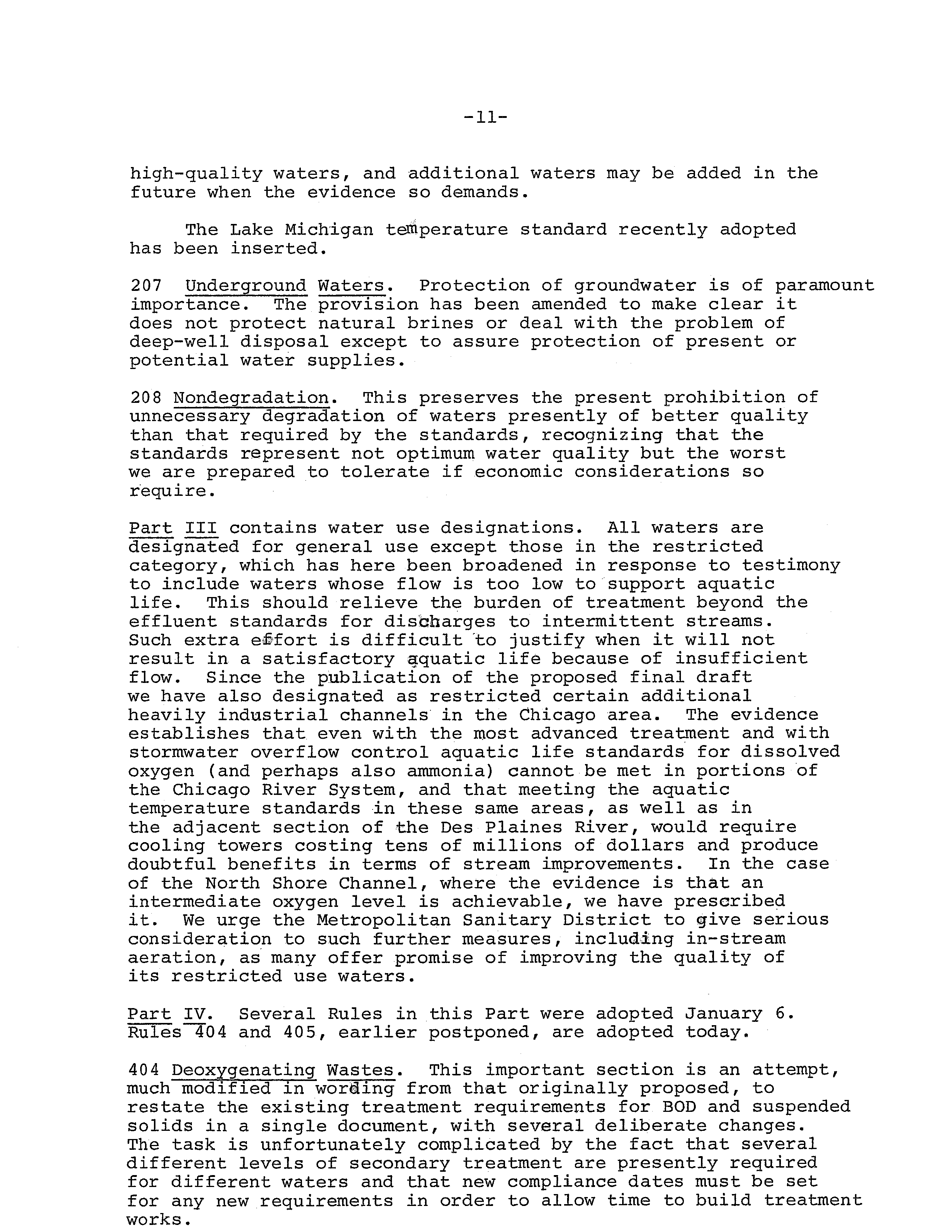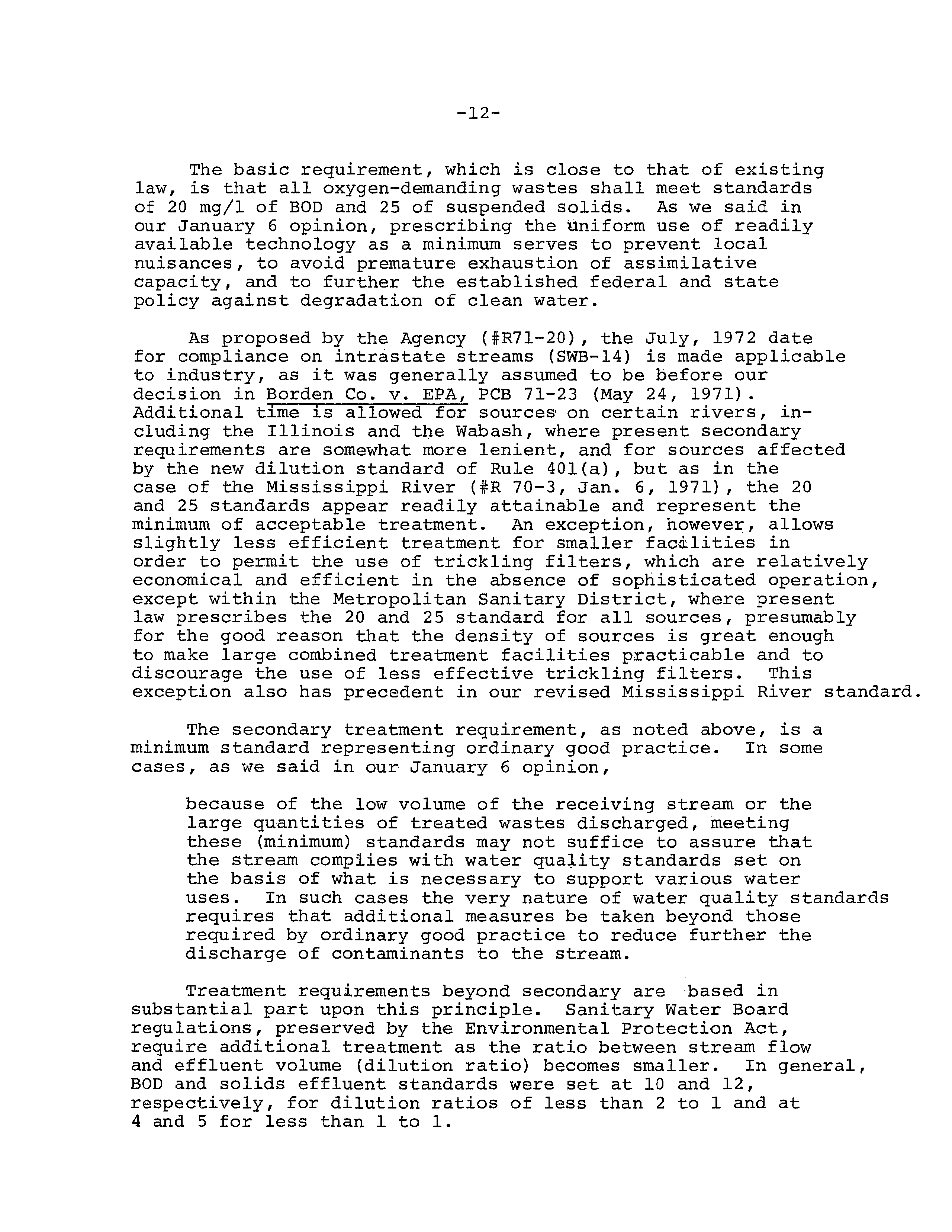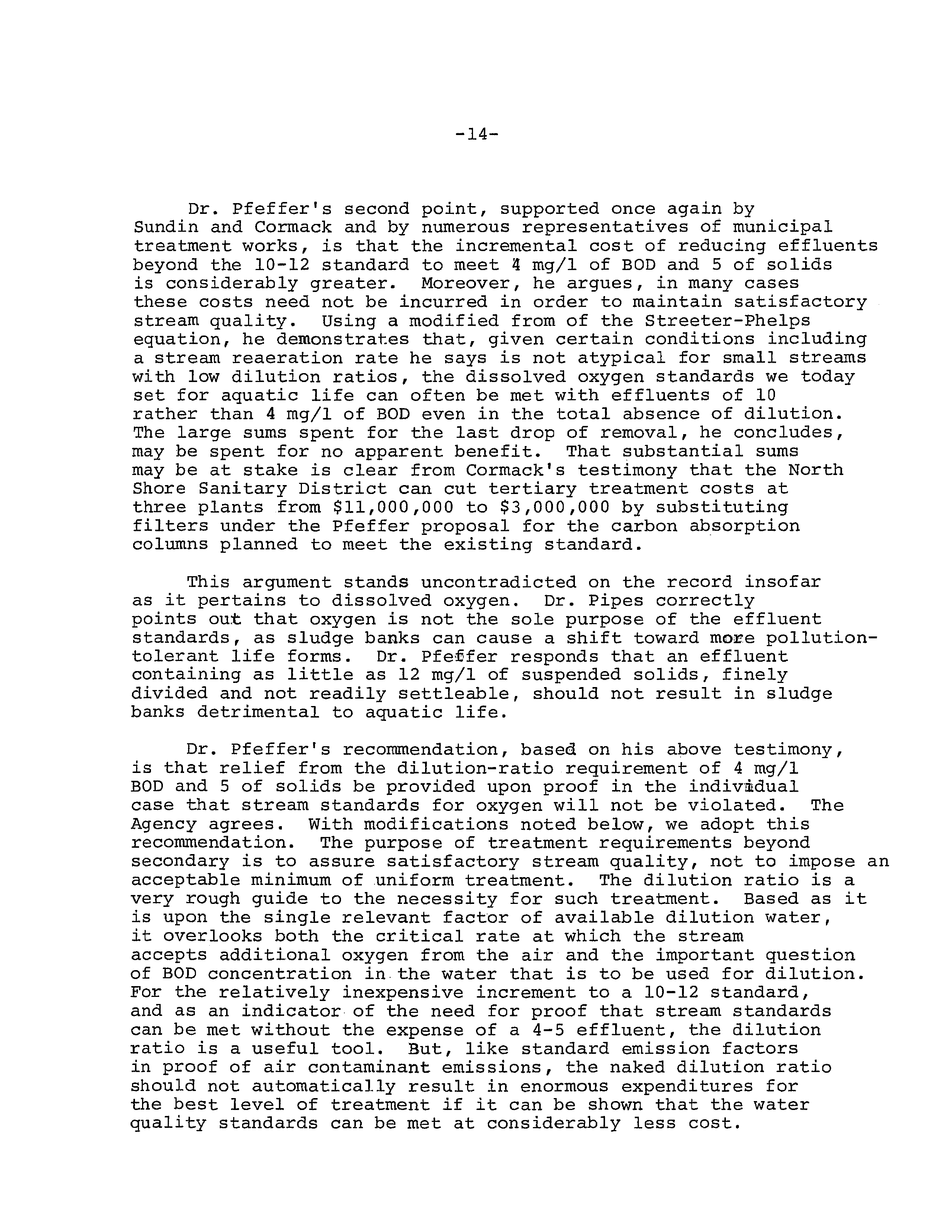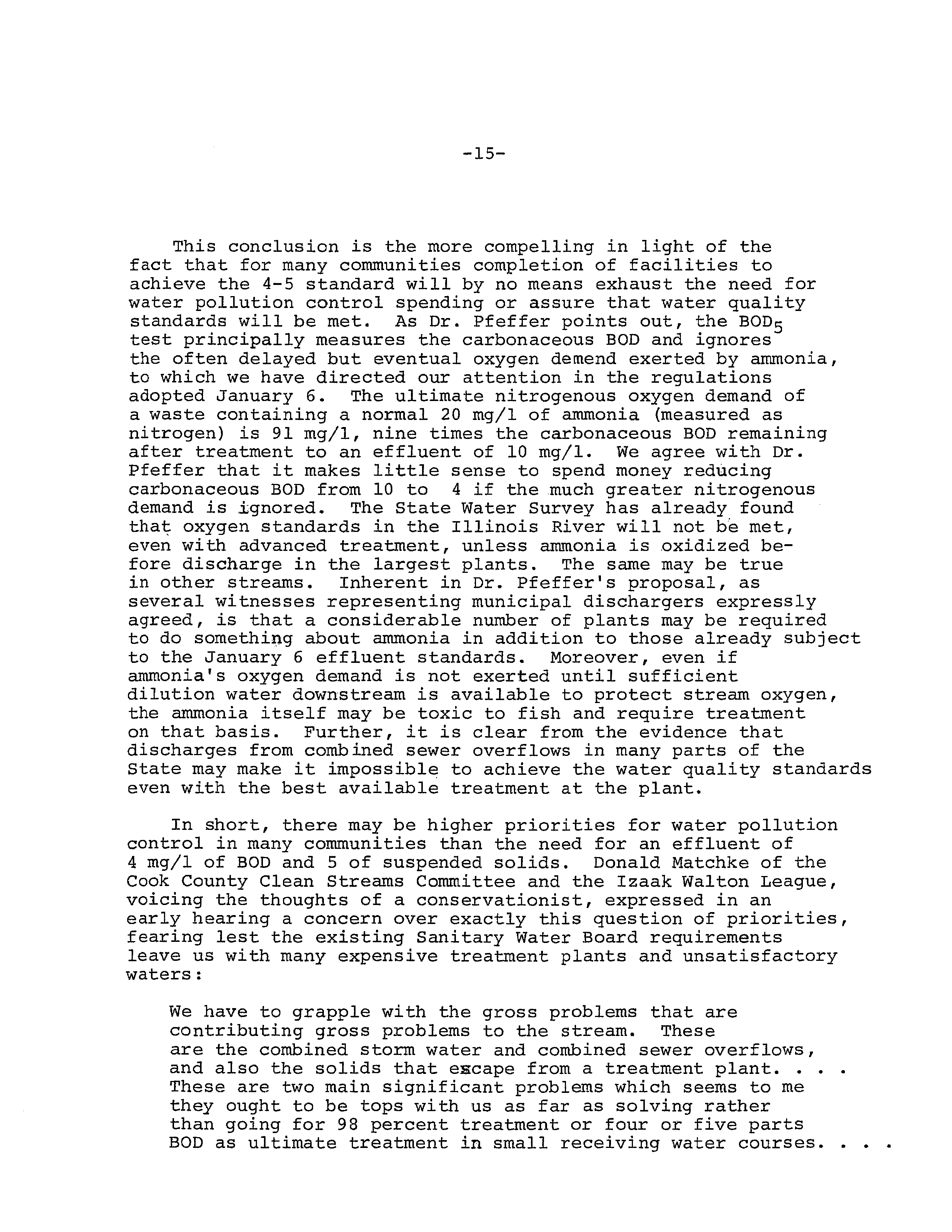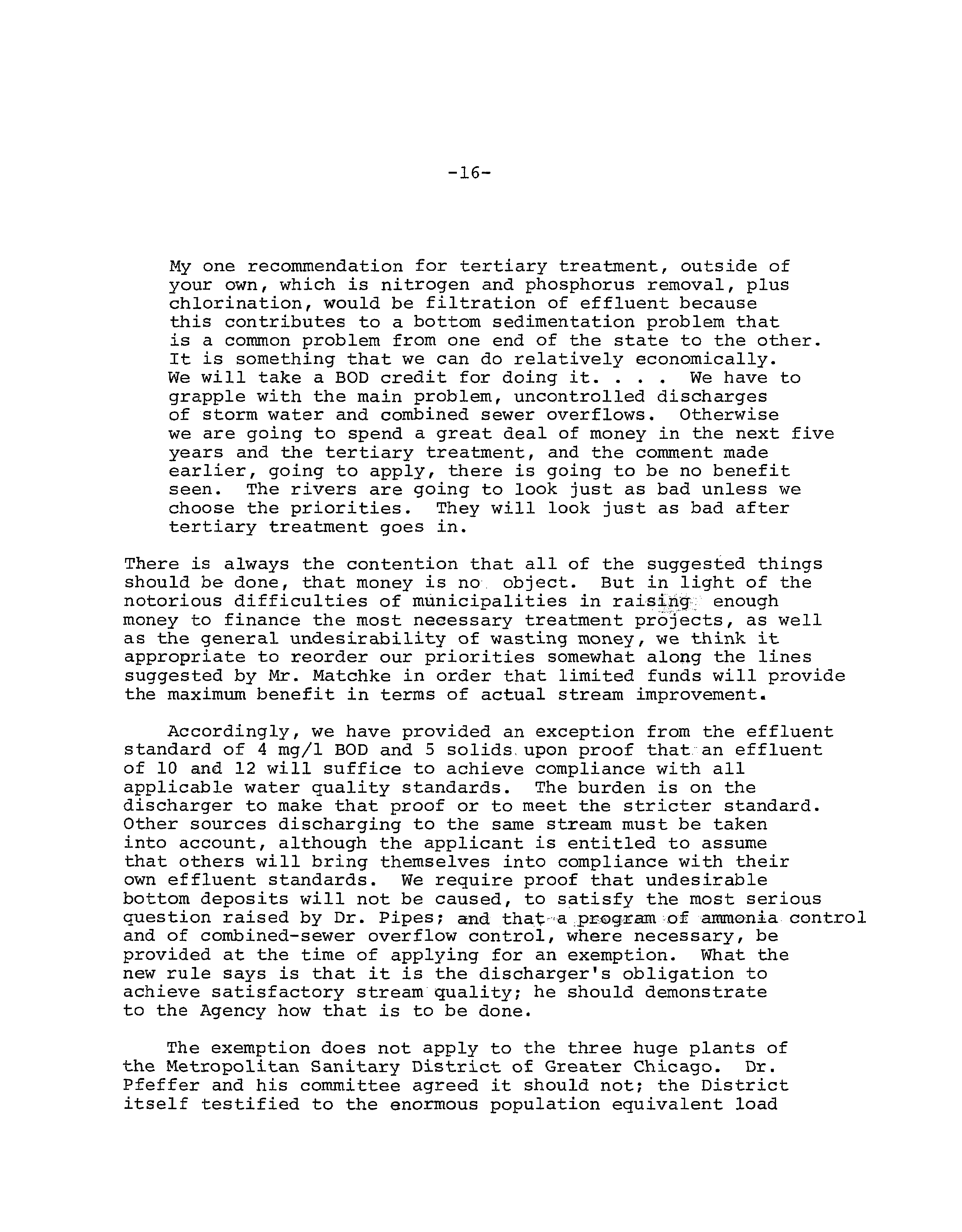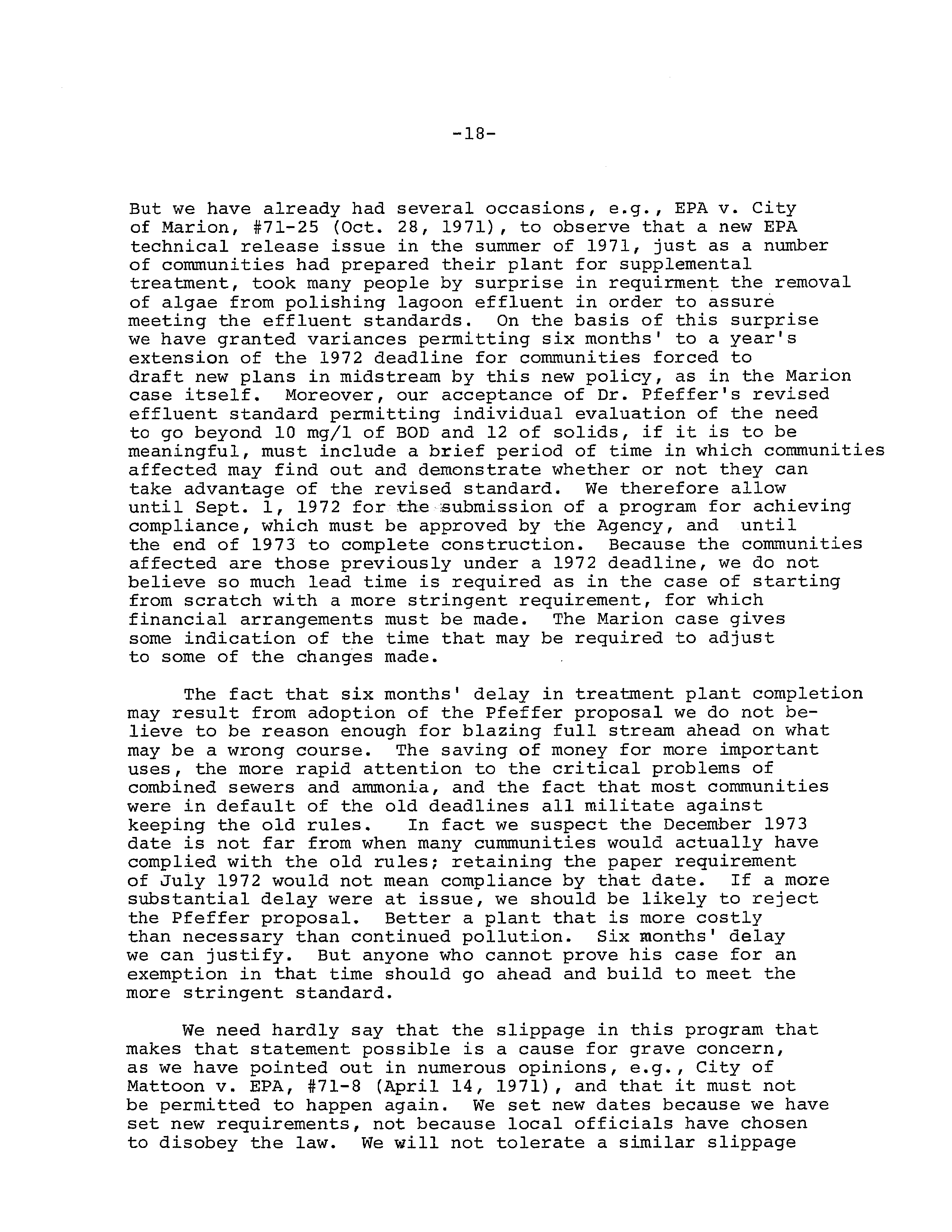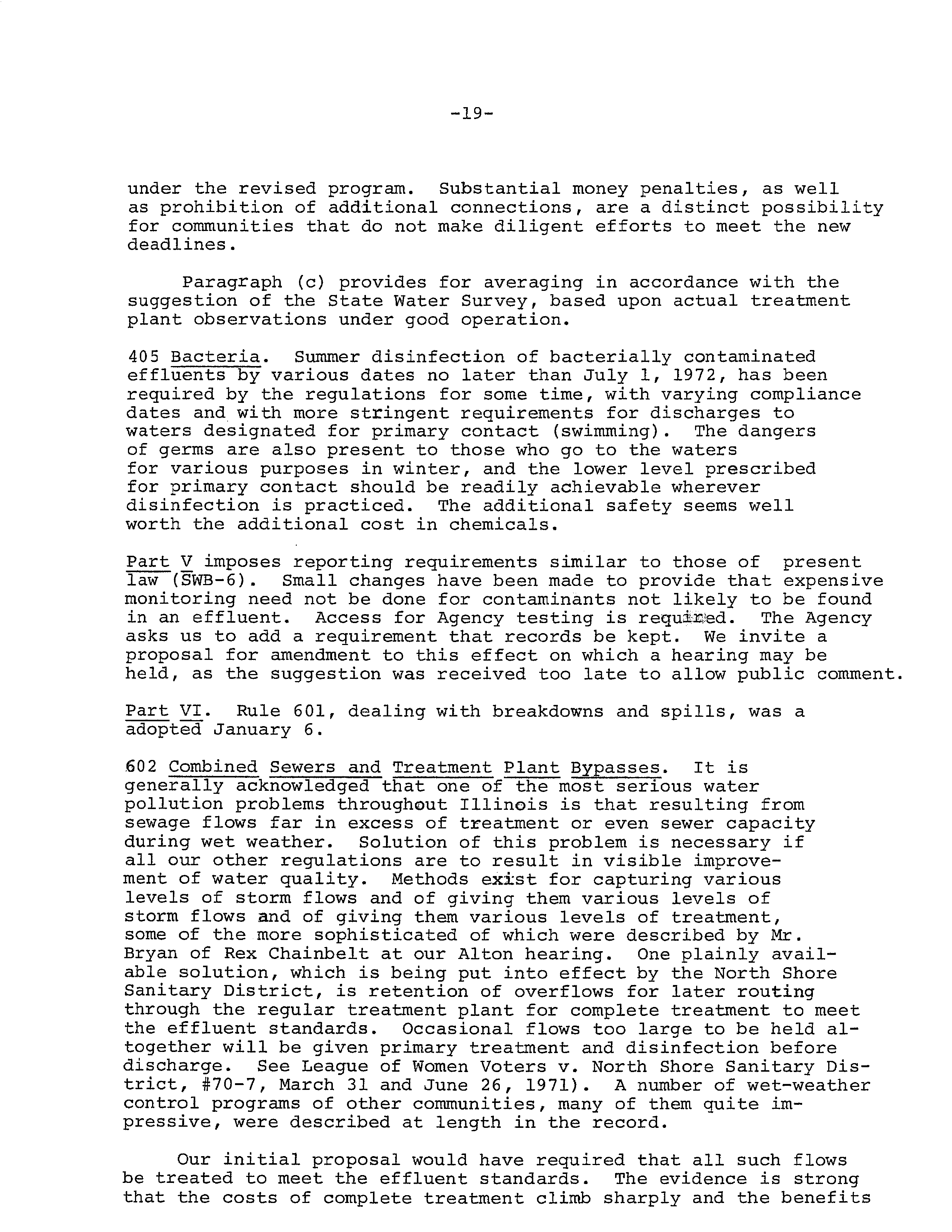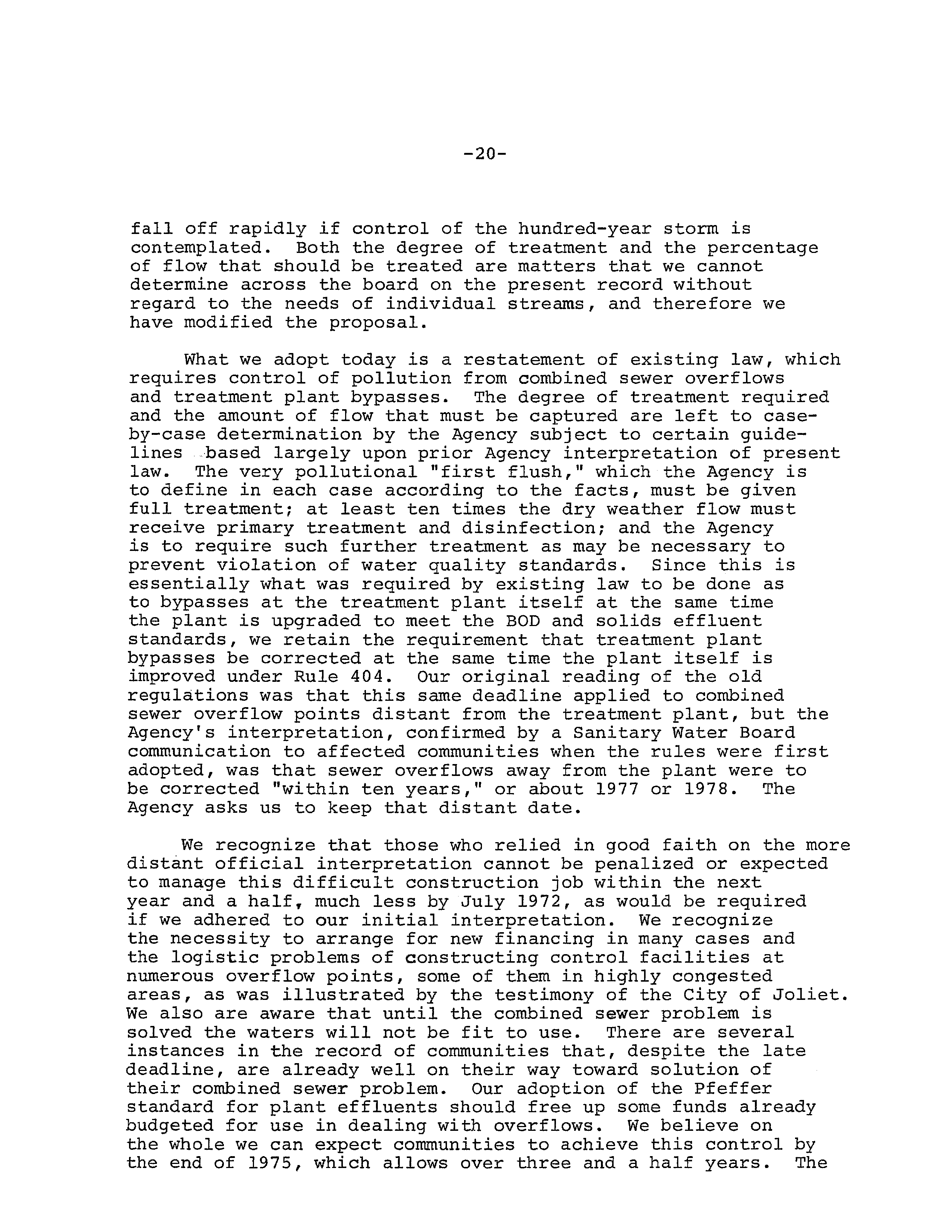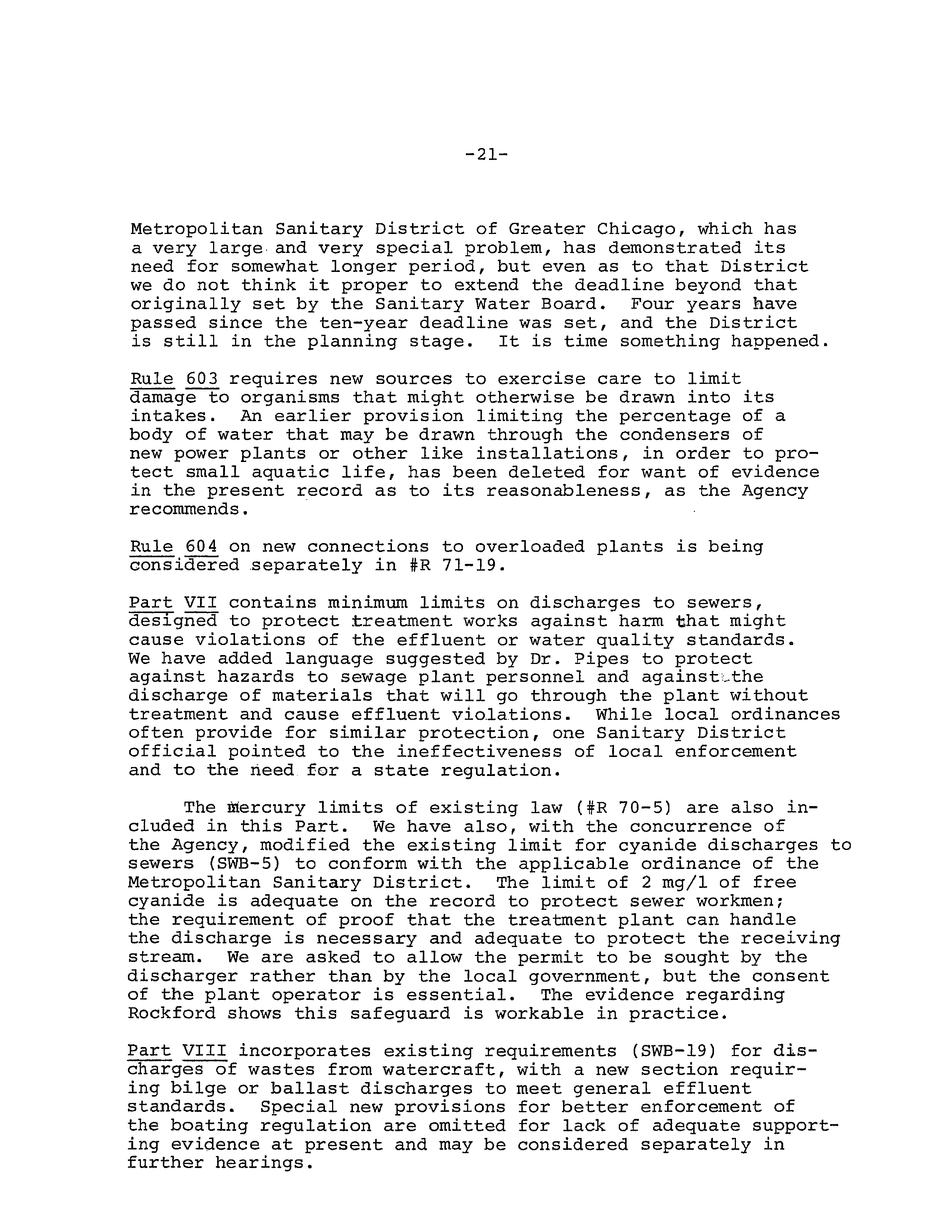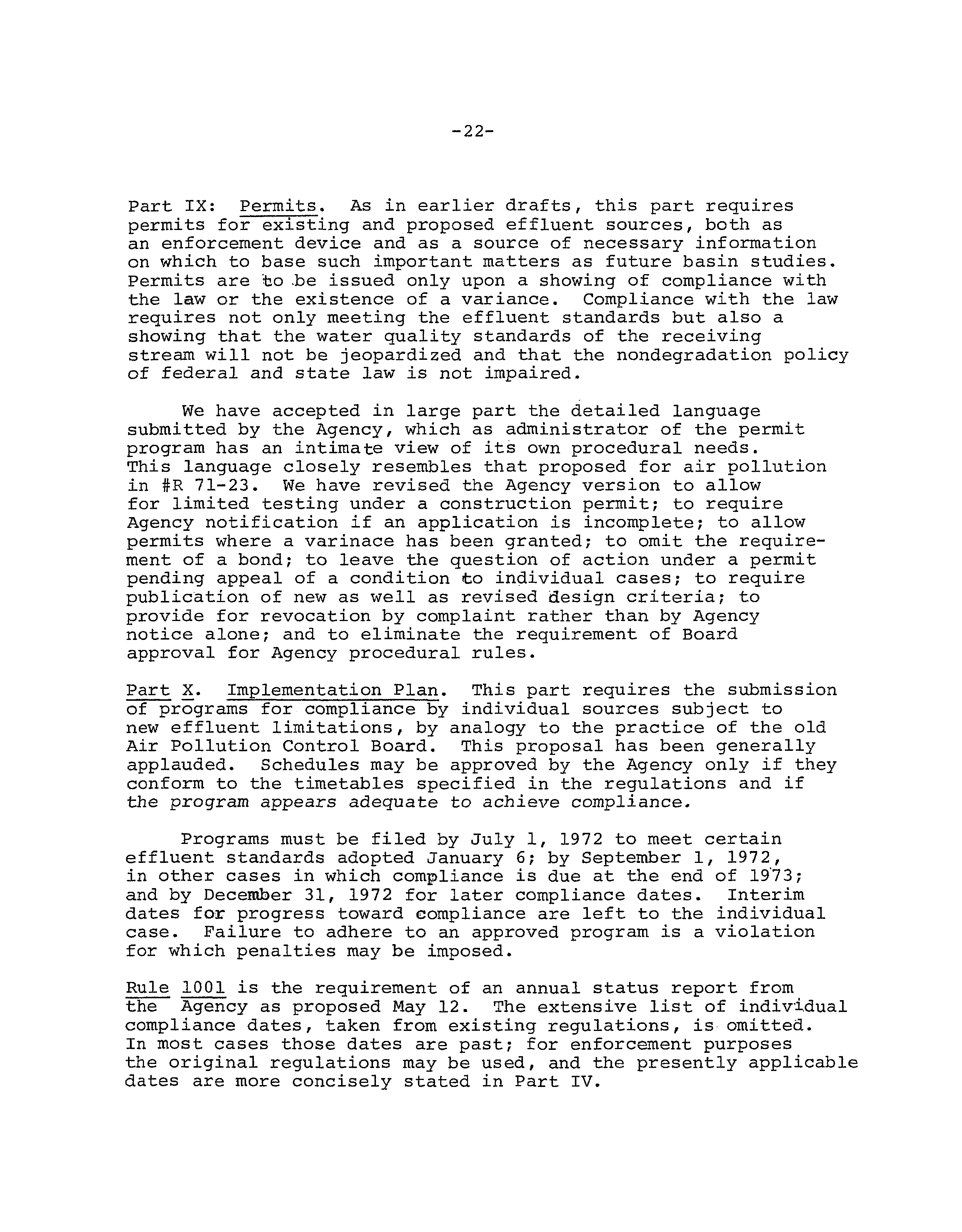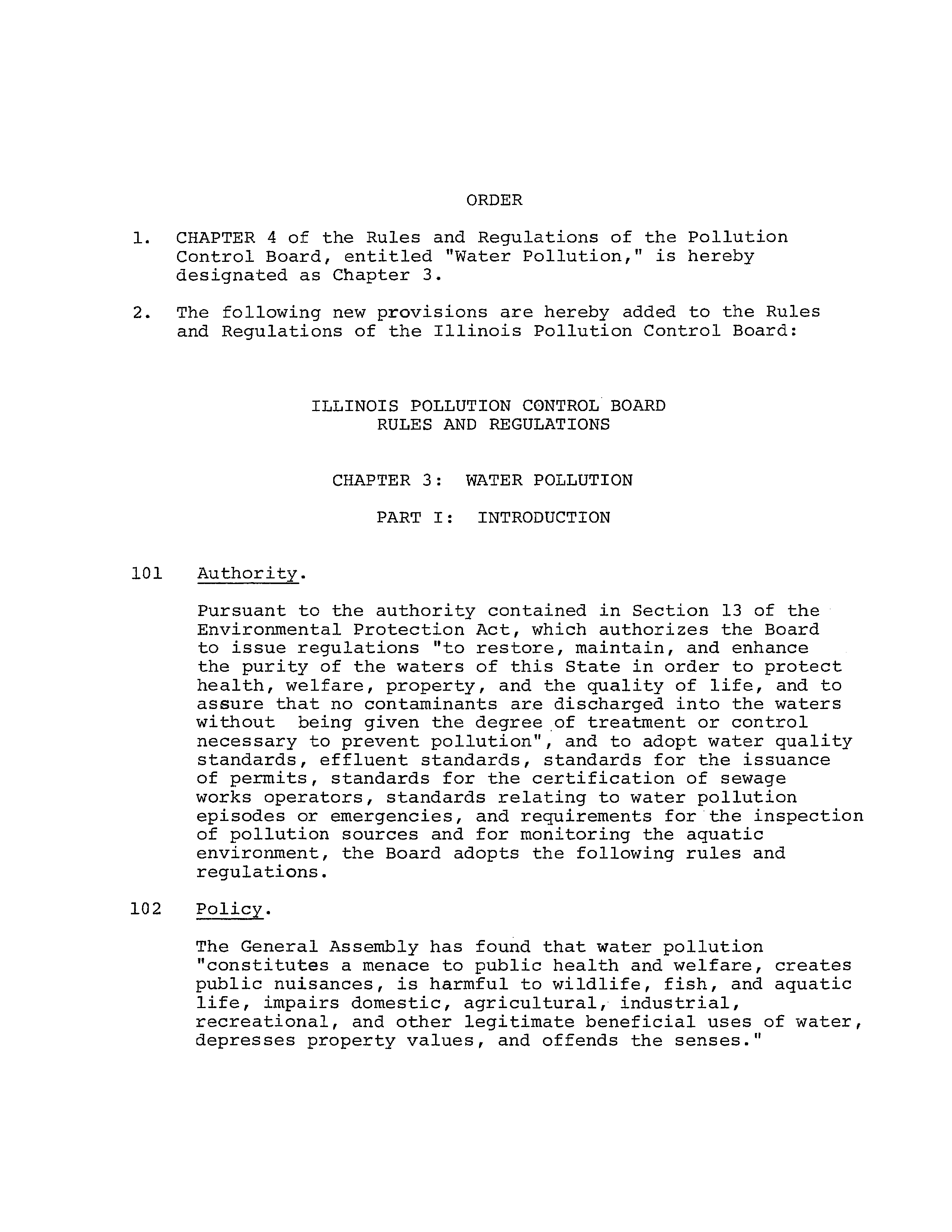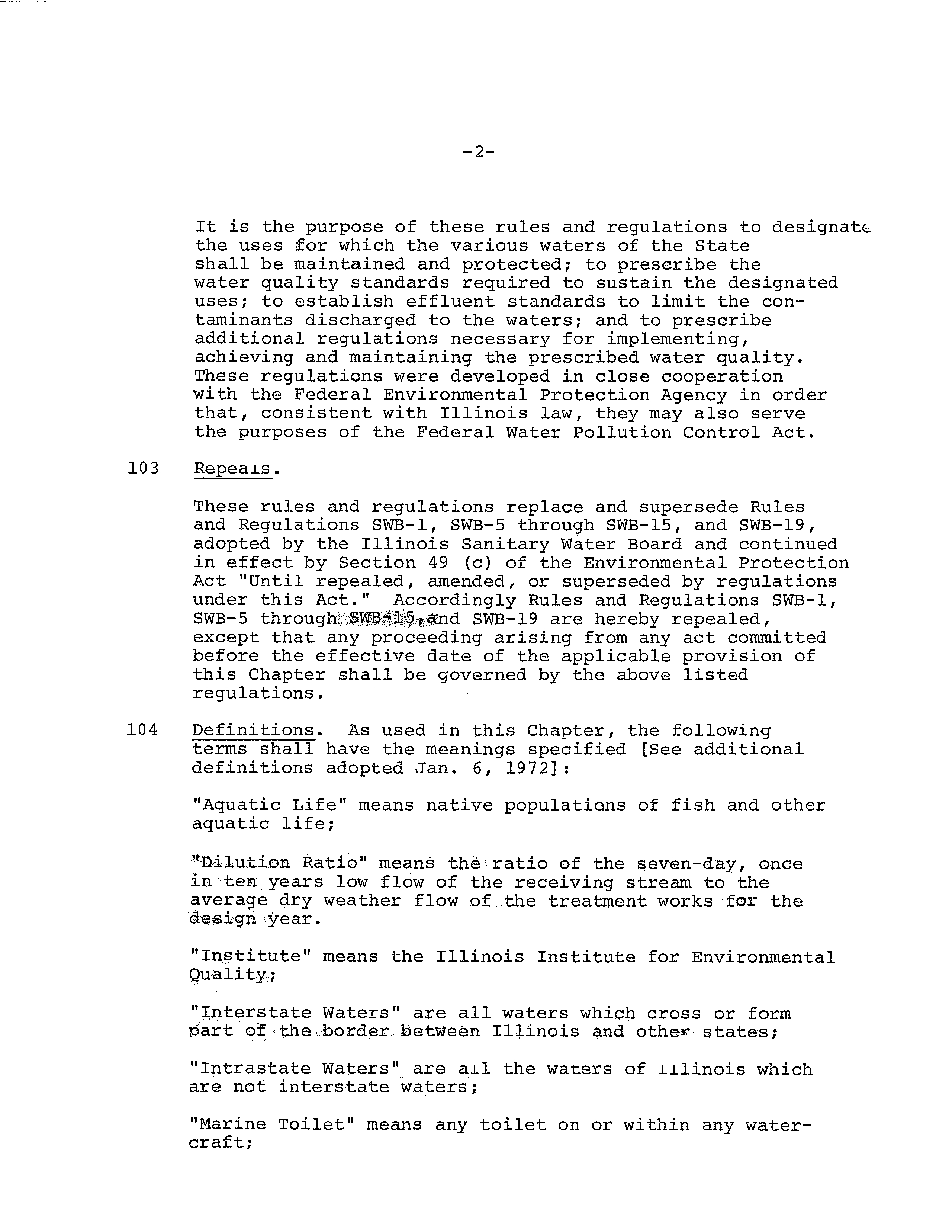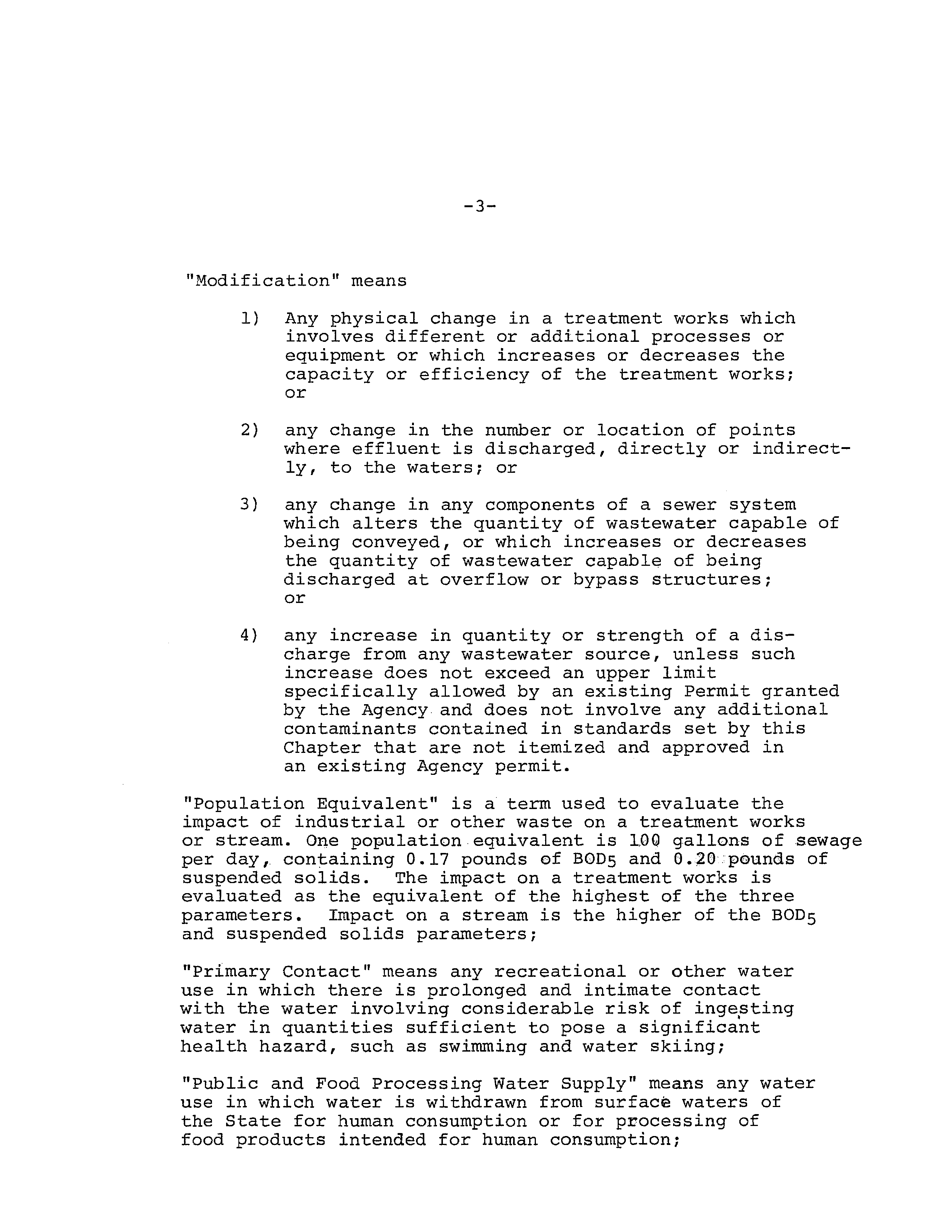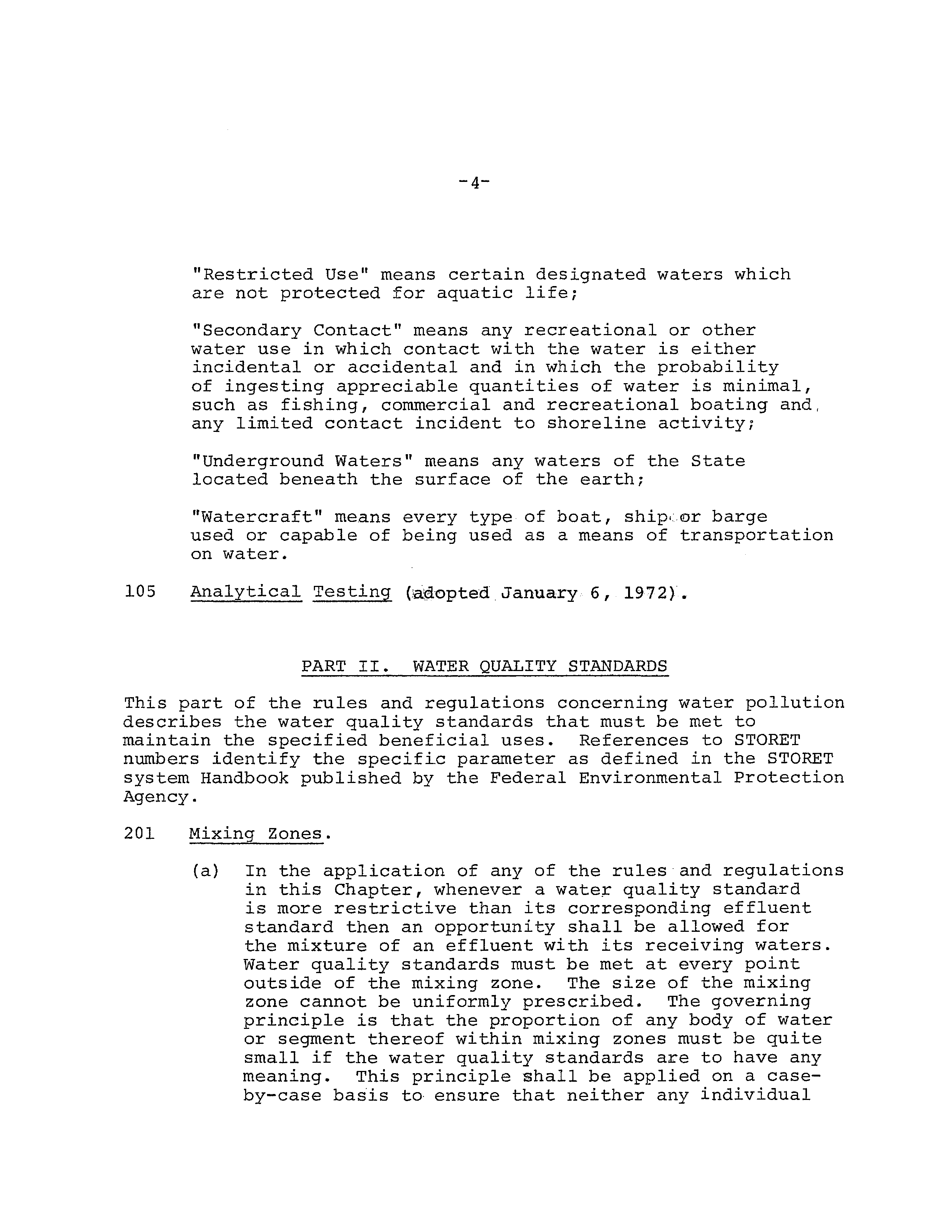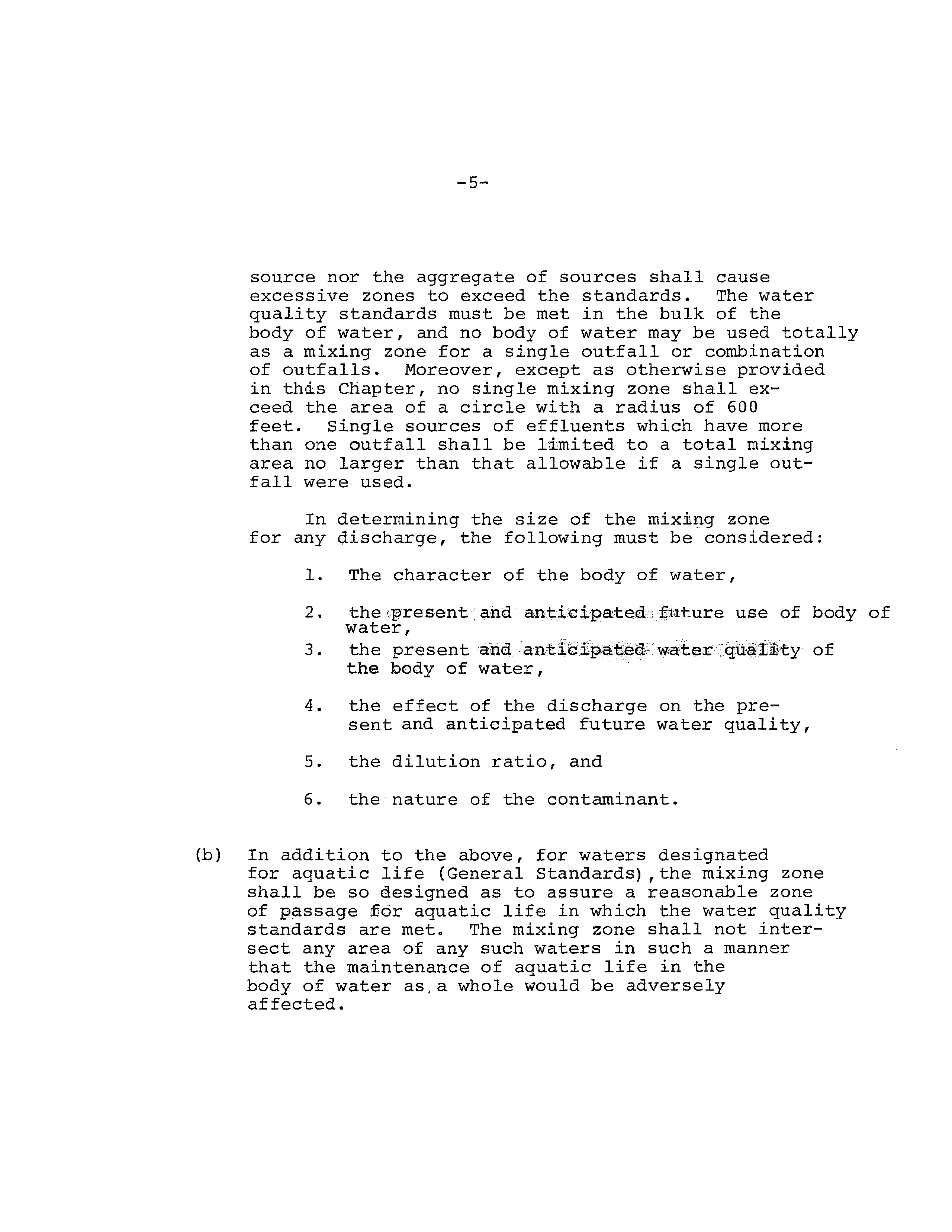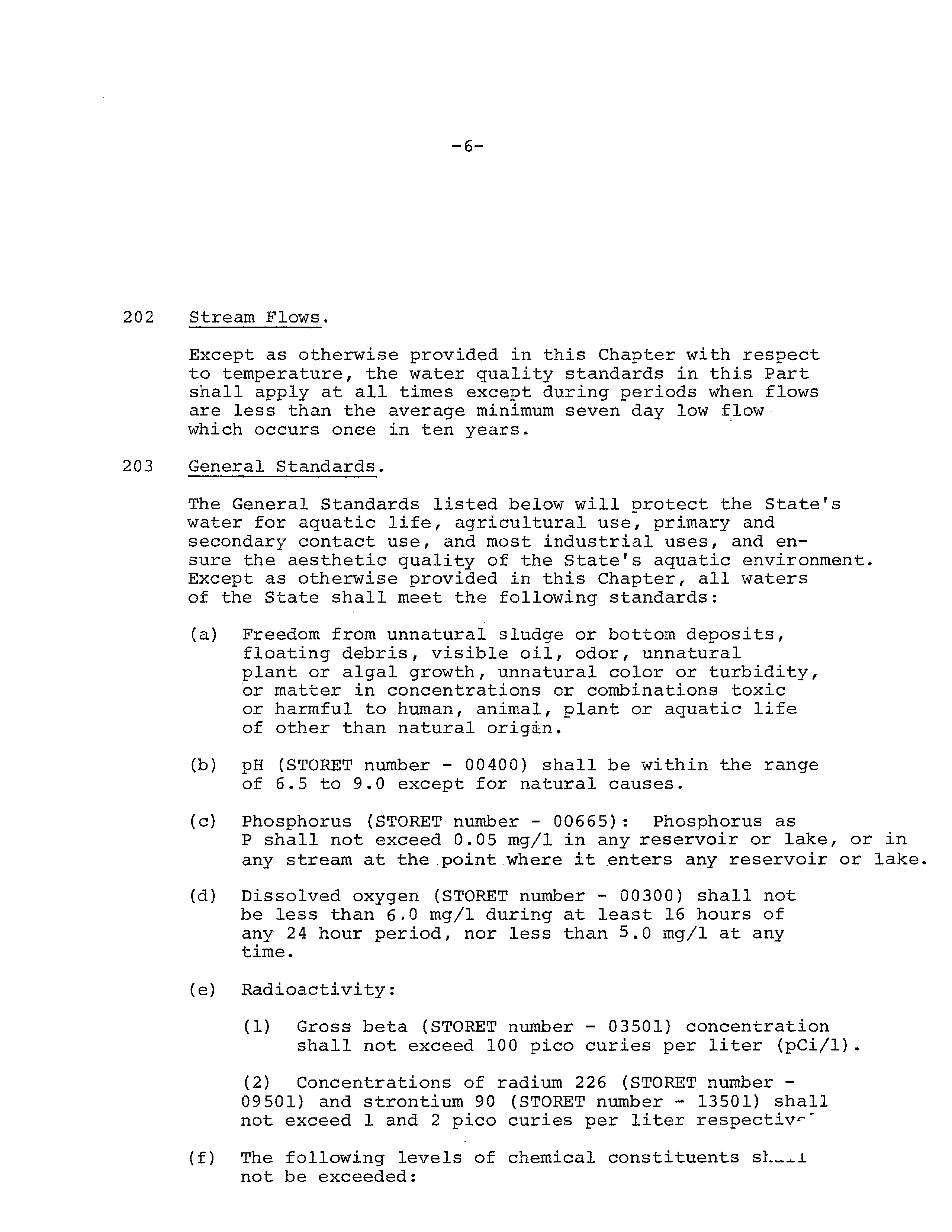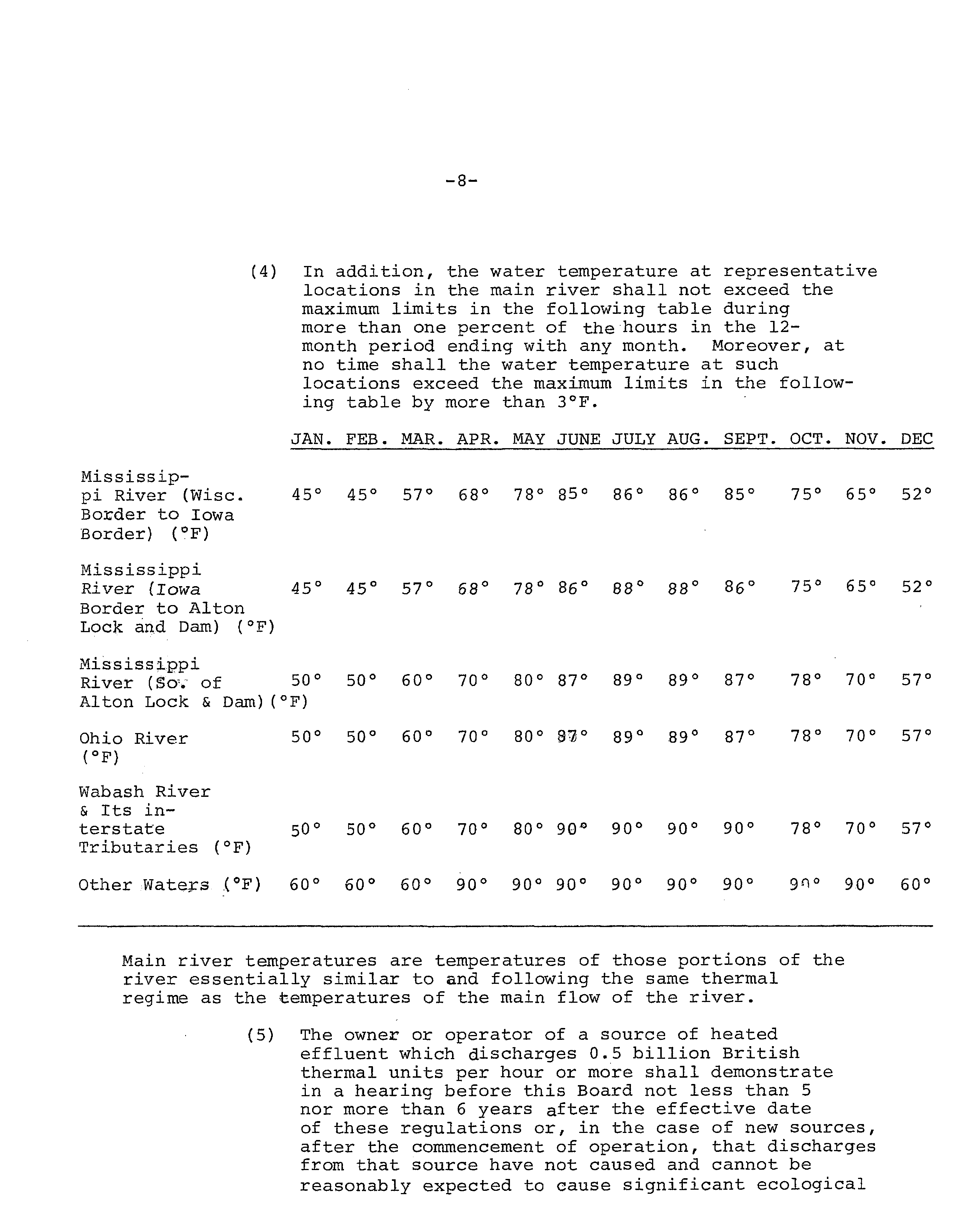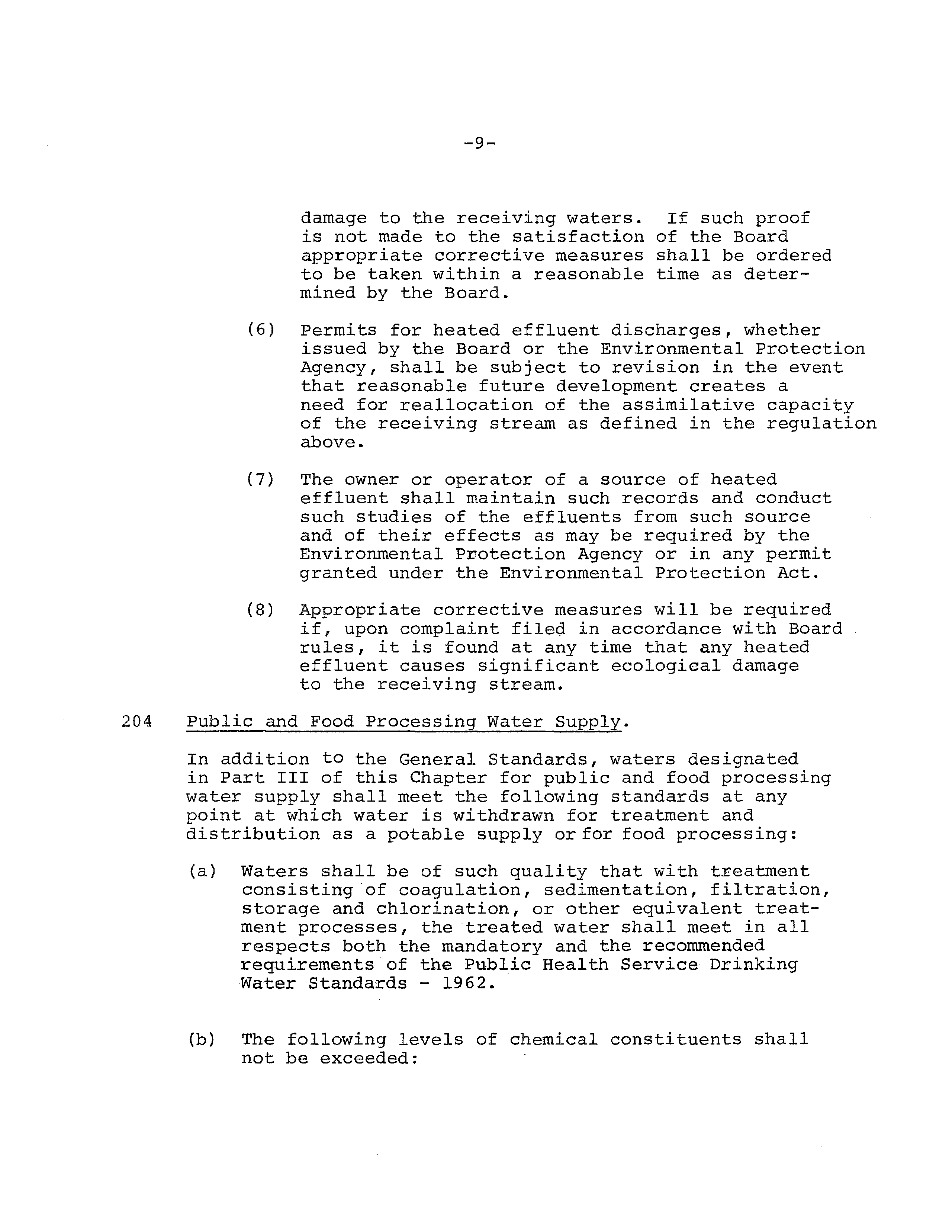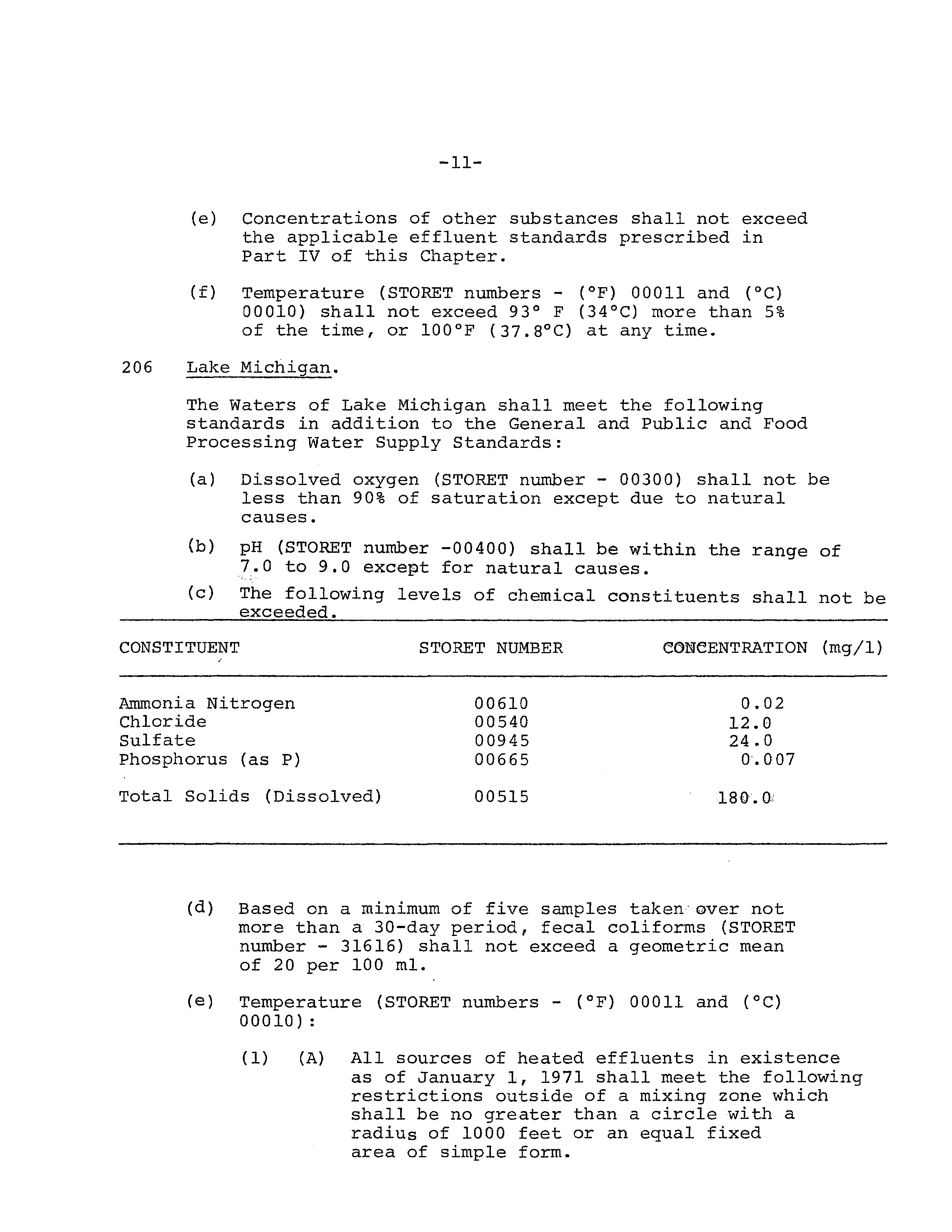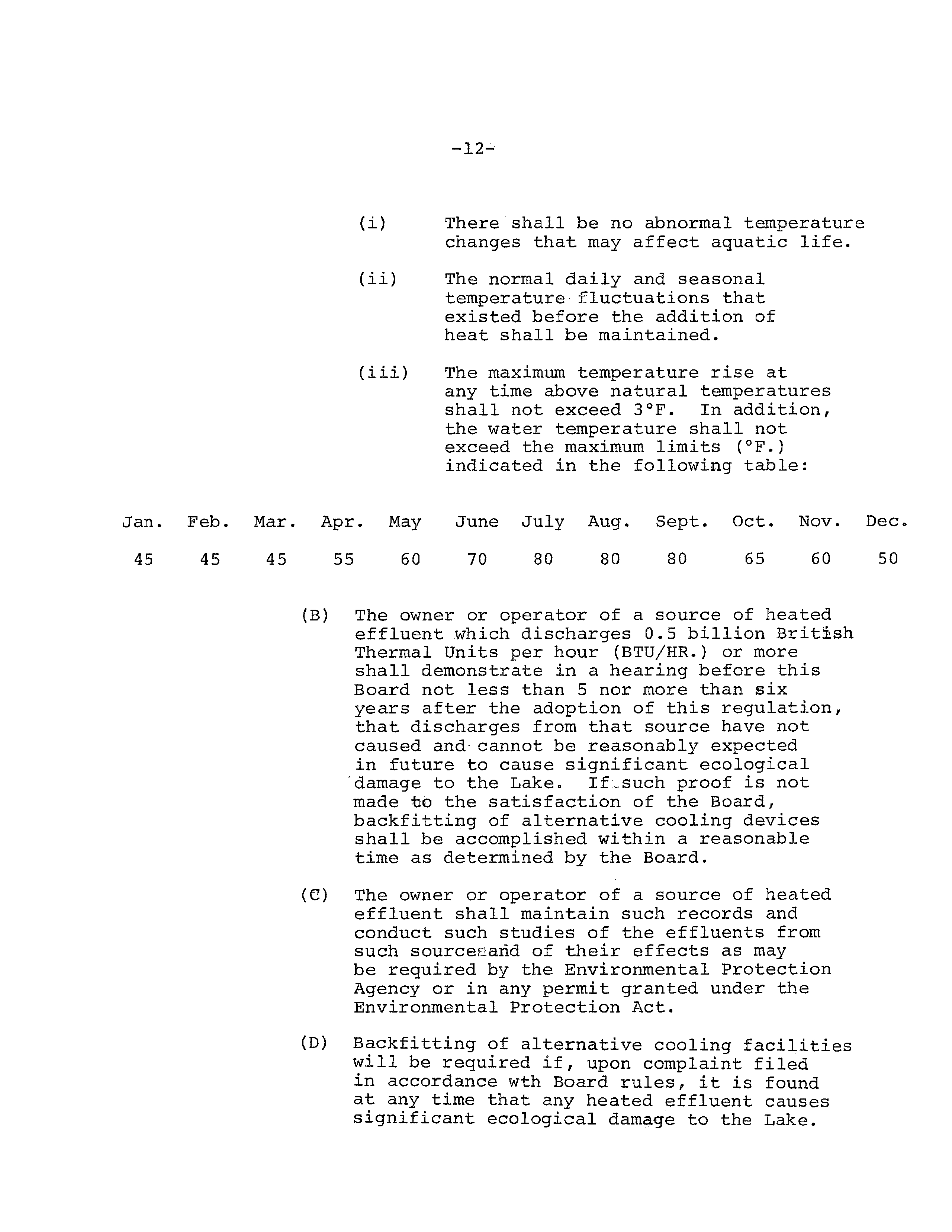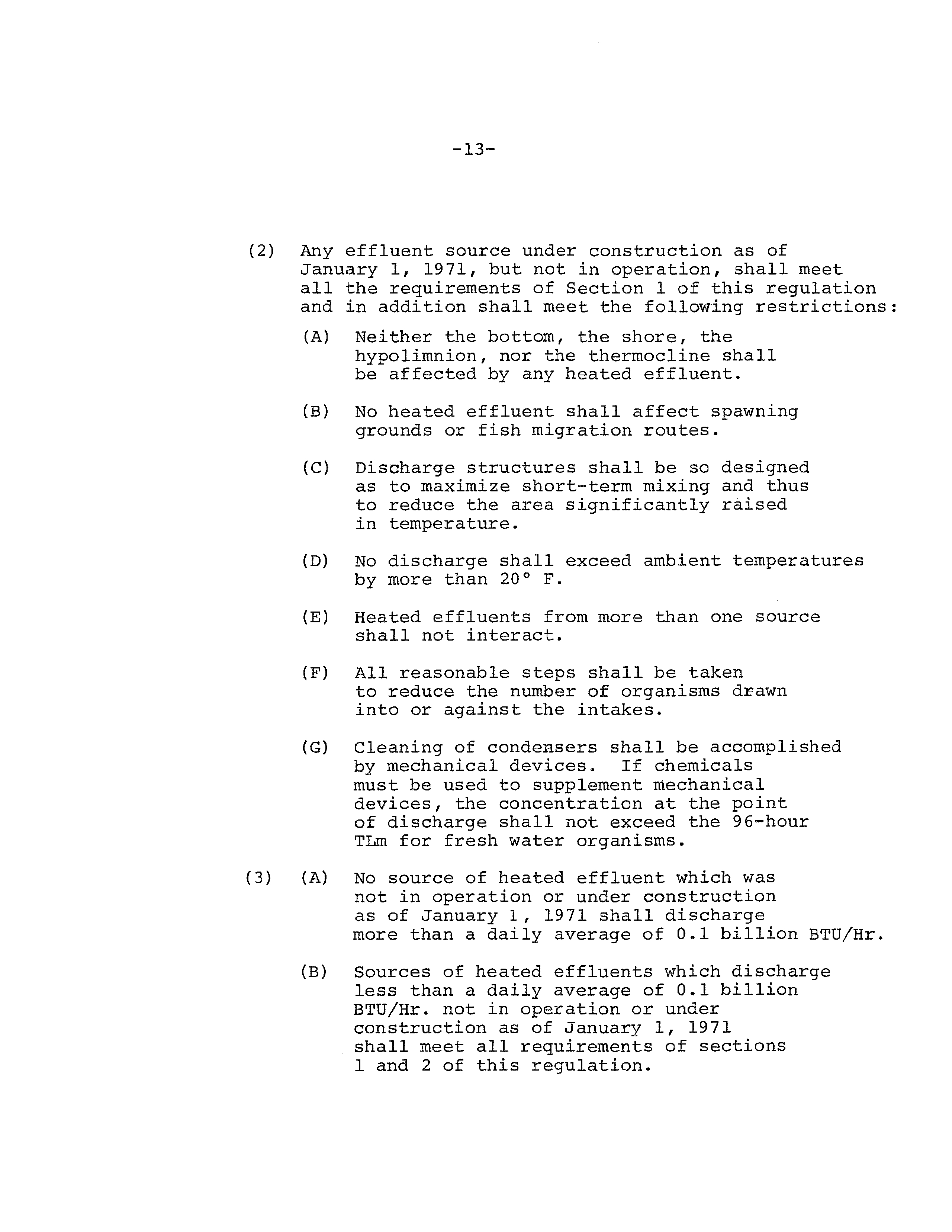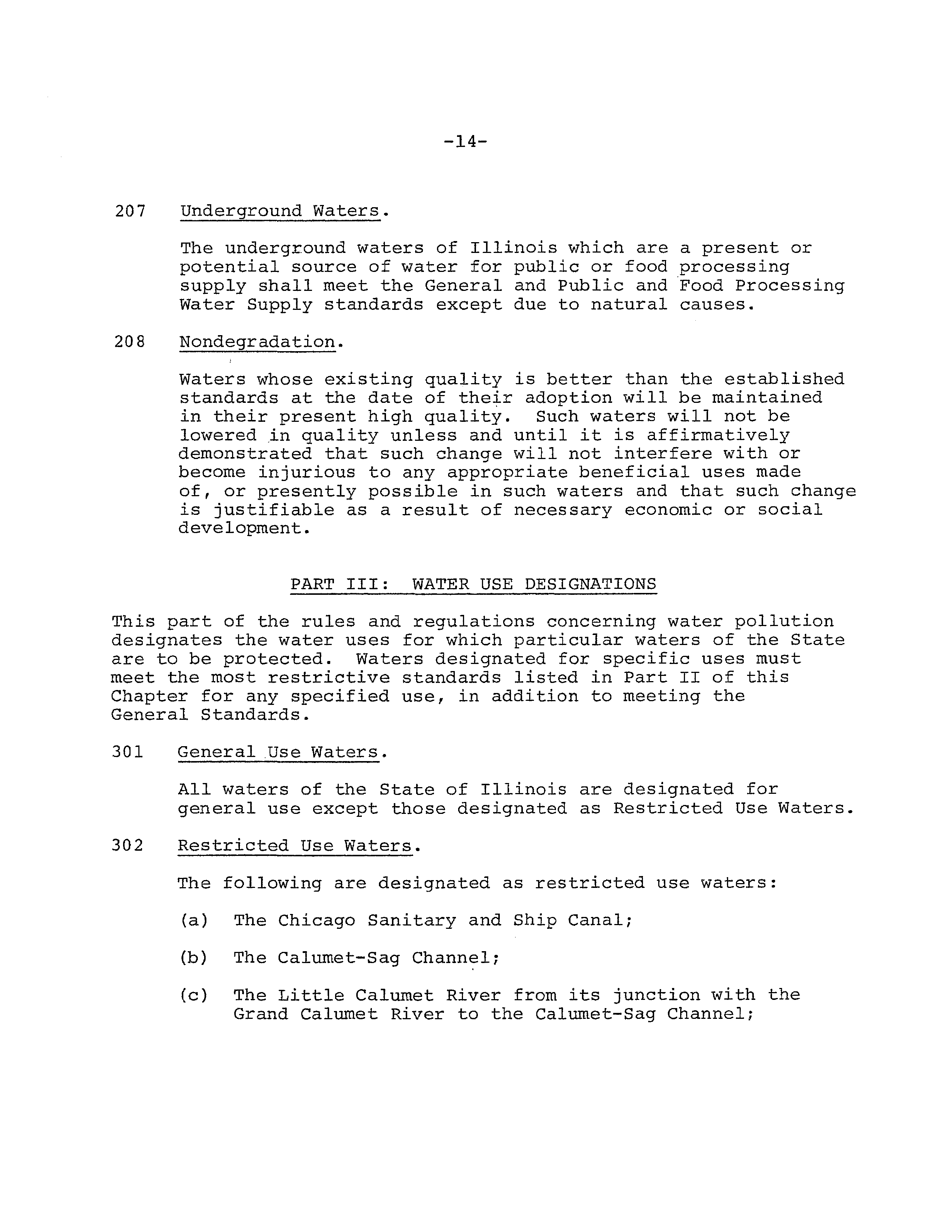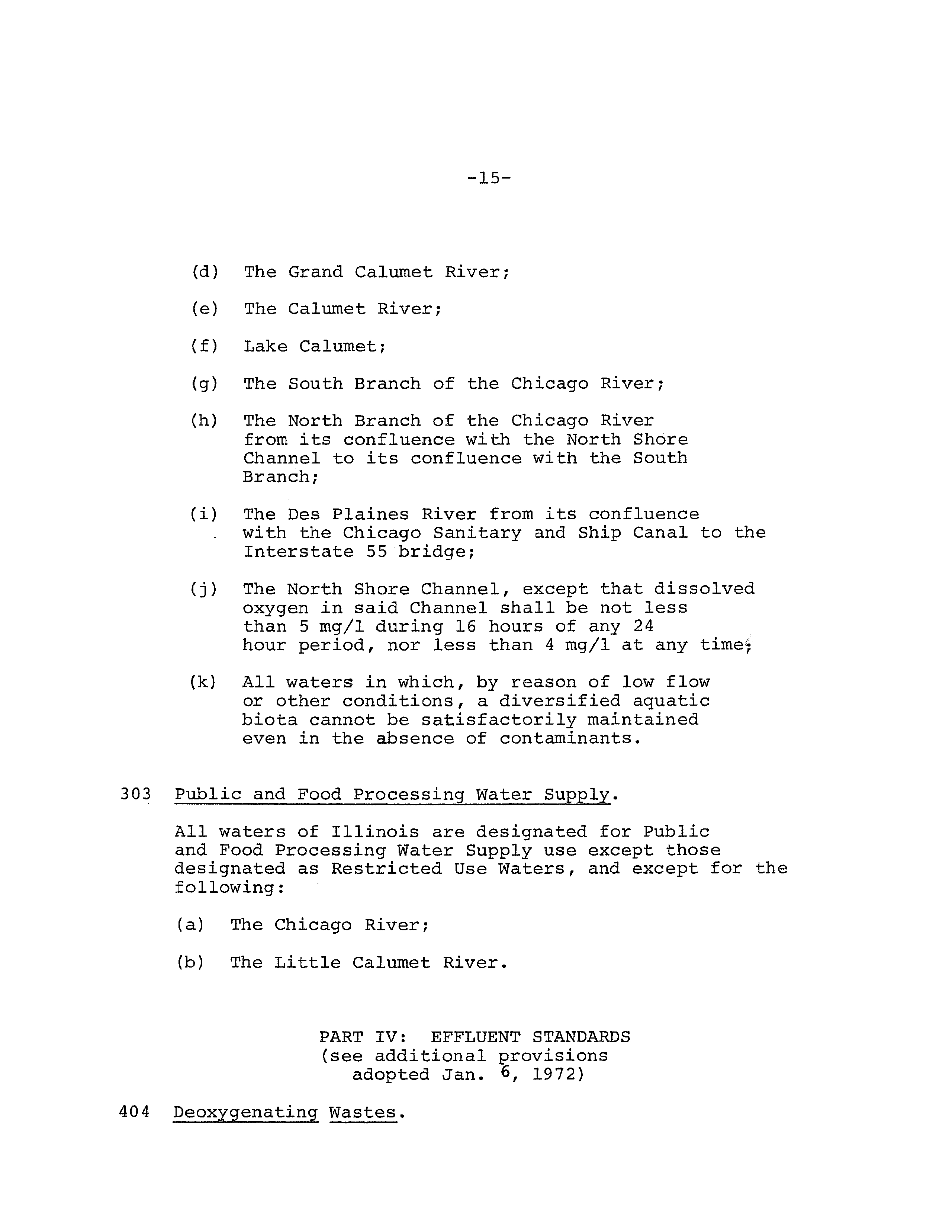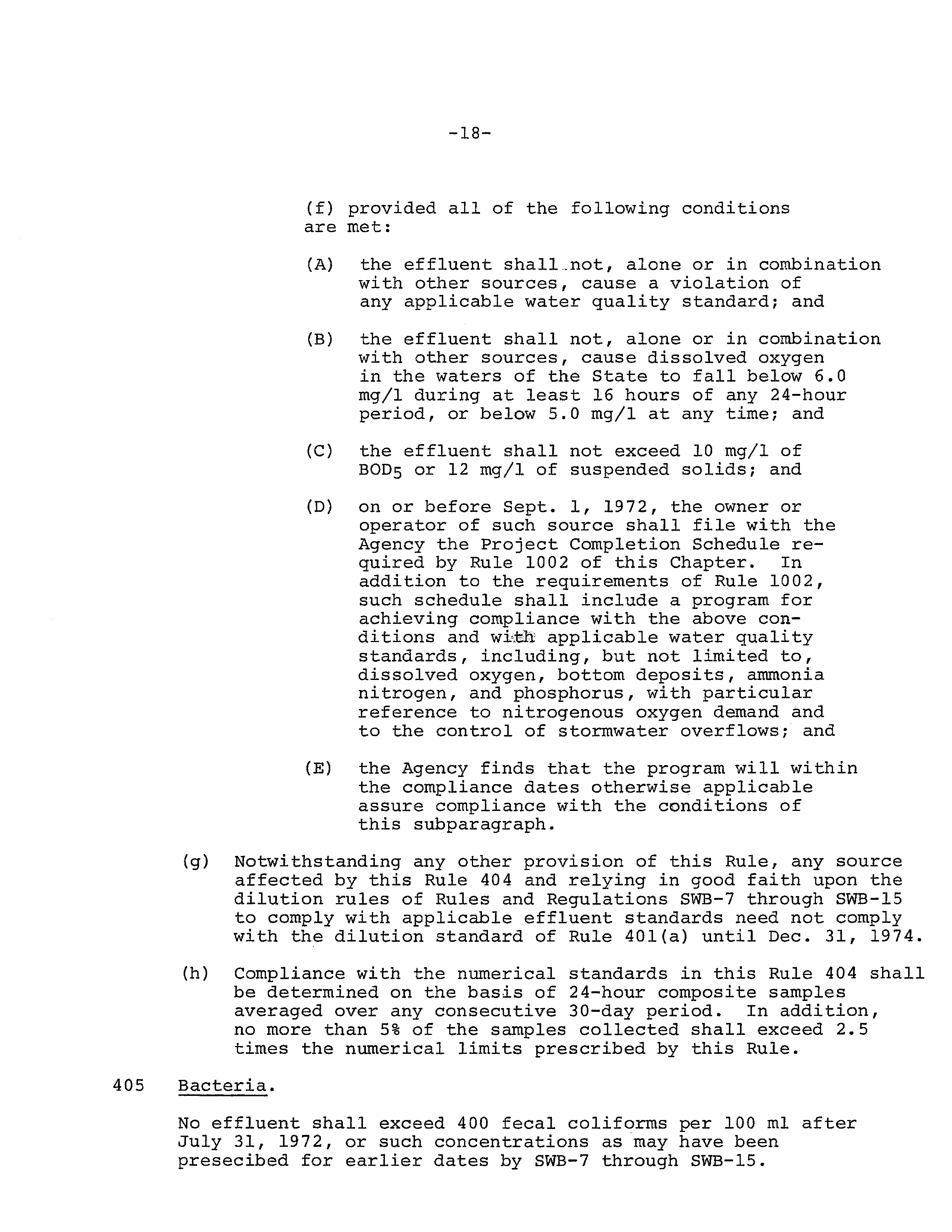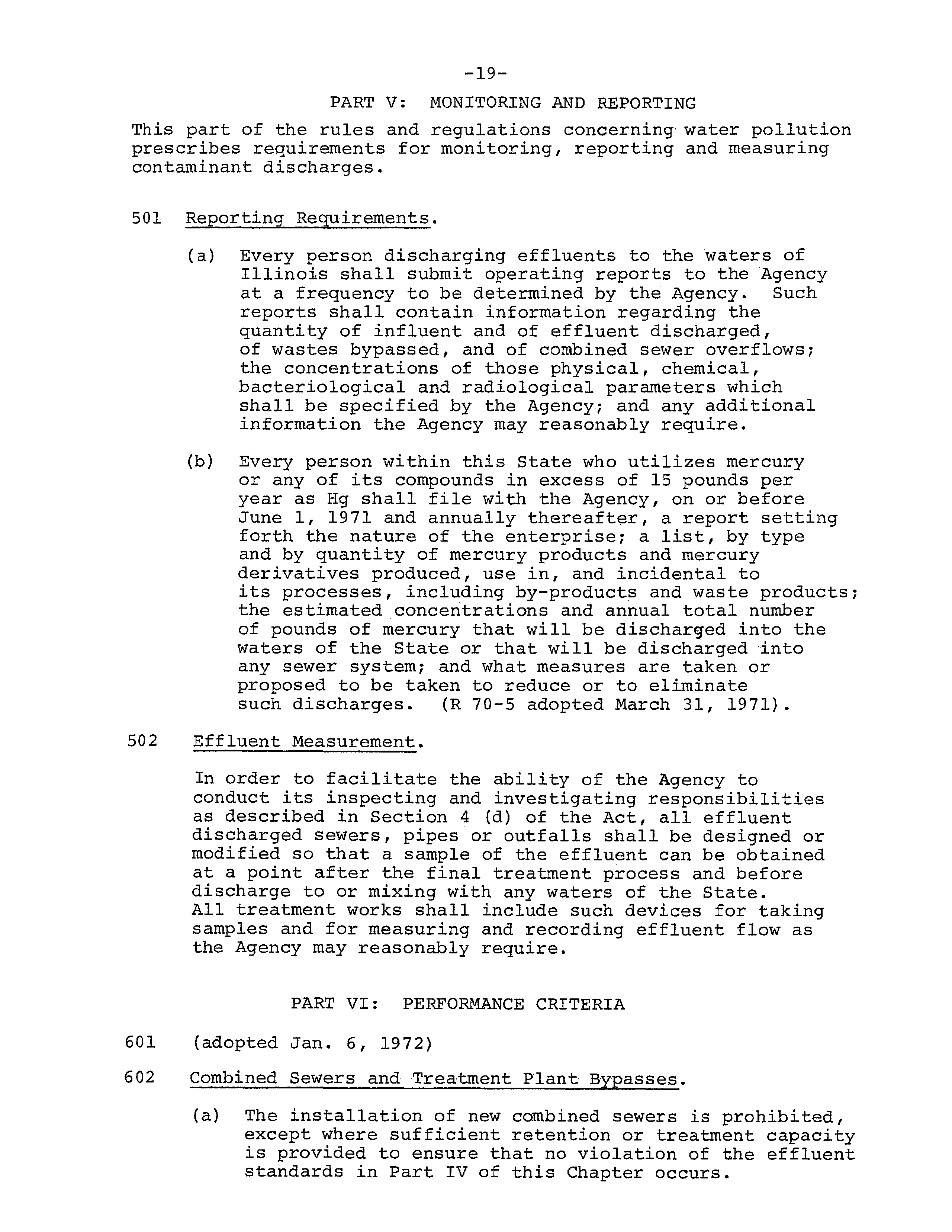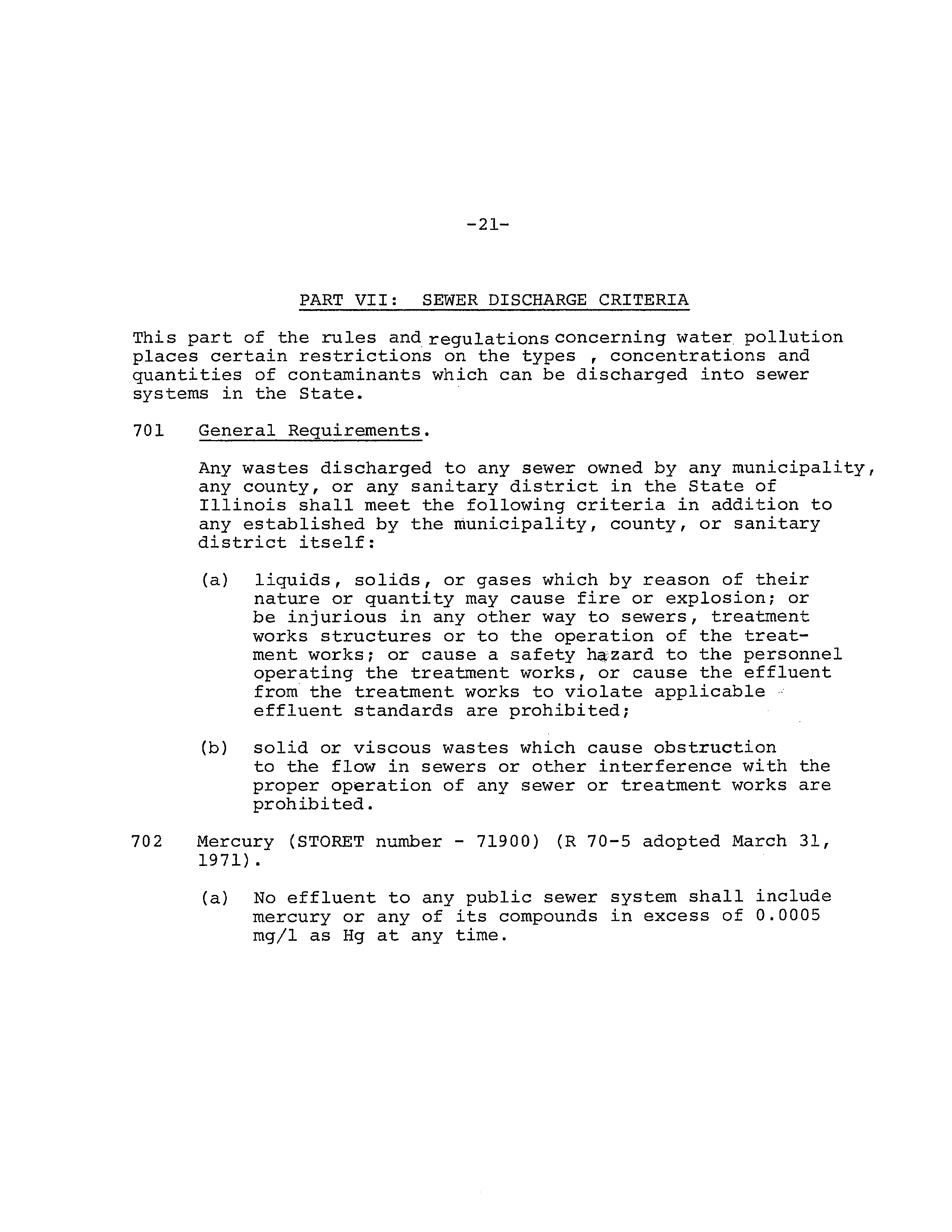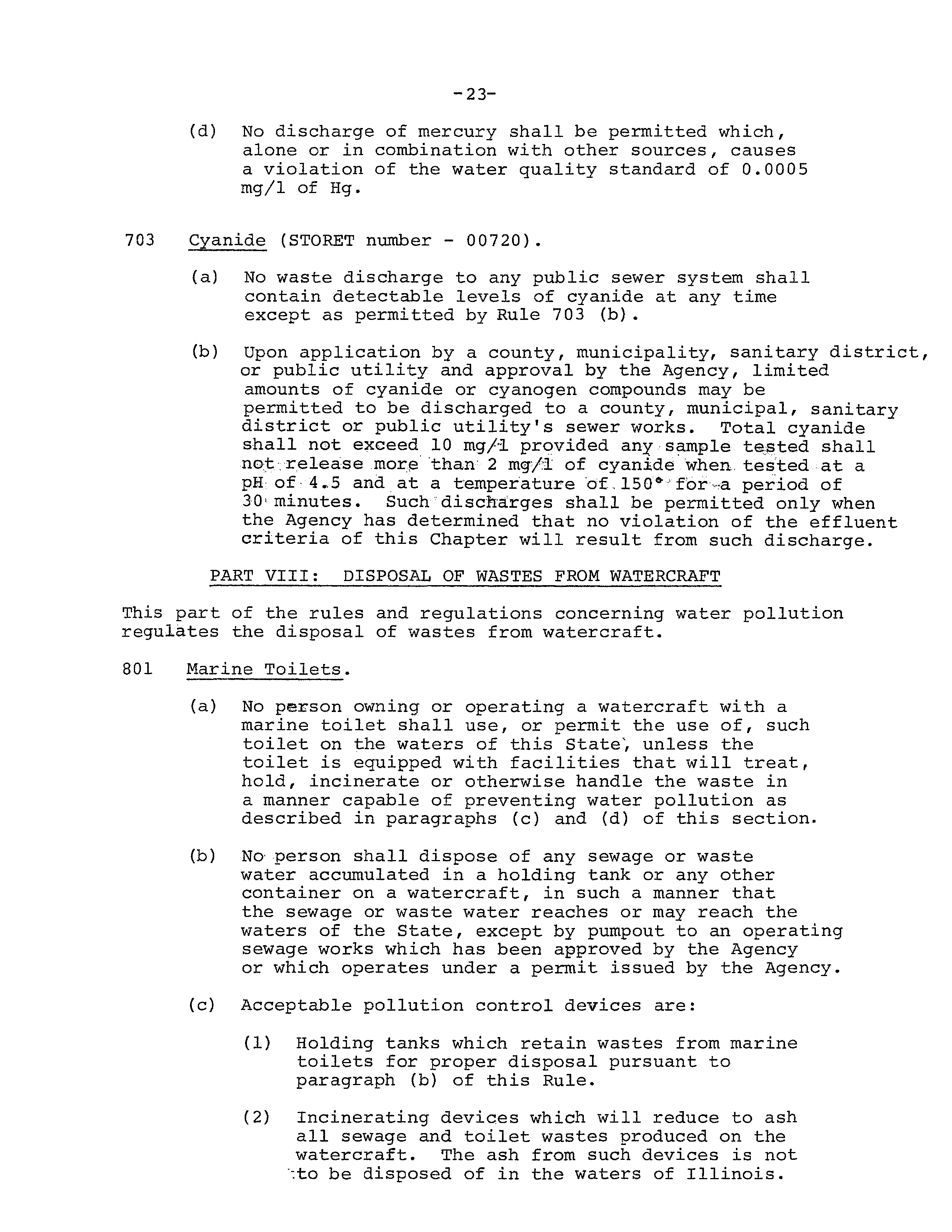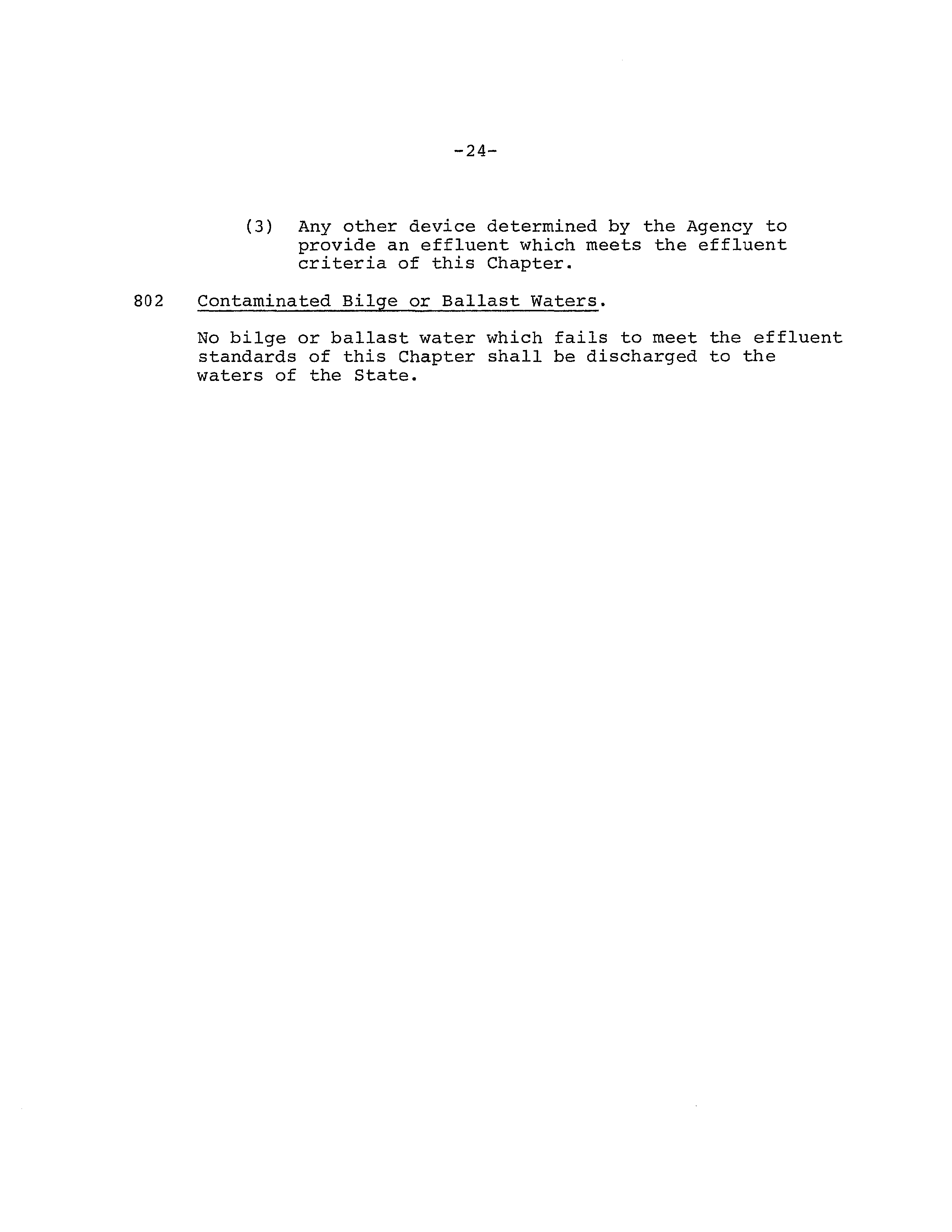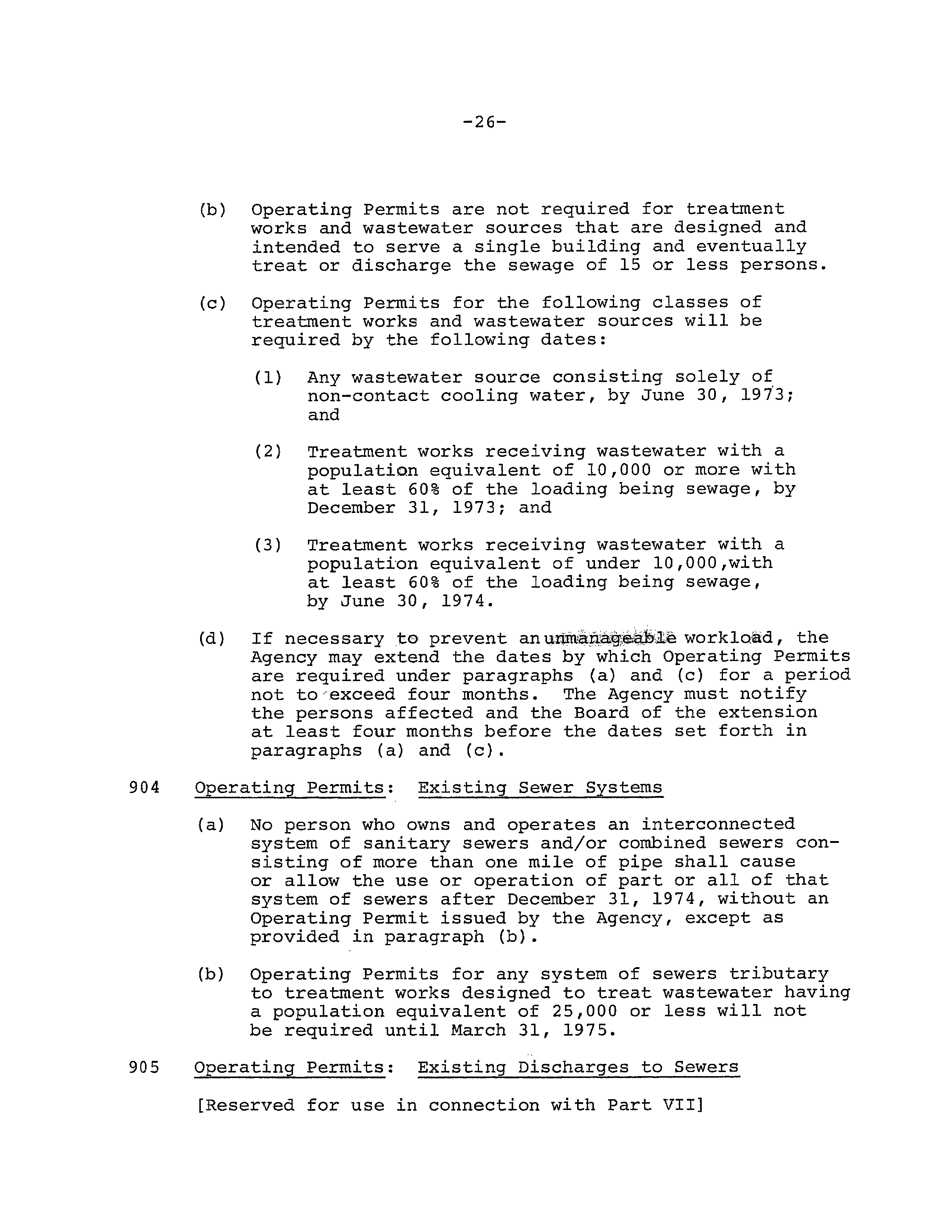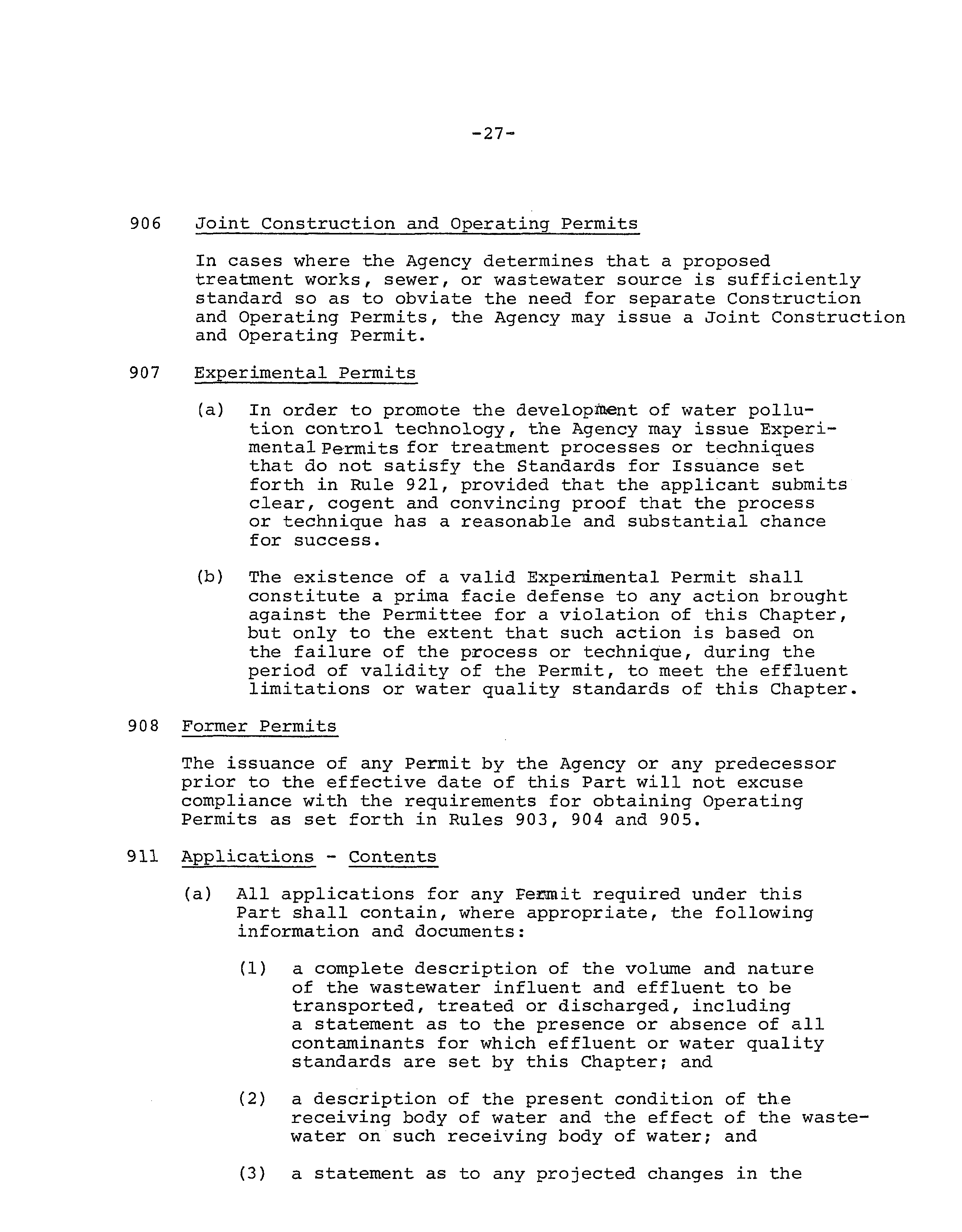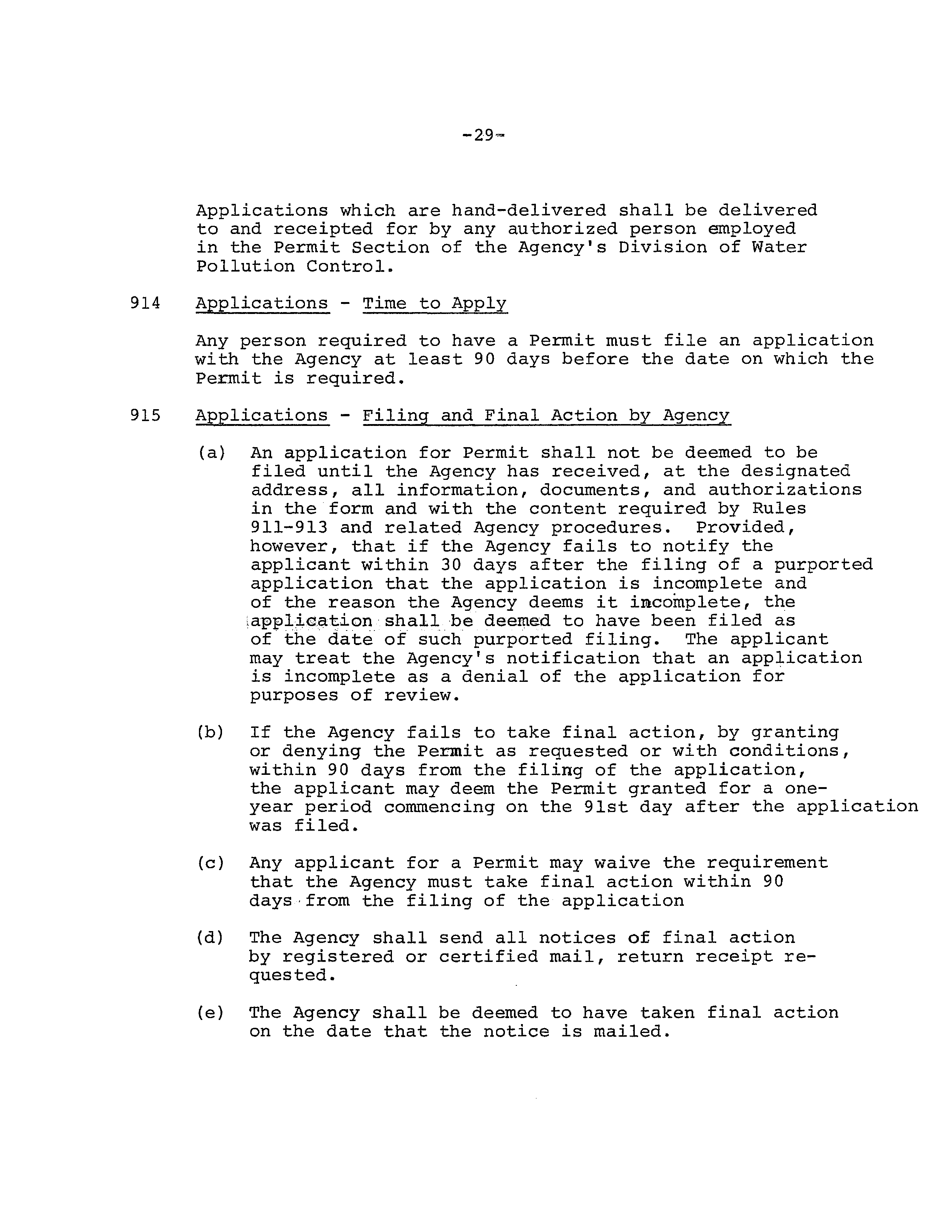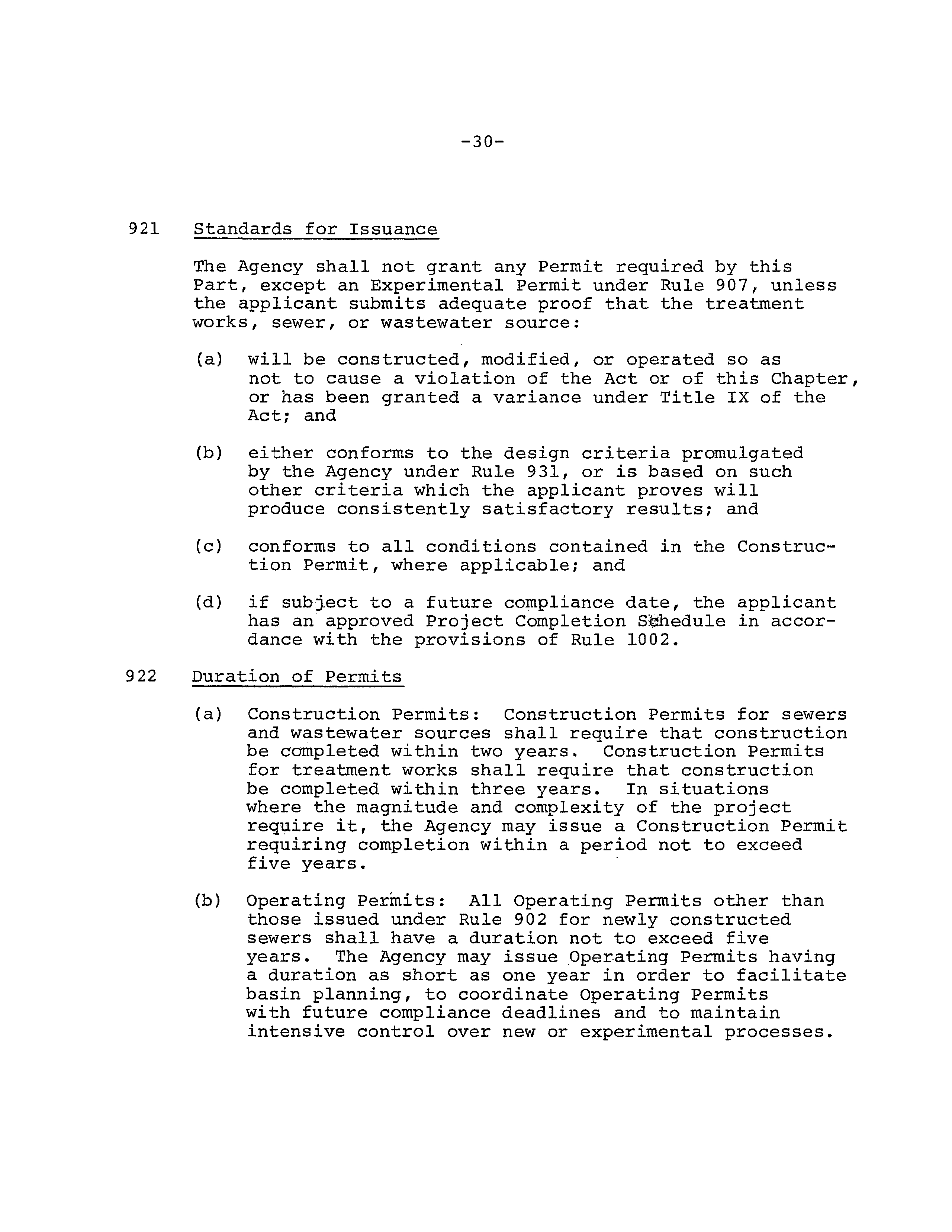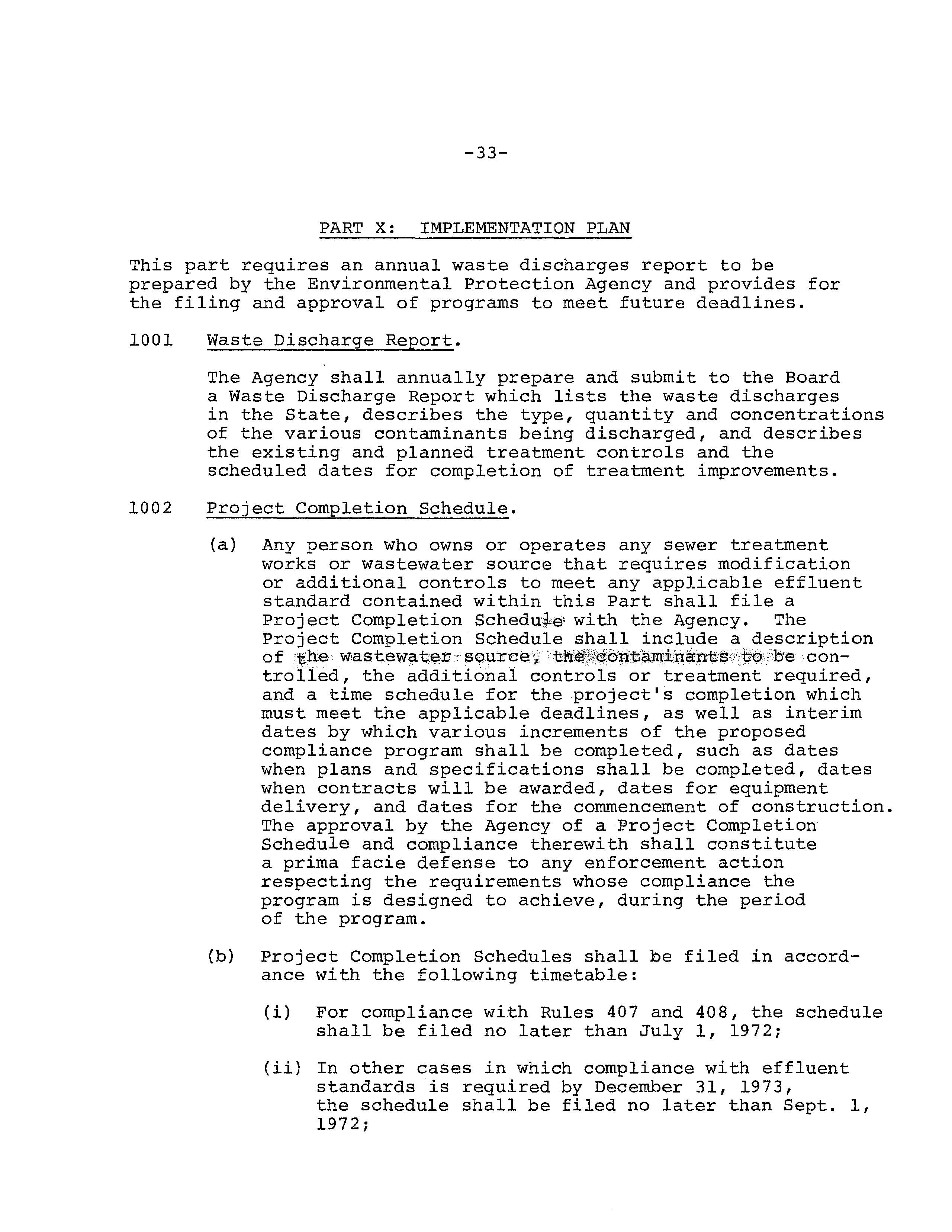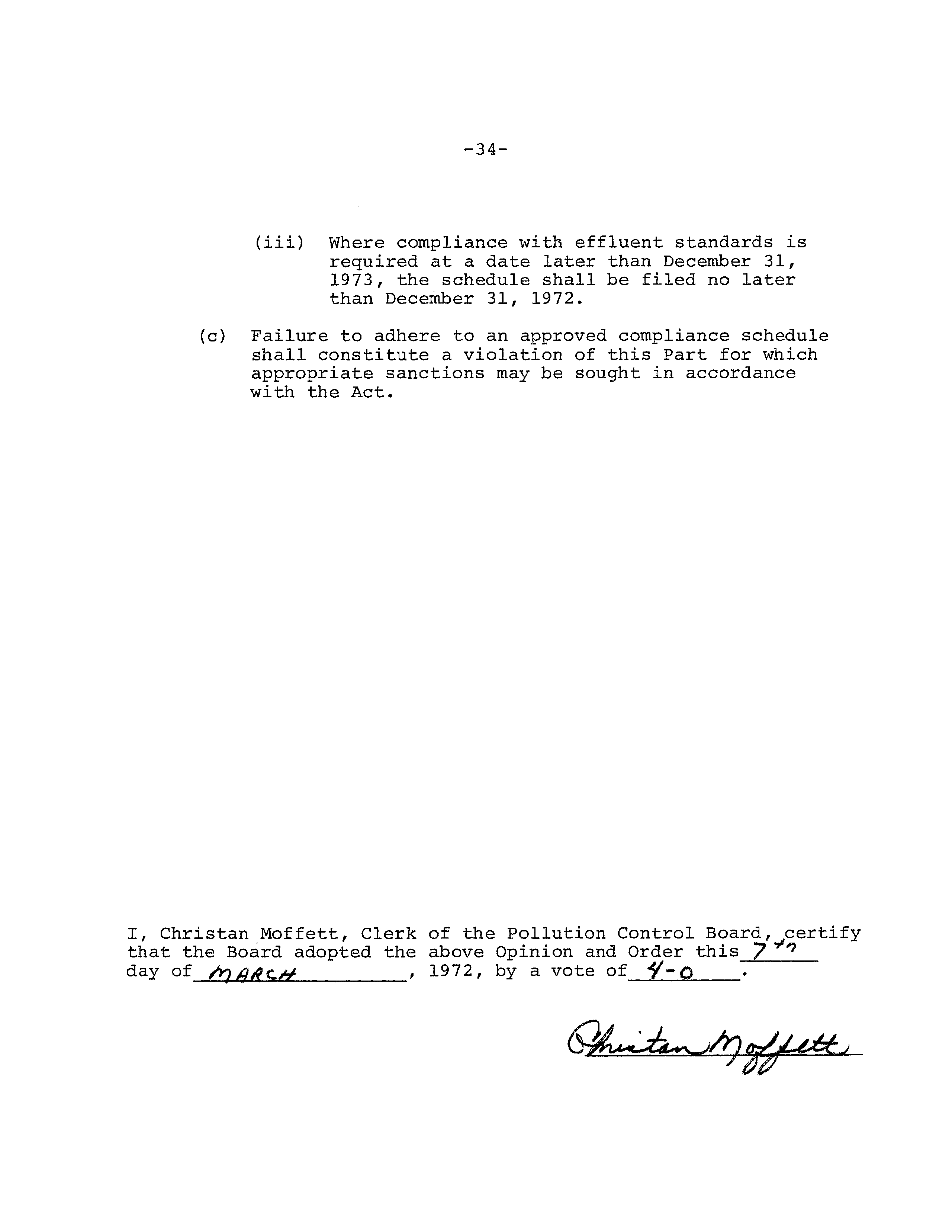ILLINOIS POLLUTION CONTROL BOARD
March
7, 1972
In the Matter of
#R 70—8
EFFLUENT CRITERIA
In the Matter of
#R 71—14
WATER QUALITY STANDARDS REVISIONS
In the Matter of
)
WATER QUALITY STANDARDS REVISIONS
)
#R 71-20
FOR INTRASTATE WATERS
(SWB-14)
)
Opinion of the Board
(by Mr. Currie):
On May 12,
1971,
we published a proposed Chapter IV of
the Rules and Regulations of the Pollution Control Board, comprising
a complete recodification and revision of all existing regulations
respecting water pollution.
Extensive hearings were held
throughout the State, from June
to October.
Upon studying the
transcripts and exhibits, we published a partial proposed final
draft on November 11, including principally those provisions,
many of them originally proposed in #R 70-8 and the subject
of separate hearings last winter, respecting effluent standards,
permits, and control of storm overflows.
On December 21 we
published a second proposed final draft containing additional
provisions considered at the hearings.
On January
6,
1972,
we adopted many of the provisions in the November
11 draft
(see
opinion and order of that date), postponing effluent standards
for deoxygenating wastes and for bacteria,
as well as permit and
overflow provisions.
Final hearings were held on these subjects
and on the December 21 draft,
and we today adopt final provisions
as to all remaining matters.
Today’s regulations supplement
and do not repeal those adopted January
6.
This opinion explains
todayrs
action.
In large part today’s draft is simply
a codification
of
existing water quality standards and associated provisions that
are now scattered throughout a number of separate regulations
that we inherited from the Sanitary Water Board.
The new
regulations, when adopted, will supersede the old except for
determining violations alleged to have occurred prior to the
effective date of the new regulations.
In addition, today’s
new regulations contain the following changes, among others:
1)
A more stringent dissolved-oxygen requirement for better
protection of aquatic life.
2)
The.designatio~nof additional waters, such as the~‘remaining
portions of the Illinois River, to be protected for aquatic
—2—
life and bodily contact.
3)
Additional communities required to go beyond traditional
secondary sewage treatment.
4)
Limited relief from the highest degree of tertiary treatment
for communities that can prove a more economical means
of
tertiary treatment sufficient to assure satisfactory water
quality and compliance with water quality standards.
5)
Compliance programs required in certain cases to assure
compliance with stream standards for ammonia and phosphorus.
6)
A two year acceleration of the deadline in most communities
for control of pollution from combined sewer overflows,
one of the State’s most serious water pollution problems.
7)
The highest degree of treatment required for sewage or
similar wastes discharged to Lake Michigan.
8)
Allowance for treatment lagoons that small communities
can afford and can operate successfully, provided water
quality standards can be met.
9)
A December, 1973 deadline for treatment beyond secondary,
based on recent changes
in applicable laws.
We have
allowed up to one year in past cases for compliance with
the Agency’s revised criteria respecting algae from
effluent polishing lagoons.
An additional six months
seems
a reasonable price for saving millions of dollars
under today’s new standard.
In addition, adherence to the
existing paper deadline would not assure compliance by
that date; most communities cannot meet that date in any
event.
10)
Year-round disinfection of sewage
treatment plant
effluents.
11)
A prohibition of discharges
to sewers that interfere
with the operation of treatment plants.
12)
A comprehensive permit requirement for new and existing
sources.
13)
Protection for underground waters.
A section—by—section discussion follows.
Rules
101-103 are standard statements of the Board!s authority
and policy, substantially as in present regulations, and a re-
pealer of obsolete provisions.
Rule 104 contains definitions
in addition to those adopted January
6.
The definitions
largely speak for themselves.
Since the preceding drafts we
have added an Agency—suggested definition of “Modification”
—3—
and revised the definitions of dilution ratio and population
equivalent as urged by the Institute and by the Agency respective-
ly.
Our earlier definition
of one P.E.
as 0.2 pounds
of BOD5
per day was based on a misunderstanding of an Agency guide-
line.
Part II is the heart of the water quality standards and
constitutes an updated version of the criteria now found in
regulations SWB-7 through SWB-15:
201
Mixing Zones.
Existing standards by and large provide
for “reasonable admixture”
of effluents in a mixing zone that
is not subject to the water quality standards.
This is necessary
unless effluent standards are to be as stringent as water
quality standards, which in some cases
(e.g., temperature,
see #R 70-16, Mississippi Thermal Standards, November 15,
1971)
would impose an unreasonable cost burden.
At the same time,
if the water quality standards are not to be undermined,
the.
area within mixing zones must be kept relatively small.
Technical Release 20-22
of the Sanitary Water Board,
long used
as
a guideline without the force of a regulation, provided
that reasonable mixing would be deemed to occur within 600 feet
from the point of discharge.
We have held that this figure
represents the understanding of the Sanitary Water Board in
adopting the reasonable mixture standard, at least with regard
to the larger rivers, and therefore have required that on the
Illinois, Wabash,
Ohio,
and Mississippi Rivers the standards
be met outside
a zone 600 feet in its greatest dimension.
See
Application of Commonwealth Edison Co.
(Dresden #3),
#
70-21
(March 3, 1971); Mississippi Thermal Standards,
#
R 70-16,
supra; Ohio-Wabash Thermal Standards,
#
R 71-12, June 28, 1971.
On the other hand, we have expressed doubt that such
a large
mixing zone could have been intended on small streams, since
a few 600—foot zones on such streams would undermine
the stream
quality standards altogether.
See EPA v. City of Champaign,
# 7l—51C, September 16, 1971.
The May 12 draft incorporated the 600-foot standard across
the board, but consideration of the Champaign case,
just cited,
suggests a more flexible test is desirable.
The basic standard
•today adopted, therefore,
is expressed in terms of the
principle that mixing zones must be kept very small in proportion
to stream volume.
Although the application of this principle
must be determined on a case—by-case basis, this approach appears
to be more.’ responsive
to the competing policy considerations
underlying the mixing zone provisions than does any rigid size
requirement.
In response to other testimony received,
today’s regula—
tion
alters the 600-foot linear zone—-here preserved as a
maximum-—to a zone no larger than the area of a circle with 600-foot
radius, by analogy to the Lake Michigan standard
(#R 70-2, June
9,
1971), recognizing that in flowing streams the shape of a plume
is likely to be long and thin in a downstream direction.
—4—
The earlier provision intended to prevent increasing the
size of the mixing zone by multiplication
of discharge points
has been reworded to avoid unintended restrictions.
The
formerly rigid provision requiring a fixed proportion
of the
stream as a zone of passage for fish has been made more flexible
in order to leave details to individual cases while preserving
the principle that thermal or other pollution blocks’must be
avoided.
This provision applies only to waters protected for:
aquatic
life.
202 Stream Flows.
This Rule provides that water quality standards
are to be met at all times except extreme
low
flows,
This provision
is the equivalent of that in existing regulations.
An exception
is provided,
as in the Ohio—Wabash and Mississippi thermal
standards,
for brief excursions of temperature that are not
likely to be harmful and that are the result of natural conditions
peculiar to temperature.
It is recognized that it may be
necessary in the future to provide some type of episode control
at times
of extreme low flow in order to avoid harm to aquatic
populations.
203 General Standards.
Today’s revision ~
principle that all waters should be protected against nuisances
and against health hazards to those near them;
that all waters
naturally capable of supporting aquatic life, with the exception
of a few highly industrialized streams consisting primarily
of effluents
in the Chicago area,
should be protected to support
such life; and that waters that are used for public water supply
should be clean enough that ordinary treatment processes will
assure their potability.
Consequently general standards for
water quality
are set that will protect most uses except public
water supply; more stringent standards are set for places where
water
is withdrawn for public supply; and more lenient standards
are set for those streams classified for restricted use.
The
general standards are found in Rule 203 and their discussion
follows.
They are taken largely from existing criteria for
aquatic life.
Stream use designations are found in Part III.
203
(a) preserves the existing requirements
for freedom from
nuisance.
203
(b) retains the existing
DR
values for aquatic
life.
203
(c) provides a phosphorus limit for reservoirs and lakes and for
streams tributary to them.
The evidence is strong that phosphorus
above this level in relatively still water can give rise
to
obnoxious algae blooms.
The evidence does not support
the
need for a phosphorus standard in other situations, and the proposal
for such a standard is here omitted.
•So is the earlier proposal
for an algae limit, which was too stringent to indicate the
—5—
presence of
a nuisance.
The evidence does not support any
numerical standard for algae, and we rely upon the nuisance
standard of 203
(a).
We have not defined “reservoir” or
“lake” for want of an adequate definition.
This will have to
be worked out on a case-by-case basis
in light of the policy
here expressed.
Not every navigation
dam
will be held to create
a lake for this purpose.
Despite the uncertainty,
it does not
seem appropriate to postpone necessary regulation for lack of
a perfect definition.
203
(d)
adopts the May 12 proposal
(6.0 mg/i for 16 hours
and 5.0 minimum)
for dissolved oxygen requirements for aquatic
life.
The present standard (5.0 and 4.0)
is not optimum
according to the Green Book of the National Technical Advisory
Committee on Water Quality Criteria.
The testimony of Dr.
John
Pfeffer of the Institute for Environmental Quality, discussed
in more detail below, strongly supports ‘the achievability of
this revised standard, often without the highest degree of treat-
ment that is feasible.
203
Ce)
retains existing radioactivity levels.
203
(f)
lists a number of important contaminants
as follows.
“Dissolved” values have been changed to “total” for reasons
given in the explanation of the proposed final draft of Nov.
11.
P~mmoniaNitrogen.
The present SWB-8 standard is 2.5 mg/i,
which the Green Book (supra)
says is acutely toxic to fish.
The earlier 1.0 proposal was based upon a Minnesota standard.
While the toxicity of ammonia is pH dependent, the Green Book
recommends a limit of 1.5 mg/l,
and that is here adopted.
Arsenic.
The May 12 proposed level of 1.0 mg/i was based
upon existing
SWB-8
standards and the recommendation of McKee
and Wolf, Water Quality Criteria, which is a well-respected
literature survey,
for protection of aquatic
life.
It is
adopted today.
Barium.
The May 12 proposal, adopted here, of
5.0 mg/i for
aquatic life was based upon existing SWB-8 standards and the
recommendation of McKee and Wolf.
BOD.
The May 12 draft proposed a stream standard of 7.0 for
biochemical oxygen demand
(5-day).
Thjs was intended to facilitate
determination of the degree of treatment required of dischargers
without resort to complex formulas for computing oxygen sag and
recovery.
The evidence is that the effect of a given level
of BOD on a stream
is too dependent upon reaeration rates to
make any prescribed standard meaningful.
We have omitted it
and will rely on the dilution ratios of Rule 404, together
with proof of violation of dissolved oxygen levels by stream
studies or otherwise, until more adequate proof is presented
to support a BOD standard.
—6—
Boron.
The May
12 and today adopted level of 1.0 mg/l is
based on evidence that higher levels can harm irrigated crops.
While 100
irrigation is unlikely in Illinois, the uncontrolled
discharge of large quantities of boron is clearly undesirable.
We have proposed no effluent standard because of the lack of
evidence as to treatment methods.
The testimony suggests that
compliance with the stream standard should not be very difficult.
Cadmium.
The 0.05 value proposed on May 12 and adopted today
is the same as the present SWB-8 for aquatic life.
McKee and
Wolf suggest that an even lower value might be appropriate to
protect some fish.
Chloride.
Chlorides are tolerated by aquatic life in relatively
high concentrations; Professor Lackey, a recognized expert
in fish biology, testified that 500 mg/i would be a safe limit,
and there was no substantial dispute.
This value will also,
according to the evidence, protect against any serious problems
in drinking water.
The undesirability of an overly tight chloride
standard is underlined by the high cost of chloride removal
as well as the relatively innocuous nature of the material.
Chromium.
There is a dispute in the evidence as to tht toxicity
of chromium.
McKee and Wolf support the testimony that the
toxicity of chromium toward fish and man has been exaggerated,
but stress
the toxicity of small amounts of hexavalent chromium
to daphnia and other important fish foods.
The values
here adopted preserve the existing SWB-8 aquatic standards
for hexavalent
(0.05 mg/i)
and trivalent
(1.0)
chromium since
McKee and Wolf appear to justify the distinction with regard
to effects on fish foods.
The May 12 proposal was a single
standard of 0.05.
The federal government asks that we adopt
a single strict standard since trivalent chromium may be
converted to hexavalent after discharge.
If it does the
hexàvalent standard will apply,
and we see no reason for a
change.
Copper.
Existing copper standards vary:
SWB-8’s
is 0.04
mg/i, while SWB—l2’s
(Mississippi River)
is the same
(0.02)
as
that proposed May 12 and adopted today.
This figure is based
on McKee and Wolf’s recommendation for fish and aquatic
life.
Important fish foods
are,readily killed by low concentrations
of copper, and McKee and Wolf say 0.025 mg/i has been found to
kill most fish in
8 hours
in the presence of 1.0 mg/i of zinc.
Cyanide.
The present SWB-8 standard of 0.025 mg/i, here adopted,
is that recommended by Orsanco.
Twice that concentration,
say McKee and Wolf,
has killed fish in a short time, while
trout were found to survive
27 days
at 0.02 mg/i.
The May
12
draft proposed 0.01 based upon the fact that such a level,
not treatability,
is the goal in setting water quality standards
for general uses.
—7—
Fluoride.
Fluoride can delay the hatching of fish eggs and has
been reported by McKee and Wolf to kill trout at concentrations
ranging from 2.3 to 7.2 mg/i.
They recommend a standard of 1.5
mg/i.
The figure of 1.4, here repeated from the May 12 draft,
is in line with that recommendation and also should assure a
potable supply.
Iron.
The 1.0 mg/l standard proposed May 12 and adopted today is taken
from the existing SWB—8.
McKee and Wolf make no
firm
recommendation
but report that dogfish survived a week’s exposure to
1 to
2
mg/i of iron.
Other species are said to have shown a lower toxic
threshold.
Lead.
0.1 mg/i, proposed May 12 and adopted today,
is the present
SWB-8 aquatic standard and supported by McKee and Wolf’s recommendation
of 0.1,
a level above which lead is
lethal to some fish and begins
to interfere with the breakdown of oxygen—demanding materials.
Manganese.
There
is no existing aquatic standard.
The standard of
1.0
(May
12 and today)
is based upon McKee and Wolf’s report
as to fish toxicity anddshould be easy to meet.
Nickel.
There is no existing standard.
McKee and Wolf report
one study finding that sticklabacks die as low as 0.8 mg/i,
but that others find nickel less toxic than iron or zinc.
Today’s rule,
like that proposed
May, 12,
is ‘1.0 mg/i.
Phenols.
There is conflicting evidence as to the harmful level
of phenols.
The limiting value, according to the Green Book,
is that concentrations above 0.1 mg/i impart a bad taste to
fish.
The May 12 draft and today’s rule substitute 0.1 in place of the
present SWB-8 standard of 0.2.
Selenium.
No present aquatic standard exists,
bu.t McKee and
Wolf say 2.0 mg/i kill goldfish in eight days.
The May 12 proposal of
~2.0therefore seems” too high, and 1.0
is here adopted,
as
in the
proposecffinal
d~äft,
in order to keep the water below the harmful level.
Silver.
The present
SWB-8
standard is 0.05 mg/i, but McKee
and Wolf report lethal doses to some fish at levels an order of
magnitude lower.
Accordingly,as proposed ~May12., we adopt
0.005 mg/I.
Sulfates.
As
in the case of chlorides, some limit seems desirable
to protect stock watering and fish~Dr. Lackey suggested that
500 mg/i would afford adequate protection for fish;
McKee and
Wolf give the same figure for stock watering; and this level
should avoid serious adverse effects on public water supplies as well
according to McKee and Wolf.
—8—
Total Dissolved Solids.
This level
of 1000 mg/i too is based
largely on Dr. Lackey’s testimony, confirmed by other witnesses
and by McKee and Wolf,
that aquatic life should not be harmed.
Zinc.
1.0
is the present SWB-8 aquatic standard proposed May
12 and adopted here.
McKee and Wolf suggest that this is a safe
ievel if the water is not particularly soft.
Additional chemicals were suggested by various witnesses
for inclusion in the table, such as antimony, cobalt,
and tin.
We recognize the desirability of adding more parameters and will
welcome specific suggestions for future additions, but codification
of the present standards should not be delayed while new parameters
are explored.
The May 12 draft contained a limit of 2.0 mg/i
for the
aggregate of toxic substances indicated by an asterisk in the
above
table.
While the synergistic effect of various heavy
metals or other toxics
is
a matter of considerable concern,
we have insufficient basis for setting any particular number
and therefore omitted this provision from the proposed final
draft,
leaving the question of synergism to be dealt with by
general provisions such as paragraph
(h)
of Rule 203, below.
The federal government calls our attention to a synergism
formula in the NTAC Green Book, but we think opportunity for
hearing should be afforded prior to the adoption of such a
provision.
203
(g)
tightens the bacterial limit from that designed for
secondary contact to that described as safe for primary contact.
This has the same effect
as the May 12 draft, which provided
a separate category of waters designated for primary contact
but which designated all general waters for this use.
Since
disinfection is required of all relevant effluents, achieving
the lower level should pose no great additional difficulty.
Even if waters are not recommended for swimming because of other
problems such as turbidity, barge traffic,
or dangerous currents,
they should not pose a health hazard to those who do use them.
203
(h) retains the present SWB-8 general provision that no
~u’bs~t’an~es
shall be present in amounts representing a stated
percentage of their toxic value to fish.
This is most necessary
because no regulation can possibly list all contaminants that
are of concern.
The May 12 list of pesticides
is omitted.
It was obviously
incomplete and seems better left to the general toxicity provisions
of Rule 203
(h).
—9—
203
(i)
has been amended to incorporate the newly adopted
temperature standards for the Mississippi, Ohio,
and Wabash
Rivers and to preserve the existing maximum values for other
streams
(except to substitute 90°for
93 on the former industrial
sector of the Illinois) pending further evidence
as to actual
temperature.
The federal EPA urges us to adopt monthly
maxima for other streams, which we shall be happy to do when
we
receive the necessary evidence.
We are indebted to Mr.
Clarence Stuebe for certain data from the water intake at
Peoria that suggest the standard perhaps can be significantly
tightened for some portions of the Illinois River.
The separate criterion for primary contact
(formerly
Rule 204)
is omitted for reasons given under Rule 203
(g)
above.
Rule 204 states standards for public water supplies.
Despite the conclusion of McKee and Wolf that the recommended
Public Health Service standards for chlorides, sulfates,
and
total dissolved solids
in desirable drinking water
are. tighter
than necessary as
a regulatory matter, we have put back into
today’s regulation the existing requirement that all Public
Health Service standards be met, on the recommendation of
both federal and state EPA’s and evidence that most Illinois
waters are safely within these standards.
Further proof of
hardship is necessary to modify
these existing standards.
We have also reinstated the provision that the public supply
standards need be met only where water is withdrawn for public
supply.
This provision will assure that water is satisfactory
wherever it is taken, without requiring expensive cleanups
of effluents where
the water is not used for public supply.
The construction of new public supply intakes will in some cases
therefore require additional treatment of effluents upstream.
Since general criteria apply to all waters designated for
public supply, the present regulation omits separate requirements
for those parameters whose general standards are tight enough
to protect public supplies; boron, chromium, copper,
fluoride,
mercury, silver, and zinc.
The remaining standards are
based largely upon the Public Health Service standards,
as
amplified by the Green Book and by McKee and Wolf.
While
the PHS explicitly states that its standards are intended to
prescribe the quality of finished rather than of raw water,
it is clear from the evidence that many of the metals
and
other contaminants here listed are not substantially affected
by ordinary water supply treatment,
and therefore,
as the Green
Book recommends, the raw water must itself meet the standard
to assure satisfactory finished water.
The standards for barium, cadmium,
lead, and selenium--
together with chromium and silver, which are covered by
general standards——are taken from the Public Health Service
—10—
standards whose violation in finished water results in rejection
of the supply.
These are toxic materials not removed by ordinary
treatment of raw water.
These numbers represent existing SWB-8
standards.
~Forarsenic, the present standard, taken from the
PHS rejection standard,
is 0.05;. as proposed May~i2, we have
‘tightened this to 0.01, which the PHS gives as the level that
should not be exceeded if better supplies are available.
It
seems reasonable to require that supplies be made to meet that
recommended standard.
The standard for nitrates and nitrites
is an important one.based upon health dangers to infants, and
these ions are not removed by standard treatment.
Other existing SWB-8 standards preserved in today’s list
include carbon chloroform extract
(CCE)
,
a measure of objectionable
organic material; iron, which like the additional parameter of
manganese for which there has been no standard causes problems
of taste and of laundry color; methylene blue active substances,
which cause taste problems and indicate recent sewage pollution;
and phenols, which also cause taste problems.
Cyanide
(SWB-8
prescribes the same value of 0.025 mg/i as for aquatic life)
is reduced,as proposed in May;.~to0.01 mg/i on
the basis of the recommended PHS standard.
The existing oil
standard has been quantified.
The other concentrations discussed
in this paragraph are based on PHS standards.
~Theextent to
which these parameters are reduced by ordinary treatment is
dispu”tèd
The PHS says at least
some
of them are, and there-
fore fth~Ii~sthat raw water need not meet such strict standards;
the Green Book says otherwise, and for safety’s sake these
standards, mostly taken from present law,
are here preserved.
As
in the general standards,
specific pesticide numbers
are omitted.
A new paragraph
(c)
is intended to guard against
the presence of toxic substances, for which numerical standards
are not provided.
205
Restricted Use Standards.
This Rule has been substantially
revised to provide that aquatic life standards for various toxic
materials need not be met since these waters are not protected
for aquatic life.
The standards are intended to assure against
nuisance conditions,and,
to protect other waters downstream,
the water quality in restricted waters is required to meet the
applicable effluent standards.
The temperature standard has
been modified in response to a suggestion, from Commonwealth
Edison Company,
in order to avoid expensive cooling devices
that are not necessary to the avoidance of nuisances
or’ safety
hazards.
206 Lake Michigan.
Certain parameters taken from existing
standards are preserved to require this high-quality lake to remain
especially clean for esthetic and recreational purposes, in
accordance with the important non-degradation policy.
Similar
provisions
to protect other waters of unusually high quality have
been omitted from the present draft for lack of evidence as to
which waters are entitled to such protection.
The Lake Michigan
provisions establishthe principle of special protection for
—11—
high-quality waters,
and additional waters may be added in the
future when the evidence so demands.
The Lake Michigan temperature standard recently adopted
has been inserted.
207
Underground Waters.
Protection of groundwater is of paramount
importance.
The provision has been amended to make clear it
does not protect natural brines or deal with the problem of
deep—well disposal except to assure protection of present or
potential water supplies.
208 Nondegradation.
This preserves the present prohibition of
unnecessary degradation of waters presently of better quality
than that required by the standards, recognizing that the
standards represent not optimum water quality but the worst
we are prepared to tolerate
if economic considerations so
require.
Part III contains water use designations.
All waters are
designated for general use except those in the restricted
category, which has here been broadened in response to testimony
to include waters whose flow is too low to ‘support aquatic
life.
This should relieve the burden of treatment beyond the
effluent standards for discharges to intermittent streams.
Such extra effort is difficult to justify when it will not
result in a satisfactory ~quatic life because of insufficient
flow.
Since the publication of the proposed final draft
we have also designated as restricted certain additional
heavily industrial channels’ in the Chicago area.
The evidence
establishes that even with the most advanced treatment and with
stormwater overflow control aquatic life standards for dissolved
oxygen
(and perhaps also ammonia) cannotbe met in portions of
the Chicago River System, and that meeting the aquatic
temperature standards in these same areas,
as well as in
the adjacent section of the Des Plaines River, would require
cooling towers costing tens of millions of dollars and produce
doubtful benefits in terms of stream improvements.
In the case
of the North Shore Channel, where the evidence is that an
intermediate oxygen level
is achievable, we have prescribed
it.
We urge the Metropolitan Sanitary District to give serious
consideration to such further measures, including in—stream
aeration, as many offer promise of improving the quality of
its restricted use waters.
Part IV.
Several Rules
in this Part were adopted January
6.
Rules 404 and 405, earlier postponed, are adopted today.
404 Deoxygenating Wastes.
This important section is an attempt,
much modified in wording from that originally proposed, to
restate the existing treatment requirements for BOD and suspended
solids in a single document, with several deliberate changes.
Th’e task
is unfortunately compliôated by the fact that several
different levels of secondary treatment are presently required
for different waters and that new compliance dates must be set
for any new requirements
in order to allow time to build treatment
works.
—12—
The basic requirement, which is close to that of existing
law,
is that all oxygen—demanding wastes shall meet standards
of
20 mg/i of BOD and 25 of suspended solids.
As we said in
our January
6 opinion, prescribing the uniform use of readily
available technology as a minimum serves to prevent local
nuisances, to avoid premature exhaustion of assimilative
capacity,
and
to further the established federal and state
policy against degradation of clean water.
As proposed by the Agency
(#R7l-20), the July,
1972 date
for compliance on intrastate streams
(SWB-l4)
is made applicable
to industry, as it was generally assumed to be before our
decision in Borden Co.
v.
EPA, PCB 71-23
(May 24,
1971).
Additional time
is allowed for sources on certain rivers, in-
cluding the Illinois and the Wabash, where present secondary
requirements are somewhat more lenient,
and for sources affected
by the new dilution standard of Rule 401(a), but as in the
case of the Mississippi River
(#R 70—3, Jan.
6,
1971)
,
the 20
and 25 standards appear readily attainable and represent the
minimum of acceptable treatment.
An exception, however,
allows
slightly less efficient treatment for smaller fac~Llities in
order to permit the use of trickling filters, which are relatively
economical and efficient in the absence of sophisticated operation,
except within the Metropolitan Sanitary District, where present
law prescribes the 20 and 25 standard for all sources, presumably
for the good reason that the density of sources
is great enough
to make large combined treatment facilities practicable and to
discourage the use of less effective trickling filters.
This
exception also has precedent in our revised Mississippi River standard.
The secondary treatment requirement,
as noted above,
is a
minimum standard representing ordinary good practice.
In some
cases,
as we said in our January 6 opinion,
because of the low volume of the receiving stream or the
large quantities of treated wastes discharged, meeting
these
(minimum)
standards may not suffice to assure that
the stream complies with water quaiity standards set on
the basis of what is necessary to support various water
uses.
In such cases the very nature of water quality standards
requires that additional measures be taken beyond those
required by ordinary good practice to reduce further the
discharge of contaminants to the stream.
Treatment requirements beyond secondary are
‘based in
substantial part upon this principle.
Sanitary Water Board
regulations, preserved by the Environmental Protection Act,
require additional treatment as the ratio between stream flow
and effluent volume
(dilution ratio)
becomes smaller.
In general,
BOD and solids effluent standards were set at 10 and
12,
respectively, for dilution ratios of less than
2 to
1 and at
4 and
5 for less than
1 to
1.
—13—
The basic principle of this scheme is preserved in the
revised regulations, with several important changes.
First,
we require the best available treatment
(BOD 4, solids
5)
for discharges to Lake Michigan, a high-quality body of water
with low outflow rate that deserves maximum protection from
possible contamination.
The principal discharger to the
Lake, the North Shore Sanitary District,
is already committed
to removing its effluents from the Lake altogether
(see League
of Women Voters v. NSSD,
#
70-7, March31 and June 26,
1971).
The additional requirement of similar treatment before discharge
to other high—quality waters, proposed May
12, is omitted
for the time being pending identification of other waters
entitled to such special protection.
The other changes we have made in this Rule are based
primarily upon careful testimony presented by Dr. John Pfeffer
of the Institute for Environmental Quality with respect to the
need for and costs
of treatment beyond secondary.
Dr. Pfeffer’s
first point is that, given a base of secondary treatment,
the increased capital and operating and maintenance costs
for achieving the next level of treatment with polishing
ponds or microstrainers are not significant.
Therefore,
the requirement for effluent from an activated sludge
process to satisfy the BOD5 of 10 mg/l and organic suspended
solids of 12 mg/i adds a relatively insignificant cost
to wastewater treatment.
This testimony is supported by the testimony of consulting
engineer Hjalmar Sundin that tertiary filtration will achieve
an effluent meeting the 10-12 standard, that the cost of such
treatment is quite “reasonable”
as compared with that necessary
to meet 4—5,
and that “the economic breakpoint favors
a
10 mg/i
standard for BOD5”.
See also the testimony of consulting
engineer John Cormack with respect to the plants of the North
Shore Sanitary District and filtration.
With respect to the
desirability of such treatment,
Dr. Wesley Pipes urged the
Board
to extend the effluent requirements of 10 mg/l BOD and
12 mg/i solids to all discharges having a dilution ratio
of less than five to one in order to reduce the stream BOD
and protect against alterations
in stream biota toward
species more tolerant of pollution.
As in the proposed final
draft, we accept Dr.
Pipes’s suggestion because we believe
the added protection worth the relatively small incremental
cost of reducing effluents
to this level when less than five
volumes of dilution water are available.
This revision did
not raise much controversy.
—14—
Dr. Pfeffer’s second point, supported once again by
Sundin and Cormack and by numerous representatives of municipal
treatment works,
is that the incremental cost of reducing effluents
beyond the 10-12 standard to meet 4 mg/i of BOD and
5 of solids
is considerably greater.
Moreover, he argues, in many cases
these costs need not be incurred in order to maintain satisfactory
stream quality.
Using a modified from of the Streeter-Phelps
equation, he demonstrates that, given certain conditions
including
a stream reaeration rate he says is not atypical for small streams
with low dilution ratios, the dissolved oxygen standards we today
set for aquatic life can often be met with effluents of
10
rather than
4 mg/l of BUD even in the total absence of dilution.
The large sums spent for the last drop of removal, he concludes,
may be spent for no apparent benefit.
That substantial sums
may be at stake is clear from Cormack’s testimony that the North
Shore Sanitary District can cut tertiary treatment costs at
three plants
from $11,000,000 to $3,000,000 by substituting
filters under the Pfeffer proposal for the carbon absorption
columns planned to meet the existing standard.
This argument stands uncontradicted on the record insofar
as it pertains to dissolved oxygen.
Dr. Pipes correctly
points out that oxygen is not the sole purpose of the effluent
standards,
as sludge banks can cause a shift toward more pollution—
tolerant life forms.
Dr. Pfeffer responds that an effluent
containing as
little as 12 mg/i of suspended solids, finely
divided and not readily settleable,
should not result in sludge
banks detrimental to aquatic life.
Dr. Pfeffer’s recommendation, based on his above testimony,
is that relief from the dilution-ratio requirement of
4 mg/i
BUD and
5 of solids be provided upon proof in the indiv’thdual
case that stream standards for oxygen will not be violated.
The
Agency agrees.
With modifications noted below, we adopt this
recommendation.
The purpose of treatment requirements beyond
secondary is to assure satisfactory stream quality, not to impose an
acceptable minimum of uniform treatment.
The dilution ratio is a
very rough guide to the necessity for such treatment.
Based as
it
is upon the single relevant factor of available dilution water,
it overlooks both the critical rate at which the stream
accepts additional oxygen from the air and the important question
of BUD concentration in. the water that is to be used for dilution.
For the relatively inexpensive increment to a 10-12 standard,
and as
an indicator of the need for proof that stream standards
can be met without the expense of a 4-5 effluent, the dilution
ratio is
a useful tool.
But, like standard emission factors
in proof of air contaminant emissions, the naked dilution ratio
should not automatically result in enormous expenditures for
the best level of treatment if it can be shown that the water
quality standards can be met at considerably less cost.
—15—
This conclusion is the more compelling in light of the
fact that for many communities completion of facilities to
achieve the 4-5 standard will by no means exhaust the need for
water pollution control spending or assure that water quality
standards will be met.
As Dr. Pfeffer points out, the BUD5
test principally measures the carbonaceous BUD and ignores
the often delayed but eventual oxygen dernend exerted by ammonia,
to which we have directed
our
attention in the regulations
adopted January
6.
The ultimate nitrogenous oxygen demand of
a waste containing a normal 20 mg/i of ammonia
(measured as
nitrogen)
is 91 mg/i, nine times the carbonaceous BUD remaining
after treatment to an effluent of
10 mg/i.
We agree with Dr.
Pfeffer that it makes little sense to
spend money reducing
carbonaceous BUD from 10
to
4 if the much greater nitrogenous
demand is ignored.
The State Water Survey has already found
that oxygen standards in the Illinois River will not be met,
even with advanced treatment, unless ammonia is oxidized be-
fore discharge in the largest plants.
The same may be true
in other streams.
Inherent in Dr. Pfeffer’s proposal,
as
several witnesses representing municipal dischargers expressly
agreed,
is that a considerable number of plants may be required
to do something about ammonia in addition to those already subject
to the January
6 effluent standards.
Moreover, even if
ammonia’s oxygen demand is not exerted until sufficient
dilution water downstream is available to protect stream oxygen,
the ammonia itself may be toxic to fish and require treatment
on that basis.
Further, it is clear from the evidence that
discharges from combined sewer overflows in many parts of the
State may make it impossible to achieve the water quality standards
even with the best available treatment at the plant.
In short, there may be higher priorities for water pollution
control
in many communities than the need for an effluent of
4 mg/i of BUD and
5 of suspended solids.
Donald Matchke of the
Cook County Clean Streams Committee and the Izaak Walton League,
voicing the thoughts of a conservationist, expressed in an
early hearing a concern over exactly this question of priorities,
fearing lest the existing Sanitary Water Board requirements
leave us with many expensive treatment plants and unsatisfactory
waters:
We have to grapple with the gross problems that are
contributing gross problems to the stream.
These
are the combined storm water and combined sewer overflows,
and also the solids that escape from a treatment plant.
.
These are two main significant problems which seems to me
they ought to be tops with us
as far
as solving rather
than going for 98 percent treatment or four or five parts
BUD as ultimate treatment in small receiving water courses.
—16—
My one recommendation for tertiary treatment, outside of
your own, which is nitrogen and phosphorus removal, plus
chlorination, would be filtration of effluent because
this contributes to a bottom sedimentation problem that
is
a common problem from one end of the state to the other.
It is something that we can do relatively economically.
We will take a BUD credit for doing it.
.
.
.
We have
to
grapple with the main problem, uncontrolled discharges
of storm water and combined sewer overflows.
Otherwise
we are going to spend a great deal of money in the next five
years and the tertiary treatment,
and the comment made
earlier, going to apply, there is going to be no benefit
seen.
The rivers are going to look just as bad unless we
choose the priorities.
They will look just as bad after
tertiary treatment goes
in.
There
is always the contention that all of the suggested things
should be done, that money is
no’,
object.
But in light of the
notorious difficulties of municipalities in raisins
enough
money to finance the most necessary treatment projects,
as well
as the general undesirability of wasting money, we think it
appropriate to reorder our priorities somewhat along the lines
suggested by Mr. Matchke in order that limited funds will provide
the maximum benefit in terms of actual stream improvement.
Accordingly, we have provided an exception from the effluent
standard of
4 mg/i BUD and
5
solids, upon proof that an effluent
of 10 and 12 will suffice to achieve compliance with all
applicable water quality standards.
The burden is on the
discharger to make that proof or to meet the stricter standard.
Other sources discharging to the same stream must be taken
into account, although the applicant is entitled to assume
that others will bring themselves into compliance with their
own effluent standards.
We require proof that undesirable
bottom deposits will not be caused, to satisfy the most serious
question raised by Dr. Pipes; and that~aprogra ~of ammo~•~niacontrol
and of combined—sewer overflow control, where necessary, be
provided at the time of applying for an exemption.
What the
new rule says
is that it is the discharger’s obligation to
achieve satisfactory stream’ quality; he should demonstrate
to the Agency how that is
to be done.
The exemption does not apply to the three huge plants of
the Metropolitan Sanitary District of Greater Chicago.
Dr.
Pfeffer and his committee agreed it should not; the District
itself testified to the enormous population equivalent load
—17—
discharged from those plants even after a high level of treat-
ment; and sophisticated models presented by the District and
others demonstrate that dissolved oxygen in the receiving
streams cannot meet the
6 mg/i level even if the best treat-
ment
is provided.
We cannot under the circumstances be content
with less than the best in hopes that someday these channels
may be upgraded to the status of an asset rather than a
liability.
Nor does the exception apply to Lake Michigan,
where the high treatment requirement is imposed to protect
the pristine esthetic quality of a special body of water.
An additional revision is based upon testimony that the
present effluent requirements for low—flow streams
(less than
1
to
1
ratio) effectivelyprohibit use of three—stage lagoons,
which
according
to
‘the
Institute
are
the
most
dependable,
economically
reasonable
method
of
.advanced
treatment
for
small
communities that cannot afford expensive operators.
Moreover,
the lagoons
are said to achieve a satisfactory reduction of
the original sewage contaminants; mudh of what goes into the
stre:axn is likely to be algae.
We have agreed’ to allow such
lagoons ‘in small communities
to exceed
th’e tighter effluent
standards so long as water quality standards are met.
The timetables for compliance with this Rule are necessarily
somewhat complex,
as they attempt to adopt some existing dead-
lines and to prescribe new ones where new treatment require-
ments’ are imposed.
No simplification appears practicable
without either relaxing existing deadlines or giving
insufficient time to meet new requirements.
Individual time-
tables in the present regulations, many of which required compliance
before now, are preserved by reference as the basis for en—
forcement purposes.
The July,
1972 date set for secondary
treatment on intrastate streams jrest~ted~
The
December,
1973 ~.aterecently set for
secondary treatment on the M~ssassippi~Rive~ris rata~ned,
as is the 1977 date for advanced treatment ~inthe ~la-rg~
plants of the Metropolitan Sanitary i~astrict
2Yhree years,
a re~asonab1~
‘pei’iod accoid.ng to ~therecord in the
Mississippi ~,ivercase
(R 70-3), i~~alibwediformeeting all
new
requir~meflt$
•
We
have
allowed
until
December
31,
1973
for
compliance
with
most existing requirements for treatment beyond secondary.
In
many cases the original deadline was July, 1972, but according
to Director Blaser of the Agency most communities have fallen
behind that schedule, in large part because of the unavailability
of federal aid funds.
We have held that the absence of federal
money is no excuse for disobeying the law, and we would not
extend the deadline merely because people have missed it.
—18—
But we have already had several occasions, e.g., EPA v. City
of
Marion,
#71-25
(Oct.
28,
1971),
to
observe
that
a
new
EPA
technical
release
issue
in
the
summer
of
1971,
just
as
a
number
of communities had prepared their plant for supplemental
treatment,
took many people by surprise in requirment the removal
of algae from polishing lagoon effluent in order to assure
meeting
the
effluent
standards.
On
the
basis
of
this
surprise
we
have
granted
variances
permitting
six
months’
to
a
year’s
extension
of
the
1972
deadline
for
communities
forced
to
draft
new
plans
in
midstream
by
this
new
policy,
as
in
the
Marion
case
itself.
Moreover,
our
acceptance
of
Dr.
Pfeffer’s
revised
effluent
standard
permitting
individual
evaluation
of
the
need
to
go
beyond
10
mg/i
of
BUD
and
12
of
solids,
if
it
is
to
be
meaningful,
must
include
a
brief
period
of
time
in
which communities
affected
may
find
out
and
demonstrate
whether
or
not
they
can
take
advantage
of
the
revised
standard.
We
therefore
allow
until
Sept.
1,
1972
for
the
submission
of
a
program
for
achieving
compliance,
which
must
be
approved
by
the
Agency,
and
until
the
end
of
1973
to
complete
construction.
Because
the
communities
affected
are
those
previously
under
a
1972
deadline,
we
do
not
believe
so
much
lead
time
is
required
as
in
the
case
of
starting
from
scratch
with
a
more
stringent
requirement,
for
which
financial
arrangements
must
be
made.
The
Marion
case
gives
some
indication
of
the
time
that
may
be
required
to
adjust
to
some
of
the
changes
made.
The
fact
that
six
months’
delay
in
treatment
plant
completion
may
result
from
adoption
of
the
Pfeffer
proposal
we
do
not
be-
lieve
to
be
reason
enough
for
blazing
full
stream
ahead
on
what
may
be
a
wrong
course.
The
saving
of
money
for
more
important
uses,
the
more
rapid
attention
to
the
critical
problems
of
combined
sewers
and
ammonia,
and
the
fact
that
most
communities
were
in
default
of
the
old
deadlines
all
militate
against
keeping
the
old
rules.
In
fact
we
suspect
the
December
1973
date
is
not
far
from
when
many
cummunities
would
actually
have
complied
with
the
old
rules;
retaining
the
paper
requirement
of
July
1972
would
not
mean
compliance
by
that
date.
If
a
more
substantial
delay
were
at
issue,
we
should
be
likely
to
reject
the
Pfeffer
proposal.
Better
a
plant
that
is
more
costly
than
necessary
than
continued
pollution.
Six
months’
delay
we
can
justify.
But
anyone
who
cannot
prove
his
case
for
an
exemption
in
that
time
should
go
ahead
and
build
to
meet
the
more
stringent
standard.
We
need
hardly
say
that
the
slippage
in
this
program
that
makes
that
statement
possible
is
a
cause
for
grave
concern,
as
we
have
pointed
out
in
numerous
opinions,
e.g.,
City
of
Mattoon
v.
EPA,
#71-8
(April
14,
1971),
and
that
it
must
not
be
permitted
to
happen
again.
We
set
new
dates
because
we
have
set
new
requirements,
not
because
local
officials
have
chosen
to
disobey
the
law.
We
will
not
tolerate
a
similar
slippage
—19—
under the revised program.
Substantial money penalties,
as well
as
prohibition
of
additional
connections,
are
a
distinct
possibility
for communities that do not make diligent efforts to meet the new
deadlines.
Paragraph
(c)
provides for averaging in accordance with the
suggestion of the State Water Survey, based upon actual treatment
plant observations under good operation.
405 Bacteria.
Summer disinfection of bacterially contaminated
effluents by various dates no later than July 1,
1972, has been
required by the regulations
for some time, with varying compliance
dates and with more stringent requirements for discharges to
waters designated for primary contact
(swimming).
The dangers
of germs are also present to those who go to the waters
for various purposes in winter, and the lower level prescribed
for primary contact should be readily achievable wherever
disinfection is practiced.
The additional safety seems well
worth the additional cost in chemicals.
Part V imposes reporting requirements similar to those of
present
law (SWB-6).
Small changes have been made to provide that expensive
monitoring need not be done for contaminants not likely to be found
in an effluent.
Access for Agency testing
is requ±r~ed.The Agency
asks us to add
a requirement that records be kept.
We invite a
proposal for amendment to this effect on which a hearing may be
held,
as the suggestion was received too late to allow public comment.
Part VI.
Rule 601, dealing with breakdowns and spills, was a
adopted
January
6.
602 Combined Sewers and Treatment Plant Bypasses.
It is
generally acknowledged that one of the most serious water
pollution
problems
throughout
Illinois
is
that
resulting
from
sewage flows far in excess of treatment or even sewer capacity
during wet weather.
Solution of this problem is necessary if
all our other regulations are to result in visible improve-
ment of water quality.
Methods exist for capturing various
levels of storm flows and of giving them various levels of
storm
flows
and
of
giving
them various levels of treatment,
some of the more sophisticated of which were described by Mr.
Bryan of Rex Chainbelt at our Alton hearing.
One plainly avail-
able solution, which
is being put into effect by the North Shore
Sanitary District,
is retention of overflows for later routing
through the regular treatment plant for complete treatment to meet
the effluent standards.
Occasional flows too large to be held al-
together will be given primary treatment and disinfection before
discharge.
See League of Women Voters v. North Shore Sanitary Dis-
trict,
#70—7, March 31 and June
26,
1971).
A number of wet—weather
control programs of other communities, many of them quite im-
pressive, were described at length in the record.
Our
initial
proposal
would
have
required
that
all
such
flows
be treated to meet the effluent standards.
The evidence is
strong
that the costs of complete treatment climb sharply and the benefits
—20—
fall off rapidly if control of the hundred-year storm is
contemplated.
Both the degree of treatment and the percentage
of flow that should be treated are matters that we cannot
determine across the board on the present record without
regard to the needs of individual streams,
and therefore we
have
modified
the
proposal.
What we adopt today is
a restatement of existing law, which
requires control of pollution from combined sewer overflows
and treatment plant bypasses.
The degree of treatment required
and the amount of flow that must be captured are left to case-
by-case determination by the Agency subject to certain guide-
lines
based largely upon prior Agency interpretation of present
law.
The
very
poliutionai
“first
flush,”
which
the
Agency
is
to define in each case according to the facts, must be given
full treatment; at least ten times the dry weather flow must
receive primary treatment and disinfection; and the Agency
is to require such further treatment as may be necessary to
prevent violation of water quality standards.
Since this
is
essentially what was required by existing law to be done as
to bypasses at the treatment plant itself at the same time
the plant is upgraded to meet the BUD and solids effluent
standards, we retain the requirement that treatment plant
bypasses be corrected at the same time the plant itself is
improved under Rule 404.
Our original reading of the old
regulations was that this same deadline applied to combined
sewer overflow points distant from the treatment plant, but the
Agency’s interpretation, confirmed by a Sanitary Water Board
communication to affected communities when the rules were first
adopted, was that sewer overflows away from the plant were to
be corrected “within ten years,” or about 1977 or 1978.
The
Agency asks us to keep that distant date.
We recognize that those who relied in good faith on the more
distant official interpretation cannot be penalized or expected
to manage this difficult construction job within the next
year and a half, much less by July 1972,
as would be required
if we adhered to our initial interpretation.
We recognize
the necessity to arrange for new financing in many cases and
the logistic problems of constructing control facilities at
numerous overflow points,
some of them in highly congested
areas, as was illustrated by the testimony of the City of Joliet.
We also are aware that until the combined sewer problem is
solved the waters will not be fit to use.
There are several
instances in the record of communities
that, despite the late
deadline, are already well on their way toward solution of
their combined sewer problem.
Our adoption of the Pfeffer
standard for plant effluents should free up some funds already
budgeted for use in dealing with overflows.
We believe on
the whole we can expect communities
to achieve this control by
the end of 1975, which allows over three and a half years.
The
—21—
Metropolitan
Sanitary
District of Greater Chicago, which has
a very large. and very special problem, has demonstrated its
need for somewhat longer period, but even as to that District
we do not think it proper to extend the deadline beyond that
originally set by the Sanitary Water Board.
Four years have
passed since the ten—year deadline was set, and the District
is still
in the planning stage.
It is time something happened.
Rule 603 requires new sources to exercise care to limit
damage to organisms that might otherwise be drawn into its
intakes.
An earlier provision limiting the percentage of a
body of water that may be drawn through the condensers of
new power plants or other
like installations, in order to pro-
tect small aquatic life, has been deleted for want of evidence
in the present record as to its reasonableness,
as the Agency
recoinntends.
Rule 604 on new connections to overloaded plants
is being
considered separately in #R 71-19.
Part VII contains minimum limits on discharges to sewers,
designed to protect treatment works against harm that might
cause violations of the effluent or water quality standards.
We have added language suggested by Dr.
Pipes to protect
against hazards to sewage plant personnel and against the
discharge of materials that will go through the plant without
treatment and cause effluent violations.
While local ordinances
often provide for similar protection,
one Sanitary District
official pointed to the ineffectiveness of local enforcement
and to the need for a state regulation.
The ~tercurylimits of existing law (#R 70—5)
are also in-
cluded in this Part.
We have also, with the concurrence of
the Agency, modified the existing limit for cyanide discharges to
sewers
(SWB-5)
to conform with the applicable ordinance of the
Metropolitan Sanitary District.
The limit of
2 mg/i of free
cyanide is adequate on the record to protect sewer workmen;
the requirement of proof that the treatment plant can handle
the discharge
is necessary and adequate to protect the receiving
stream.
We are asked to allow the permit to be sought by the
discharger rather than by the local government, but the consent
of the plant operator is essential.
The evidence regarding
Rockford shows this safeguard is workable in practice.
Part VIII incorporates existing requirements
(SWB—i9)
for dis-
charges of wastes from watercraft, with a new section requir-
ing bilge or ballast discharges to meet general effluent
standards.
Special new provisions for better enforcement of
the boating regulation are omitted for lack of adequate support-
ing evidence at present and may be considered separately in
further hearings.
—22—
Part
IX:
Permits.
As in earlier drafts,
this part requires
permits for existing and proposed effluent sources, both as
an enforcement device and as a source of necessary information
on which to base such important matters as future basin studies.
Permits are to be issued only upon a showing of compliance with
the law or the existence of a variance.
Compliance with the law
requires not only meeting the effluent standards but also a
showing that the water quality standards of the receiving
stream will not be jeopardized and that the nondegradation policy
of federal and state law is not impaired.
We have accepted in large part the detailed language
submitted by the Agency, which as administrator of the permit
program has
an intimate view of its own procedural needs.
This language closely resembles that proposed for air pollution
in #R 7i-23.
We have revised the Agency version to allow
for limited testing under a construction permit;
to require
Agency notification if an application is incomplete; to allow
permits where
a varinace has been granted; to omit the require-
ment of a bond;
to leave the question of action under a permit
pending appeal of a condition to individual cases; to require
publication of new as well as revised design criteria;
to
provide for revocation by complaint rather than by Agency
notice alone; and to eliminate the requirement of Board
approval for Agency procedural rules.
Part X.
Implementation Plan.
This part requires the submission
of programs for compliance by individual sources subject to
new effluent limitations, by analogy to the practice of the old
Air Pollution Control Board.
This proposal has been generally
applauded.
Schedules may be approved by the Agency only
if they
conform to the timetables specified in the regulations and if
the program appears adequate to achieve compliance.
Programs must be filed by July 1,
1972 to meet certain
effluent standards adopted January
6; by September
1,
1972,
in
other
cases
in
which
compliance
is
due
at
the
end
of
1973;
and by December 31, 1972 for later compliance dates.
Interim
dates
for
progress
toward
compliance
are
left
to
the
individual
case.
Failure
to
adhere
to
an approved program is a violation
for
which
penalties
may
be
imposed.
Rule
1001
is
the
requirement
of
an
annual
status
report
from
the
Agency as proposed May 12.
The extensive list of individual
compliance
dates,
taken
from
existing
regulations,
is
omitted.
In
most
cases
those
dates
are
past;
for
enforcement
purposes
the
original
regulations
may
be
used,
and
the
presently
applicable
dates
are
more
concisely
stated
in
Part
IV.
ORDER
1.
CHAPTER
4 of the Rules
and Regulations of the Pollution
Control
Board,
entitled
“Water
Pollution,”
is
hereby
designated
as Chapter
3.
2.
The following new provisions are hereby added to the Rules
and Regulations of the Illinois Pollution Control Board:
ILLINOIS POLLUTION CONTROL’ BOARD
RULES AND REGULATIONS
CHAPTER 3:
WATER POLLUTION
PART
I:
INTRODUCTION
101
Authority.
Pursuant
to
the
authority
contained
in
Section
13
of
the
Environmental Protection Act, which authorizes the Board
to issue regulations “to restore, maintain, and enhance
the purity of the waters of this State in order to protect
health, welfare,
property, and the quality of
life, and to
assure that no contaminants
ar,e discharged into the waters
without
being given the degree of treatment or control
necessary to prevent pollution”,
and to adopt water quality
standards, effluent standards, standards for the issuance
of permits, standards for the certification of sewage
works operators, standards relating to water pollution
episodes or emergencies, and requirements for the inspection
of pollution sources and for monitoring the aquatic
environment, the Board adopts the following rules and
regulations.
102
Policy.
The
General
Assembly
has
found
that
water
pollution
“constitutes
a menace to public health and welfare,
creates
public nuisances,
is harmful to wildlife,
fish, and aquatic
life, impairs domestic,
agricultural,’ industrial,
recreational, and other legitimate beneficial uses of water,
depresses property values,
and offends the senses.”
—2—
It is the purpose of these rules and regulations to designate
the
uses
for
which
the
various
waters
of
the
State
shall be maintained and protected; to prescribe the
water
quality
standards
required
to
sustain
the
designated
uses; to establish effluent standards to limit the con-
taminants discharged to the waters;
and to prescribe
additional regulations necessary for implementing,
achieving and maintaining the prescribed water quality.
These
regulations
were
developed
in
close
cooperation
with
the
Federal
Environmental
Protection
Agency
in
order
that, consistent with Illinois law, they may also serve
the
purposes
of
the
Federal
Water
Pollution
Control
Act.
103
Repeais.
These rules and regulations replace and supersede Rules
and Regulations SWB-l, SWB-5 through SWB-l5, and SWB-l9,
adopted by the Illinois Sanitary Water Board and continued
in effect by Section 49
(c)
of the Environmental Protection
Act “Until repealed, amended,
or superseded
by’ regulations
under this Act.”
Accordingly Rules and Regulations SWB-l,
SWB-5 through SWB-15,a~ndSWB-l9 are hereby repealed,
except that any proceeding arising from any act committed
before the effective date of the applicable provision of
this Chapter shall be governed by the above listed
regulations.
104
Definitions.
As used in this Chapter, the following
terms shall have the meanings specified
See
additional
definitions adopted Jan.
6,
1972:
“Aquatic Life” means native populations of fish and other
aquatic life;
JLDj1utjoflRatjo~~meaflstheratio of the seven-day,
once
in”ten.years low flow of the receiving stream to the
average dry weather flow of,the treatment works
for the
desi~n‘year.
“Institute” means the Illinois Institute for Environmental
Quality.;
“Jnterstate Waters” are all waters which cross or form
part of’the~borderbetweenIllinois and other states;
“Intrastate Waters” are au
the waters of Illinois which
are not interstate waters;
“Marine Toilet” means any toilet on or within any water-
craft;
—3—
“Modification” means
1)
Any physical change
in a treatment works which
involves
different
or
additional
processes
or
equipment
or
which
increases
or
decreases
the
capacity or efficiency of the treatment works;
or
2)
any
change
in
the
number
or
location
of
points
where effluent is discharged, directly or indirect-
ly, to the waters; or
3)
any
change
in
any
components
of
a
sewer
system
which alters the quantity of wastewater capable of
being
conveyed,
or
which
increases
or
decreases
the
quantity
of
wastewater
capable
of
being
discharged
at
overflow
or
bypass
structures;
or
4)
any increase in quantity or strength of a dis-
charge from any wastewater source, unless such
increase does not exceed an upper limit
specifically allowed by an existing Permit granted
by the Agency and does not involve any additional
contaminants contained in standards set by this
Chapter that are not itemized and approved in
an
existing
Agency
permit.
“Population Equivalent”
is a term used to evaluate the
impact of industrial or other waste on
a treatment works
or stream.
One population equivalent is
1,00 gallons of sewage
per
day,
containing
0.17
pounds
of
BOD5
and
0.20:pounds
of
suspended solids.
The impact on a treatment works
is
evaluated
as
the
equivalent
of
the
highest
of
the
three
parameters.
Impact on a stream is the higher of the BUD5
and suspended solids parameters;
“Primary
Contact”
means
any
recreational
or
other
water
use
in
which
there
is
prolonged
and
intimate
contact
with the water involving considerable risk of ingesting
water
in quantities sufficient to pose
a significant
health hazard,
such as swimming and water skiing;
“Public
and
Food
Processing
Water
Supply”
means
any
water
use
in
which
water
is
withdrawn
from
surface
waters
of
the State for human consumption or for processing of
food
products
intended
for
human
consumption;
—4—
“Restricted Use” means certain designated waters which
are not protected for aquatic life;
“Secondary Contact” means any recreational or other
water use in which contact with the water is either
incidental
or accidental and in which the probability
of ingesting appreciable quantities of water is minimal,
such as fishing, commercial and recreational boating and,
any limited contact incident to shoreline activity;
“Underground Waters” means any waters of the State
located beneath the surface of the earth;
“Watercraft” means every type of boat, ship:or barge
used or capable of being used as
a means of transportation
on water.
105
Analytical Testing
(:~‘optedJanuary 6,
1972)’.
PART
II.
WATER QUALITY STANDARDS
This part of the rules and regulations concerning water pollution
describes the water quality standards that must be met to
maintain the specified beneficial uses.
References
to STORET
numbers
identify
the
specific
parameter
as
defined
in
the
STORET
system Handbook published by the Federal Environmental Protection
Agency.
201
Mixing Zones.
(a)
In the application of any of the rulesand regulations
in this Chapter, whenever a water quality standard
is more restrictive than its corresponding effluent
standard then an opportunity shall be allowed £or
the mixture of an effluent with its receiving waters.
Water quality standards must be met at every point
outside of the mixing
zone.
The size of the mixing
zone cannot be uniformly prescribed.
The governing
principle
is that the proportion of any body of water
or segment thereof within mixing zones must be quite
small if the water quality standards are to have any
meaning.
This principle shall be applied on a case—
by—case basis to ensure that neither any individual
—5—
source nor the aggregate of sources
shall cause
excessive
zones
to exceed the standards.
The water
quality standards must be met in the bulk of the
body
of
water,
and
no
body
of
water
may
be
used
totally
as
a
mixing
zone
for
a
single
outfall
or
combination
of outfails.
Moreover,
except as otherwise provided
in
thdLs Chapter, no single mixing zone shall ex-
ceed the area of a circle with a radius of 600
feet.
Single sources of effluents which have more
than one outfall shall be limited to a total mixing
area no larger than that allowable if
a single out-
fall were used.
In determining the size of the mixing zone
for any ~ischarge,
the following must be considered:
1.
The character of the body of water,
2.
the~presentand
anticipated
future
use
of
body
of
water,
3
the present and anticipated water quality of
the body of water,
4.
the effect of the discharge on the pre-
sent and anticipated future water quality,
5.
the dilution ratio,
and
6.
the nature
of the contaminant.
(b)
In addition to the above, for waters designated
for aquatic life
(General Standards)
,
the mixing zone
shall be so designed as
to assure a reasonable zone
of passage fOr aquatic life in which the water quality
standards are met.
The mixing zone shall not inter-
sect any area of any such waters
in such a manner
that the maintenance of aquatic life in the
body of water as.a whole would be adversely
affected.
—6—
202
Stream
Flows.
Except as otherwise provided in this Chapter with respect
to temperature, the water quality standards in this Part
shall apply at all times except during periods when flows
are
less
than
the
average
minimum
seven
day
low
flow
which occurs once
in ten years.
203
General Standards.
The General Standards listed below will protect the State’s
water for aquatic life,
agricultural use, primary and
secondary contact use, and most industrial uses, and en-
sure the aesthetic quality of the State’s aquatic environment.
Except as otherwise provided in this Chapter, all waters
of the State shall meet the following standards:
(a)
Freedom frOm unnatural sludge or bottom deposits,
floating debris, visible oil, odor, unnatural
plant or algal growth, unnatural color or turbidity,
or matter in concentrations
or combinations toxic
or harmful to human, animal, plant or aquatic life
of other than natural origin.
(b)
pH (STURET number
-
00400)
shall be within the range
of 6.5
to 9.0 except for natural causes.
Cc)
Phosphorus
(STURET number
-
00665):
Phosphorus as
P shall not exceed 0.05 mg/i in any reservoir or
lake,
or in
any stream at the point.where it enters any reservoir or lake.
(d)
Dissolved oxygen
(STORET number
-
00300)
shall not
be less than 6.0 mg/l during at least 16 hours of
any 24 hour period, nor less than 5.0 mg/i at any
time.
(e)
Radioactivity:
Cl)
Gross beta
(STORET number
—
03501) concentration
shall not exceed 100 pico curies per liter
(pCi/l).
(2)
Concentrations of radium 226
(STORET number
—
09501)
and strontium 90
(STORET number
—
13501)
shall
not exceed
1 and 2 pica curies per liter respectiv’~
(f)
The following levels of chemical constituents
sL~i
not be exceeded:
—7—
CONSTITUENT
STORET NUMBER
CONCENTRATION
(mg/i)
P~nimonia Nitrogen
(as
N)
Arsenic
(total)
Barium
(total)
Boron
(total)
Cadmium
(total)
Chloride
Chromium
(total hexavalent)
Chromium
(total trivalent)
Copper
(total)
Cyanide
Fluoride
Iron
(total)
Lead
(total)
Manganese
(total)
Mercury
Nickel
(total)
Phenols
Selenium
(total)
Silver
(total)
Sulfate
Total Dissolved Solids
Zinc
00610
01000
01005
01020
01025
00940
01040
00720
00950
01046
01049
01055
71900
01065
32730
01145
01075
00945
00515
01090
1.5
1.0
5.0
1.0
0.05
500.
0.05
1.0
0.02
0.025
1.4
1.0
0.1
1.0
0.0005
1.0
0.1
1.0
0
.
005
500.
1000.
1.0
(g)
Based on a minimum of five samples taken over not more than a 30-day
period, fecal coliforms
(STORET number
-
31616)
shall
not
exceed
a geometric mean of
200 per 100 ml, nor shall more than 10
of the samples during any 30-day period,exceed 400 per 100 ml.
(h)
Any
substance toxic to aquatic life shall not exceed one-tenth
of the 48-hour median tolerance limit
(48-hr.
TLm)
for native
fish or essentiai,fish food organisms.
(i)
Temperature
(STORET numbers (F°) 00011 and (C°)00010):
(1)
There shall be no abnormal temperature changes that may
adversely affect aquatic’ life unless caused by natural
conditions.
(2)
The normal daily and seasonal temperature fluctuations
that existed before the addition of heat due to other
than
natural
causes
shall
be
maintained.
(3)
The maximum temperature rise above natural temperatures
shall not exceed 5°F.
—8—
(4)
In addition, the water temperature at representative
locations in the main river shall not exceed the
maximum limits in the following table during
more than one percent of
the hours in the 12—
month period ending with any month.
Moreover,
at
no time shall the water temperature at such
locations exceed the maximum limits in the follow-
ing table by more than 3°F.
JAN.
FEB. MAR.
APR.
MAY JUNE JULY AUG.
SEPT. OCT._NOV. DEC
Mississip-
pi River
(Wisc.
Border to Iowa
Border)
(°F)
Mississippi
River
(Iowa
Border to Alton
Lock and Dam)
(°F)
Mississippi
River
(So.
of
Alton Lock
& Dam) (°F)
45° 45° 57° 68° 78°85° 86° 86°
850
75° 65° 52°
45°
45°
57°
68°
780
86°
880
88° 86°
750
65°
52°
500
50° 60° 70°
800
870
89°
89°
87°
78°
70°
570
Ohio River
(°F)
50° 50° 60° 70° 80°8~°
890
89°
870
78°
700
570
Wabash River
& Its in-
terstate
Tributaries
(°F)
50° 50° 60° 70° 80°90~ 90°
900
90°
78°
70°
57°
Other Waters (°F)
60°
600
600
90°
900
90°
90°
90°
90°
9(~0
90°
60°
Main river temperatures are temperatures
of those portions
river essentially similar to and following the same thermal
regime as the temperatures
of the main flow of the river.
of the
(5)
The owner or operator of
a source of heated
effluent which discharges 0.5 billion British
thermal units per hour or more shall demonstrate
in a hearing before this Board not less than
5
nor more than
6 years
after the effective date
of these regulations or, in the case of new sources,
after the commencement of operation,
that discharges
from that source have not caused and cannot be
reasonably expected to cause significant ecological
—9—
damage to the receiving waters.
If such proof
is not made
to the satisfaction of the Board
appropriate corrective measures shall be ordered
to be taken within
a reasonable time as deter-
mined by the Board.
(6)
Permits for heated effluent discharges, whether
issued by the Board or the Environmental Protection
Agency, shall be subject to revision in the event
that reasonable future development creates
a
need for reallocation
of the assimilative capacity
of the receiving stream as defined in the regulation
above.
(7)
The owner or operator of a source of heated
effluent shall maintain such records and conduct
such studies of the effluents from such source
and of their effects
as may be required by the
Environmental Protection Agency or in any permit
granted under the Environmental Protection Act.
(8)
Appropriate corrective measures will be required
if, upon complaint filed
in accordance with Board
rules,
it is found at any time that any heated
effluent causes significant ecological damage
to the receiving stream.
204
Public and Food Processing Water
Supply.
In addition to the General Standards, waters designated
in Part III of this Chapter for public and food processing
water supply shall meet the following standards at any
point at which water is withdrawn for treatment and
distribution as a potable supply or for food processing:
(a)
Waters shall be of such quality that with treatment
consisting ‘of coagulation, sedimentation, filtration,
storage and chlorination, or other equivalent treat-
ment processes, the ‘treated water shall meet in all
respects both the mandatory and the recommended
requirements of the Public Health Service Drinking
Water Standards
-
1962.
(b)
The following levels of chemical constituents shall
not
be
exceeded:
-10—
CONSTITUENT
STORET NUMBER
CONCENTRATION
(mg/i)
Arsenic
(total)
01000
0.01
Barium
(total)
01005
1.0
Cadmium
(total)
01025
0.01
Chlorides
00940
250
Carbon Chloroform Extract
(CCE)
32005
0.2
Cyanide
00720
0.01
Iron
(total)
01046
0.3
Lead
(total)
01049
0.05
Manganese
(total)
01055
0.05
Nethylene Blue Active
Substance
(MBAS)
38260
0.5
Nitrates plus Nitrites as N
00630
10.0
Ull
(Hexane—solubles
or
equivalent)
00550
0.1
Phenols
32730
0.001
Selenium
(total)
01145
0.01
Sulfates
00945
250.
Total Dissolved Solids
00515
500.
(c)
Other
contaminants
that
will
not
be
adequately
re-
duced
by
the
treatment
processes
noted
in
paragraph
(a)
of
this
Rule
shall
not
be
present
in
concentrations
hazardous
to human health.
205
Restricted Use Standards
Waters designated in Part III of
this Chapter for
Restricted
Use shall meet the following standards:
(a)
Freedom from unnatural sludge or bottom deppsits,
floating debris, visible oil, odor, unnatural plant or
algal growth, or unnatural color or turbidity.
(b)
pH
(STORET
number
-
00400)
shall be within the range
of
6.0
to
9.0
except
for
natural
causes.
(c)
Dissolved oxygen
(STORET number
-
00300)
shall
not
be less than 3.0 mg/l during at least 16 hours in
any 24-hour period, nor less than 2.0 mg/l at any time.
(d)
Based on a minimum of five samples taken over not
more than a 30-day period,
fecal coliforms
(STORET
number —31616)
shall not exceed a geometric mean of
1,000 per 100 ml, nor shall more than 10
of the samples
during any 30-day period exceed
2,00,0 per 100 ml.
—11-
(e)
Concentrations
of other substances
shall not exceed
the applicable effluent standards prescribed in
Part IV of this Chapter.
(f)
Temperature (STORET numbers
-
(°F) 00011 and (°C)
00010)
shall not exceed
930
F
(34°C)
more than 5
of the time,
or 100°F (37.8°C) at any time.
206
Lake Michigan.
The Waters of Lake Michigan shall meet the following
standards
in addition to the General and Public and Food
Processing Water Supply Standards:
(a)
Dissolved oxygen
(STORET number
-
00300)
shall not be
less than 90
of saturation except due to natural
causes.
(b)
pH
(STORET
number
-00400)
shall
be
within
the
range
of
7.0
to
9.0
except
for
natural
causes.
(c)
The following levels of chemical constituents shall not be
exceeded.
CONSTITUENT
STURET NUMBER
CONCENTRATION (mg/l)
~xnmonia
Nitrogen
00610
0.02
Chloride
00540
12.0
Sulfate
00945
24.0
Phosphorus
(as
P)
00665
0.007
Total
Solids
(Dissolved)
00515
‘
180.
0:
(d)
Based
on
a
minimum
of
five
samples
taken’ over
not
more
than
a
30-day
period,
fecal
coliforms
(STORET
number
—
31616)
shall
not
exceed
a
geometric
mean
of
20
per
100
ml.
(e)
Temperature
(STURET numbers
-
(°F)
00011
and
(°C)
00010)
(1)
(A)
All
sources
of
heated
effluents
in
existence
as of January
1, 1971 shall meet the following
restrictions outside of a mixing zone which
shall be no greater than a circle with a
radius of 1000 feet or an equal fixed
area
of
simple
form.
—12-
(i)
There shall be no abnormal temperature
changes that may affect aquatic life.
(ii)
The normal daily and seasonal
temperature fluctuations that
existed before the addition of
heat shall be maintained.
(iii)
The maximum temperature rise at
any time above natural temperatures
shall not exceed 3°F.
In addition,
the water temperature shall not
exceed the maximum limits
(°F.)
indicated in the following table:
Jan.
Feb.
Mar.
Apr.
May
June
July
Aug.
Sept.
Oct.
Nov.
Dec.
45
45
45
55
60
70
80
80
80
65
60
50
(B)
The owner or operator of a source of heated
effluent which discharges 0.5 billion British
Thermal Units per hour
(BTU/HR.)
or more
shall demonstrate
in a hearing before this
Board not less than
5 nor more than six
years after the adoption of this regulation,
that discharges from that source have not
caused
and’ cannot be reasonably expected
in future to cause significant ecological
‘damage to the Lake.
If ~such proof is not
made to the satisfaction of the Board,
backfitting of alternative cooling devices
shall be accomplished within a reasonable
time as determined by the Board.
(C)
The owner or operator of a source of heated
effluent shall maintain such records and
conduct such studies of the effluents from
such source~!afidof their effects as may
be required by the Environmental Protection
Agency or in any permit granted under the
Environmental Protection Act.
CD)
Backfitting
of
alternative
cooling
facilities
will be required if, upon complaint filed
in
accordance
wth
Board
rules,
it
is
found
at any time that any heated effluent causes
significant
ecological
damage
to
the
Lake.
—13—
(2)
Any effluent source under construction as
of
January
1,
1971, but not
in operation,
shall meet
all the requirements of Section
1 of this regulation
and in addition shall meet the following restrictions:
(A)
Neither the bottom,
the shore,
the
hypolimnion,
nor the thermocline shall
be affected by any heated effluent.
(B)
No
heated
effluent
shall
affect
spawning
grounds or fish migration routes.
(C)
Discharge
structures
shall
be
so
designed
as
to
maximize
short-term
mixing
and
thus
to reduce the area significantly raised
in temperature.
CD)
No
discharge
shall
exceed
ambient
temperatures
by
more
than
20°
F.
(E)
Heated effluents from more than one source
shall not interact.
(F)
All reasonable steps shall be taken
to reduce the number of organisms drawn
into or against the intakes.
(G)
Cleaning of condensers shall be accomplished
by
mechanical
devices.
If
chemicals
must be used to supplement mechanical
devices, the concentration at the point
of discharge shall not exceed the 96-hour
TLm for
fresh water organisms.
(3)
(A)
No source of heated effluent which was
not in operation or under construction
as of January 1, 1971 shall discharge
more
than
a
daily
average
of
0.1
billion
BTU/Hr.
(B)
Sources of heated effluents which discharge
less than a daily average of 0.1 billion
BTU/Hr.
not in operation or under
construction as of January
1, 1971
shall meet all requirements of sections
1 and
2 of this regulation.
—14—
207
Underground Waters.
The underground waters of Illinois which are a present or
potential source of water for public or food processing
supply shall meet the General and Public and Food Processing
Water Supply standards except due to natural causes.
208
Nondegradat±on.
Waters whose existing quality is better than the established
standards at the date of their adoption will be maintained
in their present high quality.
Such waters will not be
lowered in quality unless and until it is affirmatively
demonstrated that such change will not interfere with or
become injurious to any appropriate beneficial uses made
of,
or presently possible in such waters and that such change
is justifiable as
a result of necessary economic or social
development.
PART III:
WATER USE DESIGNATIONS
This part of the rules and regulations concerning water pollution
designates the water uses for which particular waters of the State
are to be protected.
Waters designated for specific uses must
meet the most restrictive standards listed in Part II of this
Chapter for any specified use,
in addition to meeting the
General Standards.
301
General Use Waters.
All waters of the State of Illinois are designated for
general use except those designated as Restricted Use Waters.
302
Restricted Use Waters.
The following are designated as restricted use waters:
(a)
The Chicago Sanitary and Ship Canal;
(b)
The Calumet—Sag Channel;
(c)
The Little Calumet River from its junction with the
Grand Calumet River to the
Calumet—Sag
Channel;
—15—
(d)
The Grand Calumet River;
(e)
The Calumet River;
(f)
Lake Calumet;
(g)
The South Branch of the Chicago River;
(h)
The North Branch of the Chicago River
from its confluence with the North ShOre
Channel to its confluence with the South
Branch;
(i)
The Des Plaines River from its confluence
with the Chicago Sanitary and Ship Canal to the
Interstate 55 bridge;
(j)
The North Shore Channel,
except that dissolved
oxygen in said Channel shall be not less
than
5 mg/I during 16 hours of any 24
hour period, nor less than 4 mg/i at any time;
(k)
All waters in which, by reason of low flow
or other conditions,
a diversified aquatic
biota cannot be satisfactorily maintained
even in the absence of contaminants.
303
Public and Food Processing Water
Supply.
All waters of Illinois are designated for Public
and Food Processing Water Supply use except those
designated
as Restricted Use Waters, and except for the
following:
(a)
The Chicago River;
(b)
The Little Calumet River.
PART IV:
EFFLUENT STANDARDS
(see additional provisions
adopted Jan.
6,
1972)
404
Deoxygenating Wastes.
—16—
Except as provided in Rule 602
of this Chapter, all effluents
containing deoxygenating wastes shall meet the following
standards:
(a)
On
and
after
July
1,
1972,
or
such
earlier
date
as
may
have
been
specified
in
Rules
and
Regulations
SWB—7
through SWB-i5, no effluent shall exceed 30 mg/l of
five-day biochemical oxygen demand
(BOD5)
(STORET
number 00310)
or 37 mg/i of suspended solids
(STORET
number
)
,
except
as
follows:
(1)
sources discharging to the Mississippi or Ohio
Rivers
shall
comply
with
this
paragraph
(a)
by
December
31,
1973;
and
(ii)
sources discharging to the Wabash River may dis-
charge up to
40 mg/l of BaD5 and 45 mg/i of
suspended solids until December 31,
1974.
(b)
On
and
after
July
1,
1972,
or
such
earlier
date
as
may
have
been
specified
in
Rules
and Regulati~:ns
SWB-7 throught SWB—15, no effluent from any source
whose
untreated
waste
load
is
10,000
population
equivalents or more,
or from any source discharging
into the Chicago River System or into the Calumet
River
System,
shall
exceed
20
mg/i
of
BOD5
or
25
mg/i
of suspended solids, except as follows:
(i)
sources discharging to the Mississippi or Ohio
Rivers shall comply with this paragraph
(b) by
December
31,
1973;
and
(ii)
Sources discharging to the Illinois or Wabash
Rivers,
or to the DesPlaines River downstream
from
its
confluence
with
the Chicago Sanitary
and
Ship
Canal,
shall
comply
with
this
paragraph
(b) by December 31, 1974.
(c)
On
or
after
December
31,
1973,
no
effluent
whose
dilution
ratio is less than five to one shall exceed 10 mg/i
of
BUD5
or
12
mg/i
of
suspended
solids,
except
as
follows:
—17—
(1)
sources within the Metropolitan Sanitary
District of Greater Chicago whose untreated
waste load is 500,000 population equivalents
or
more
shall
comply
with
this
paragraph
(c)
by
December
31,
1977;
(ii)
sources whose dilution ratio is two to one
or
more
but
less
than
five
to
one
shall
comply
with
this
paragraph
Cc)
by December
31,
1974;
(iii)
sources employing third—stage treatment lagoons
shall be exempt from this paragraph
(c), provided
all of the following conditions are met:
(A)
the untreated waste load
is
less than
2500
population
equivalents;
and
(B)
the
source
is
sufficiently
isolated
that
combining with other sources to aggregate
2500 population equivalents or more is not
practicable; and
(C)
the lagoons are properly constructed,
maintained, and operated;
and
(D)
the effluent does not, alone or in
combination with other sources, cause a
violation of applicable water quality
standards.
(d)
On or after December
31, 1974, no effluent discharged
to
the
Lake
Michigan
basin
shall
exceed
4
mg/l
of
BUD5
or
5
mg/i
of
suspended
solids.
(e)
On
or
after
December
31,
1977,
no
effluent
from
any
source
whose
untreated
waste
load
is
500,000
population
equivalents or more shall exceed
4 mg/i of BaD5 or
5 mg/i
of
suspended
solids.
(f)
Except
as
provided
in
paragraphs
Cd)
and
(e)
of
this
Rule
404,
on
or
after
December
31,
1973,
no
effluent
whose dilution ratio is less than one to one shall
exceed
4 mg/i of BOD5 or
5 mg/i of suspended solids,
except as follows:
(i)
sources
expioying
third—stage
treatment
lagoons
shall
be
exempt
from
this
paragraph
(f),
provided
all of the conditions
of subparagraph
(C)(ii3~)
of this Rule 404
are
met.
(ii)
Other
sources
not
within
paragraphs
(d)
and
(e)
of this Rule 404 shall be exempt from this paragraph
—18—
(f)
provided all of the following conditions
are
met:
(A)
the effluent shall,,not, alone or
in combination
with other sources, cause a violation of
any
applicable
water
quality
standard;
and
(B)
the
effluent
shall
not,
alone
or
in
combination
with other sources, cause dissolved oxygen
in
the
waters
of
the
State
to
fall
below
6.0
mg/l during at least 16 hours
of any 24-hour
period,
or below 5.0 mg/i at any time; and
(C)
the effluent shall not exceed 10 mg/l of
BUD5 or 12 mg/i of suspended solids;
and
(D)
on or before Sept.
1,
1972, the owner or
operator of such source shall file with the
Agency the Project Completion Schedule re-
quired by Rule 1002 of this Chapter.
In
addition to the requirements of Rule 1002,
such schedule shall include a program for
achieving compliance with the above con-
ditions and
with’
applicable water quality
standards, including, but not limited to,
dissolved
oxygen,
bottom
deposits,
ammonia
nitrogen, and phosphorus, with particular
reference
to
nitrogenous
oxygen
demand
and
to
the
control
of
stormwater
overflows;
and
CE)
the
Agency
finds
that
the
program
will
within
the compliance dates otherwise applicable
assure
compliance
with
the
conditions
of
this subparagraph.
(g)
Notwithstanding
any
other
provision
of
this
Rule,
any
source
affected by this
Rule 404 and relying in good faith upon the
dilution rules of Rules and Regulations SWB-7 through SWB-15
to
comply
with
applicable
effluent
standards
need
not
comply
with the dilution standard of Rule 401(a)
until Dec.
31,
1974.
(h)
Compliance with the numerical standards in this Rule 404 shall
be determined on the basis of 24-hour composite samples
averaged over any consecutive 30—day period.
In addition,
no more than
5
of the samples collected shall exceed 2.5
times the numerical limits prescribed by this Rule.
405
Bacteria.
No effluent shall exceed 400 fecal coliforms per 100 ml after
July
31, 1972,
or such concentrations
as may have been
presecibed for earlier dates by SWB—7 through SWB—l5.
—19—
PART V:
MONITORING AND
REPORTING
This part of the rules and regulations
concerning’ water pollution
prescribes requirements for monitoring,
reporting and measuring
contaminant
discharges.
501
Reporting Requirements.
(a)
Every person discharging effluents to the ‘waters of
Illinois shall submit operating reports to the Agency
at a frequency to be determined by the Agency.
Such
reports shall contain information regarding the
quantity of influent and of effluent discharged,
of wastes bypassed, and of combined sewer overflows;
the concentrations of those physical, chemical,
bacteriological and radiological parameters which
shall
be
specified
by
the
Agency;
and
any
additional
information
the
Agency
may
reasonably
require.
(b)
Every person within this State who utilizes mercury
or any of its compounds in excess of 15 pounds per
year as Hg shall file with the Agency, on or before
June
1, 1971 and annually thereafter,
a report setting
forth
the
nature
of
the
enterprise;
a
list,
by
type
and by quantity of mercury products and mercury
derivatives produced, use in, and incidental to
its processes,
including by-products and waste products;
the estimated concentrations and annual total
number
of
pounds
of
mercury
that
will
be
discharged
into
the
waters of the State or that will be discharged ‘into
any sewer system; and what measures are taken or
proposed to be taken to reduce or to eliminate
such
discharges.
(R
70-5
adopted
March
31,
1971).
502
Effluent Measurement.
In order to facilitate the ability of the Agency to
conduct
its
inspecting
and
investigating
responsibilities
as described in Section
4
(d) of the Act, all effluent
discharged sewers, pipes or outfails shall be designed or
modified so that a sample of the effluent can be obtained
at a point after the final treatment process and before
discharge
to
or
mixing
with
any
waters
of
the
State.
All treatment works shall include such devices for taking
samples and for measuring and recording effluent flow as
the Agency may reasonably require.
PART VI:
PERFORMANCE
CRITERIA
601
(adopted Jan.
6,
1972)
602
Combined Sewers and Treatment Plant’ Bypasses.
(a)
The installation of new combined sewers
is prohibited,
except where sufficient retention or treatment capacity
is provided to ensure that no violation of the effluent
standards
in
Part
IV
of
this
Chapter
occurs.
—20—
(b)
Excess infiltration into sewers shall be eliminated,
and the maximum practicable flow shall be conveyed
to treatment facilities.
Overflows from sanitary
sewers are expressly prohibited.
(c)
All combined sewer overflows and treatment plant
bypasses
shall
be
given
sufficient
treatment
to
prevent
pollution
or
the
violation
of
applicable
water quality standards.
Sufficient treat-
ment shall consist of the following:
(1)
All dry weather flows, and the first flush
of storm flows as determined by the Agency,
shall
meet the applicable effluent standards;
(2)
Additional flows,
as determined by the Agency
but not less than ten times the average dry
weather flow for the design year,
shall receive
a minimum of primary treatment and disinfection
with adequate retention time;
(3)
Additional treatment, through retention and re-
turn of excess flows
to the treatment plant or
otherwise,
shall be provided when required to
achieve compliance with”water quality standards.
Cd)
Compliance with paragraph
Cc)
of
this Rule 602 shall
be achieved on or before the following dates:
(1)
All treatment plant bypasses, by the applicable
date for improvement of treatment works under
Part IV of this Chapter;
(2)
All combined sewer overflows within the Metropolitan
Sanitary District of Greater Chicago, by December
31,
1977;
(3)
All other combined sewer overflows, by December
31,
1975.
603
Intake Structures.
New water intake structures
on waters designated for General
use, whose construction begins
after the effective date
of this Chapter, shall be so designed as to minimize harm
to fish and to other aquatic organisms.
604
New’Connections.
(to be published separately)
—21—
PART VII:
SEWER DISCHARGE CRITERIA
This part of the rules and regulations concerning water, pollution
places certain restrictions on the types
,
concentrations
and
quantities of contaminants which can be discharged into sewer
systems
in the State.
701
General Requirements.
Any wastes discharged to any sewer owned by any municipality,
any county, or any sanitary district in the State of
Illinois shall meet the following criteria in addition to
any established by the municipality, county, or sanitary
district itself:
(a)
liquids, solids,
or gases which by reason of their
nature or quantity may cause fire or explosion;
or
be injurious in any other way to sewers,
treatment
works structures or to the operation of the treat-
ment works; or cause a safety hazard to the personnel
operating the treatment works, or cause the effluent
from the treatment works
to violate applicable
effluent standards are prohibited;
(b)
solid or viscous wastes which cause obstruction
to the flow in sewers or other interference with the
proper operation of any sewer or treatment works are
prohibited.
702
Mercury
(STORET number
-
71900)
CR 70-5 adopted March 31,
1971)
Ca)
No effluent to any public sewer system shall include
mercury or any of its compounds in excess of 0.0005
mg/i as Hg at any time.
—22—
(b)
The discharge of mercury shall be exempt from the
limitations of paragraph
(a) of this section if it
meets all the following conditions:
Ci)
The total plant discharge totals less than
five pounds as Hg in any year;
(ii)
The discharge is to a public sewer served
by a sewage treatment facility handling
no less than 25,000 population equivalents;
(iii)
The discharge does not alone,
or in conjunction
with other sources, cause the effluent from
the sewage treatment plant to exceed 0.0005
mg/l as Hg;
and
(iv)
At least 95
of the mercury that would be
discharged in the absence of control is removed
from the effluent by December
1, 1971;
(v)
After June 1,
1974 the exemptions provided
in this subsection
(b)
shall terminate.
Cc)
The discharge of wastes from medicinal
or therapeutic
use of mercury,
exclusive of laboratory use,
shall
be exempt from the limitations of paragraphs
(a)
and
(b)
of this section if all the following conditions
are met:
(i)
The total plant discharge
is less than one
half pound as Hg in any year;
(ii)
The discharge
is to a public sewer system;
and
(iii)
The discharge
does’ not, alone or in conjunction
with other sources, cause the effluent from
the sewer system or treatment plant to exceed
0.0005 mg/i of Hg.
—23—
Cd)
No discharge of mercury shall be permitted which,
alone or in combination with other sources,
causes
a violation of the water quality standard of 0.0005
mg/i of Hg.
703
Cyanide
(STORET
number
—
00720).
(a)
No
waste
discharge
to
any
public
sewer
system
shall
contain detectable levels of cyanide at any time
except as permitted by Rule 703
(b).
(b)
Upon application by a county, municipality, sanitary district,
or public utility and approval by the Agency,
limited
amounts of cyanide or cyanogen compounds may be
permitted to be discharged to a county, municipal, sanitary
district or public utility’s sewer works.
Total cyanide
shall not exceed 10 mg/i provided an~sampletasted shall
not’,release more ‘than
2 mg/i of cyanide when. tested at
a
pH of 4~5and,at a temperature ‘of~l50°”f’or~a
period of
30’minutes.
Suchdisc’h’arges shall be permitted only when
the Agency has determined that no violation of the effluent
criteria of this Chapter will result from such discharge.
PART VIII:
DISPOSAL OF WASTES FROM WATERCRAFT
This part of the rules and regulations concerning water pollution
regulates the disposal of wastes from watercraft.
801
Marine Toilets.
(a)
No person owning or operating a watercraft with a
marine toilet shall use, or permit the use of,
such
toilet on the waters of this State’, unless the
toilet is equipped with facilities that will treat,
hold,
incinerate or otherwise handle the waste
in
a manner capable of preventing water pollution
as
described in paragraphs
Cc)
and
Cd) of this section.
(b)
No’
person
shall
dispose
of
any
sewage
or
waste
water accumulated in a holding tank or any other
container on a watercraft,
in such a manner that
the
sewage
or
waste
water
reaches
or
may
reach
the
waters
of
the
State,
except
by
pumpout
to
an
operating
sewage
works
which
has
been approved by the Agency
or which operates under a permit issued by the Agency.
Cc)
Acceptable pollution control devices
are:
(1)
Holding tanks which retain wastes from marine
toilets for proper disposal pursuant to
paragraph
(b)
of this Rule.
(2)
Incinerating devices which will reduce to ash
all
sewage
and
toilet
wastes
produced
on
the
watercraft.
The ash from such devices
is not
‘:to be disposed of in the waters of Illinois.
—24—
(3)
Any other device determined by the Agency to
provide an effluent which meets the effluent
criteria
of this Chapter.
802
Contaminated Bilge or Ballast Waters.
No bilge or ballast water which fails
to meet the effluent
standards of this Chapter shall be discharged to the
waters of the State.
—25—
PART IX:
PERMITS
This part establishes basic rules fortheissuance of permits
for the construction, modification, and operation of treatment
works, sewers, wastewater sources and other discharges.
901
Construction Permits
(a)
No person shall cause or allow the construction of
any new treatment works,
sewer,
or wastewater source
or cause or allow the modification of any existing
treatment works, sewer,
or wastewater source without
a Construction Permit issued bythe Agency, except
as provided in paragraph
(b).
(b)
Construction Permits shall not be required for the
following:
Cl)
storm sewers that transport only land runoff;
or
(2)
any treatment works,
sewer,
or wastewater source
that is designed and intended to serve
a single
building and eventually transport,
treat, or dis-
charge the sewage of 15 or less persons; or
(3)
any treatment works, sewer, or wastewater source
that, on
the
effective date of this Part,
is
being constructed or will be constructed under
the authorization of a Permit already issued
by the Agency or its predecessors; provided
however, that all construction must be completed
within three years from the effective date of
this Part.
902
Operating Permits:
New
o,r Modified Treatment Works,
Sewers and Wastewater Sources.
No person shall cause or allow the use or operation of
any treatment works, sewer,
or wastewater source forwhich
a Construction Permit
is required under Rule 901 without
an Operating Permit issued by the Agency, except for such
testing operations as may be authorized by the Construction
Permit.
903
Operating Permits:
Existing Treatment Works and Wastewater
Sources
(a)
No person shall cause or allow the use or operation
of any treatment works
or wastewater source after
December 31, 1972 without an Operating Permit issued
by the Agency, except as provided in paragraphs
(b),
(c)
and
(d).
—26—
(b)
Operating Permits are not required for treatment
works
and
wastewater sources that are designed and
intended to serve a single building and eventually
treat or discharge the sewage of 15 or less persons.
Cc)
Operating
Permits
for
the
following
classes
of
treatment
works and wastewater sources will be
required by the following dates:
Ci)
Any wastewater source consisting solely of
non—contact cooling water, by June 30, 1973;
and
(2)
Treatment works receiving wastewater with a
population
equivalent
of
10,000
or
more
with
at least 60
of the loading being sewage, by
December 31,
1973;
and
(3)
Treatment works receiving wastewater with a
population equivalent of under iO,000,with
at least
60
of the loading being sewage,
by June
30, 1974.
(d)
If necessary to prevent
anunmanageable
workload,
the
Agency may extend the dates by which Operating Permits
are required under paragraphs
(a)
and
(c)
for
a period
not to”,exceed four months.
The Agency must notify
the persons affected and the Board of the extension
at least four months before the dates set forth in
paragraphs
(a)
and
(c).
904
Operating Permits:
Existing Sewer Systems
(a)
No person who owns and operates an interconnected
system of sanitary sewers and/or combined sewers con-
sisting of more than one mile of pipe shall cause
or
allow
the
use
or
operation
of
part
or
all
of
that
system
of
sewers
after
December
31,
1974,
without
an
Operating Permit issued by the Agency, except as
provided in paragraph
(b).
(b)
Operating Permits for any system of sewers tributary
to treatment works designed to treat wastewater having
a. population equivalent of 25,000 or
less will not
be required until March 31, 1975.
905
Operating Permits:
Existing Discharges to Sewers
Reserved
for use in connection with Part VII
—27—
906
Joint Construction and Operating Permits
In cases where the Agency determines that a proposed
treatment works, sewer, or wastewater source is sufficiently
standard so as to obviate the need for separate Construction
and Operating Permits, the Agency may issue a Joint Construction
and Operating Permit.
907
Experimental Permits
(a)
In order to promote the development of water pollu-
tion control technology, the Agency may issue Experi-
mental Permits for treatment processes or techniques
that do not satisfy the Standards for Issuance set
forth in Rule 921, provided that the applicant submits
clear, cogent and convincing proof that the process
or technique has a reasonable and substantial chance
for success.
(b)
The existence of
a valid Experximental Permit shall
constitute a prima facie defense to any action brought
against the Permittee for a violation of this Chapter,
but only to the extent that such action is based on
the failure of the process or technique, during the
period
of
validity
of
the
Permit,
to
meet
the
effluent
limitations
or water quality standards of this Chapter.
908
Former Permits
The issuance of any Permit by the Agency or any predecessor
prior to the effective date of this Part will not excuse
compliance with the requirements for obtaining Operating
Permits
as
set
forth
in
Rules
903,
904
and
905.
911
Applications
-
Contents
(a)
All applications for any Permit required under this
Part shall contain, where appropriate, the following
information and documents:
(1)
a complete description of the volume and nature
of the wastewater influent and effluent to be
transported, treated or discharged,
including
a statement as to the presence or absence of all
contaminants for which effluent or water quality
standards are set by this Chapter; and
(2)
a description of the present condition of the
receiving
body
of
water
and
the
effect
of
the
waste—
water on such receiving body of water; and
(3)
a statement as to any projected changes in the
—28—
volume or nature of the wastewater which the
applicant desires to have included within the
terms of the Permit;
and
(4)
a description of the geographic location of the
facility or source, and its interrelation with
any existing or proposed treatment works, sewer,
orwastewater source which will transport,
treat,
or discharge the same wastewater; and
(5)
plans and specifications,
prepared by
a registered
professional engineer,
fully describing the design,
nature, function and interrelationship of each
individual component of the facility or source;
and
(6)
a statement identifying and justifying any de-
parture from current design criteria promulgated
by the Agency.
Cb)
The Agency may adopt procedures requiring such additional
information as
is necessary to determine whether the
treatment works, sewer,
or wastewater source will
meet the requirements of the Act and this Chapter.
Cc)
The Agency may prescribe the form in which all information
required under this Rule shall be submitted.
912
Applications
-
Signatures
and Authorizations
(a)
All Permits applications shall be signed by the owner
of the treatment works, sewer, or wastewater source
or the owner’s duly authorized agent, and shall be
accompanied by evidence of authority to sign the
application.
(b)
Permit applications for :sewer construction or modi-
fication shall be accompanied by signed statements
from the owners of all intermediate receiving sewers
and the receiving treatment works certifying that
their facilities have adequate capacity to transport
and/or treat the wastewater that will be added through
the proposed sewer without violating any provisions
of the Act and this Chapter.
913
Applications
-
Registered or Certified Mail
All Permit:’~applicationsshall be mailed or delivered
to the
appropriate address designated by the Agency.
Any applica-
tion or revised application sent by mail shall be sent by
registered or certified mail, return receipt requested.
—
29
Applications which are hand-delivered shall be delivered
to and receipted for by any authorized person employed
in the Permit Section of the Agency’s Division of Water
Pollution Control.
914
~pplications
-
Time to Apply
Any person required to have a Permit must file an application
with the Agency at least 90 days before the date on which the
Permit is required.
915
Applications
-
Filing and Final Action by Agency
(a)
An application for Permit shall not be deemed to be
filed until the Agency has received, at the designated
address, all information, documents, and authorizations
in the form and with the content required by Rules
911-913 and related Agency procedures.
Provided,
however, that if the Agency fails
to notify the
applicant within 30 days after the filing of a purported
application that the application is incomplete and
of the reason the Agency deems it incthnplete, the
application shall ‘be deemed to have been filed as
of the date of such purported filing.
The applicant
may treat the Agency’s notification that an application
is incomplete as a denial of the application for
purposes of review.
(b)
If the Agency fails to take final action, by granting
or denying the Permit as requested or with conditions,
within 90 days from the filing of the application,
the applicant may deem the Permit granted for a one-
year period commencing on the 91st day after the application
was filed.
Cc)
Any applicant for a Permit may waive the requirement
that the Agency must take final action within 90
days from the filing of the application
(d)
The Agency shall send all notices of final action
by registered or certified mail,
return receipt re-
quested.
(e)
The Agency shall be deemed to have taken final action
on the date that the notice is mailed.
—30—
921
Standards for Issuance
The Agency shall not grant any Permit required by this
Part, except an Experimental Permit under Rule 907, unless
the applicant submits adequate proof that the treatment
works,
sewer,
or wastewater source:
(a)
will be constructed, modified,
or operated so
as
not to cause a violation of the Act or of this Chapter,
or has been granted a variance under Title IX of the
Act; and
(b)
either conforms to the design criteria promulgated
by the Agency under Rule 931,
or is based on such
other criteria which the applicant proves will
produce consistently satisfactory results;
and
Cc)
conforms to all conditions contained in the Construc-
tion Permit, where applicable; and
Cd)
if
subject to a future compliance date, the applicant
has an approved Project Completion S~dhedulein accor-
dance with the provisions of Rule 1002.
922
Duration of Permits
Ca)
Construction Permits:
Construction Permits for sewers
and wastewater sources
shall require that construction
be completed within two years.
Construction Permits
for treatment works shall require that construction
be completed within three years.
In situations
where the magnitude and complexity of the project
require it,
the Agency may issue
a Construction Permit
requiring completion within a period not to exceed
five years.
(b)
Operating Per’mits:
All Operating Permits other than
those issued under Rule 902 for newly constructed
sewers shall have a duration not to exceed five
years.
The Agency may issue Operating Permits having
a duration as short as one year in order to facilitate
basin planning, to coordinate Operating Permits
with future compliance deadlines and to maintain
intensive control over new or experimental processes.
-31—
923
Conditions
In addition to specific conditions’ authorized under this
Part, the Agency may impose such conditions in any Permit
issued pursuant to this Part as may be necessary to
accomplish the purposes of the Act or this Chapter, provided
such conditions are not inconsistent with this Chapter.
924
Appeals from Conditions
in Permits
An applicant may consider any condition imposed by the
Agency in
a Permit as a refusal by the Agency to grant
a Permit, which shall entitle the applicant to appeal the
Agency’s decision to the Board pursuant to Section 40 of
the Act.
925
Permit No Defense
Except as provided in Rule 907, the issuance and possession
of a Permit under this Part shall not constitute a defense
to a violation of the Act or this Chapter, except for
construction or operation without a permit.
931
Design, Operation and Maintenance Criteria
(a)
The Agency may adopt procedures which set forth criteria
for the design,’operation, and maintenance of treatment
works, sewers, and wastewater sources.
These procedures
shall be revised from time to time
to”reflect current
engineering judgment and advances in the state of the
art.
(b)
Before adopting new criteria or making substantive changes
to’any criteria adopted by’the Agency, theAgency shall:
(1)
publish a summary of the proposed changes in
the Board Newsletter or a comparable publica-
tion, at the AgencyT s expense; and
(2)
provide
a copy of the full text of the proposed
changes to any person who in writing so requests;
and
(3)
defer adoption of the changes for
45 days from
the date of publication to allow submission and
consideration of written comments on the proposed
changes.
—32—
941
Modification of Permits
Any permit issued by the Agency may be modified to make
its provisions compatible with any new regulations adopted
by the Board.
942
Permit Revocation
Violation of the conditions of a Permit issued under
the provisions of this Part shall be grounds for revocation
by the Agency of the Permit, in addition to other sanctions
provided by the Act.
Such sanctions shall be sought
by filing a complaint with the Board.
951
Approval of Federal Permits
The Agency shall not approve any effluent discharge for
the purposes of any federal permit unless that discharge is
in compliance with all provisions of the Act and this Chapter,
or has been granted a variance under Title IX of the Act.
961
Hearings
(a)
The Agency may conduct hearings,
prior to issuing
a Permit pursuant to this Part, to determine whether
an applicant has submitted proof that the treatment
works,
sewer, or wastewater source is or will be in
compliance with the Act and this Chapter.
(b)
The Agency shall adopt procedural regulations for the
conduct of such hearings, which regulations
shall be
effective upon filing with the Secretary of State.
Revisions to such procedural regulations adopted by
the Agency pursuant to this paragraph shall take effect
in like manner.
971
Procedures
In addition to procedures specifically authorized under
this Part, the Agency may adopt and promulgate all
procedures reasonably necessary to perform its duties
and responsibilities under this Chapter.
Such procedures,
and revisions thereto, shall not become effective until
filed with the Index Division of the Office of the Secretary
of State
as required by
“An Act concerning Administrative
Rules,” approved June 14,
1951,
as amended.
—33—
PART
X:
IMPLEMENTATION PLAN
This part requires an annual waste discharges report to be
prepared by the Environmental Protection Agency and provides for
the filing and approval of programs to meet future deadlines.
1001
Waste Discharge Report.
The Agency shall annually prepare and submit to the Board
a Waste Discharge Report which lists the waste discharges
in the State, describes the type, quantity and concentrations
of the various contaminants being discharged, and describes
the existing and planned treatment controls and the
scheduled dates for completion of treatment improvements.
1002
Project Completion Schedule.
(a)
Any person who owns or operates any sewer treatment
works or wastewater source that requires modification
or additional controls to meet any applicable effluent
standard contained within this Part shall file
a
Project Completion Schedule with the Agency.
The
Project Completion Schedule shall include
a’ description
of the wastewater source,
t1~xe~
contaminants to be con-
trolled, the additional controls or treatment required,
and a time schedule for the project’s completion which
must meet the applicable deadlines,
as well as interim
dates by which various
increments of the proposed
compliance program shall be completed, such as dates
when plans and specifications shall be completed, dates
when contracts will be awarded, dates for equipment
delivery, and dates for the commencement of construction.
The approval by the Agency of a Project Completion
Schedule and compliance therewith shall constitute
a prima facie defense to any enforcement action
respecting the requirements whose compliance the
program is designed to achieve, during the period
of the program.
(b)
Project Completion Schedules shall be filed in accord-
ance with the following timetable:
Ci)
For compliance wi,th Rules
407 and 408, the schedule
shall be filed no later than July 1,
1972;
(ii)
In other cases in which compliance with effluent
standards is required by December 31,
1973,
the schedule shall be filed no later than Sept.
1,
1972;
—34—
(iii)
Where compliance with effluent standards is
required at a date later than December 31,
1973, the schedule shall be filed no later
than December 31,
1972.
(c)
Failure to adhere to an approved compliance schedule
shall constitute
a violation of this Part for which
appropriate sanctions may be sought in accordance
with the Act.
I, Christan Moffett, Clerk of the Pollution Control Board, certify
that the Board adopted the above Opinion and Order this
7
~
day of
~
,
1972, by a vote of
q-0
